

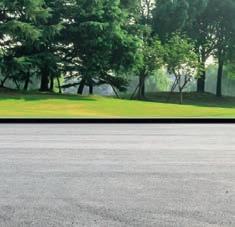









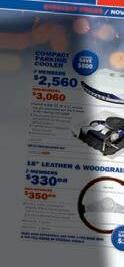



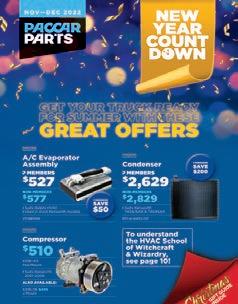















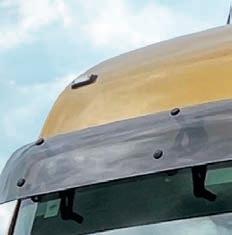
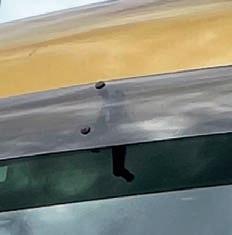



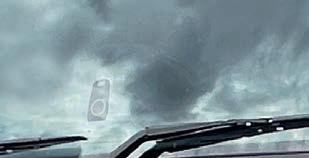
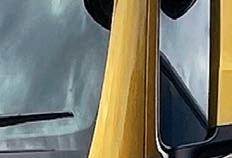







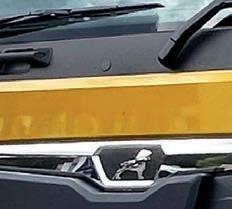




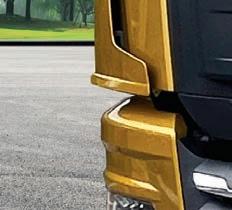
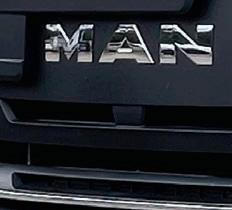
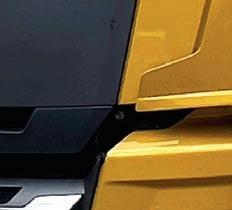
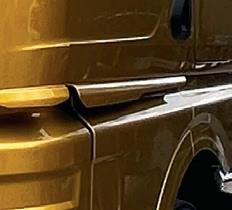
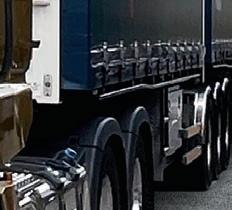




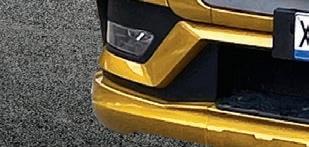
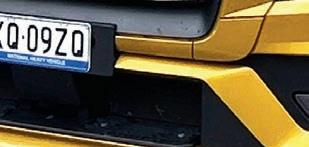
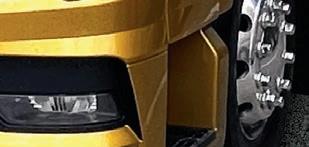



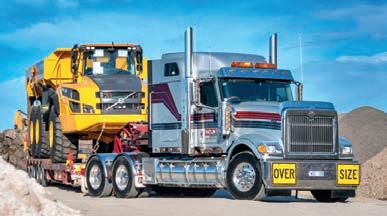
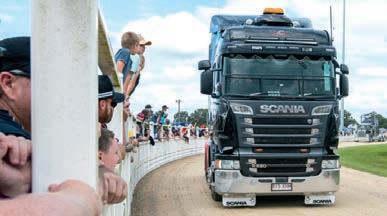













































NOV - DEC CATALOGUE & CHRISTMAS GIFT GUIDE OUT NOW! Offer ends 31st December 2022 or while stocks last. Terms and conditions apply. See Catalogue for details. DEDICATED TO THE SUCCESS OF THE PERSON BEHIND THE WHEEL OWNERDRIVER.COM.AU DECEMBER 2022 #359 $3.00 inc. GST 36 22 60 LICENCE LUNACY Competent one day, inept the next See page 18 EAGLE ROCKS International 9900i staves off retirement See page 36 REMEMBERING MATTY Gympie’s truckies raise funds for SIDS research See page 22 MAN ON A MISSION New top-of-the-range TGX 26.640 road test report

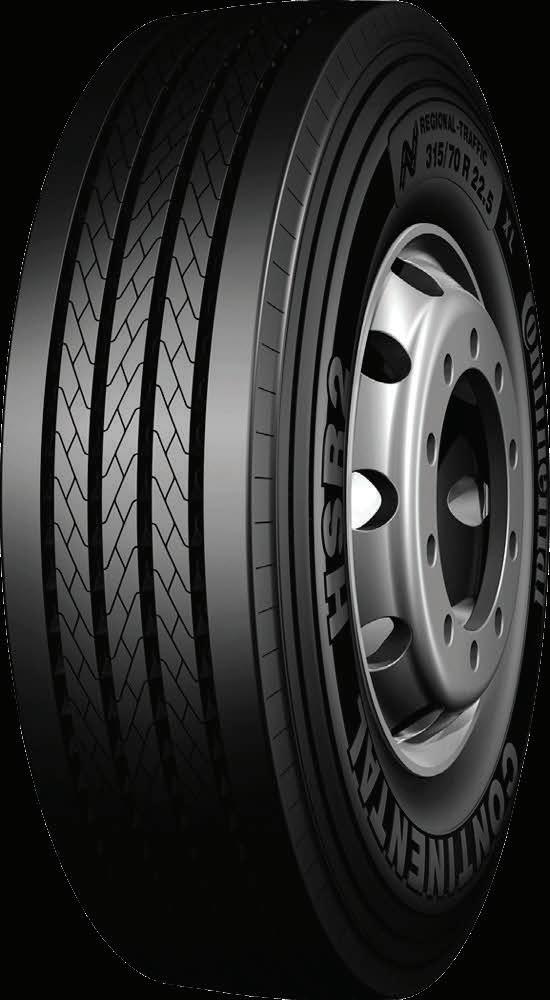

HSR2 HDR2+ www.continentaltrucktyres.com.au DISCOVER MORE: ALL 17.5" TYRES ARE MANUFACTURED IN EUROPE CONFIDENCE 150 YEARS OF
When it’s your business you need to feel confident. Trust Continental. With 150 years’ experience, we know what you need to keep you on the road.
The combination of a powerful, long-distance HID and the equivalent of a 20-inch LED lightbar in one unit provides unparalleled power and light spread. With HTX2 you get all the performance of a pair of HID spotties and two 20-inch light bars all in the one pair of lights! Plus, the HTX2 is designed to withstand the rigors of daily use and extreme cross country o roading.

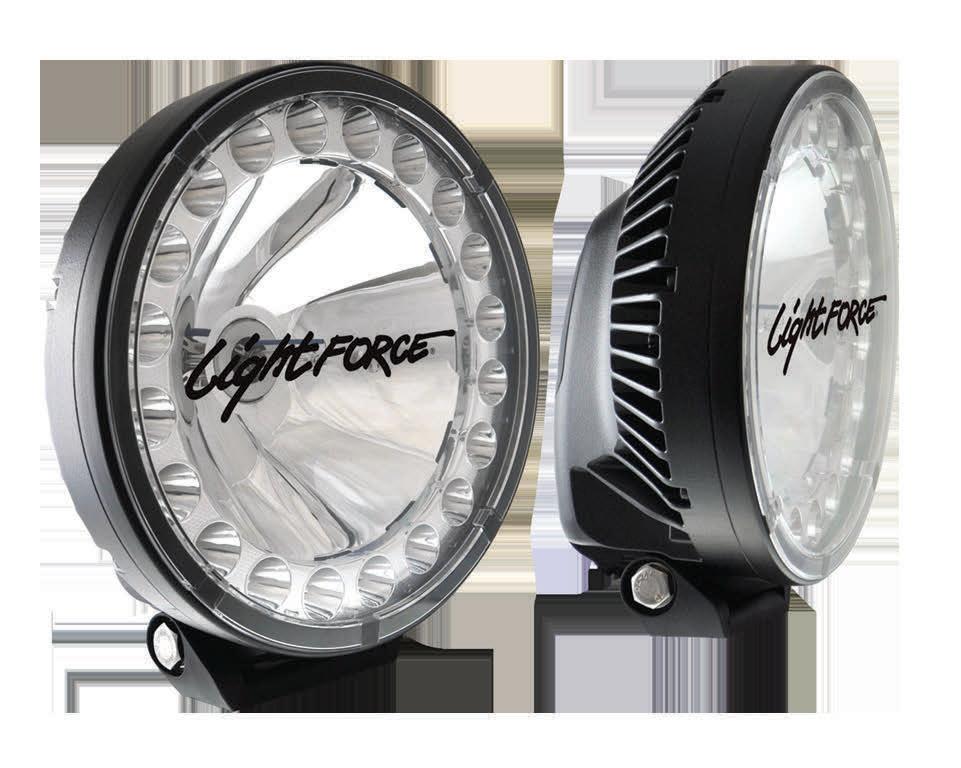

SERIOUSLY BADASS.
WHEN ONLY A REAL TRUCK WILL DO.
The most-tested Western Star ever, the all-new X-Series is seriously tough. Boasting our legendary Star durability, the X-Series features a powerful integrated driveline, advanced safety systems, and superior comfort - even in the most rugged of applications. But talk is cheap. Experience it for yourself.



ERA OF THE

























WESTERNSTAR.COM.AU
22 REMEMBERING MATTY
THE DIFFERENCE



18 LICENCE LUNACY








At a time of a shortage of experienced truck drivers, why do faceless bureaucrats contend that reaching a certain age automatically compromises competence?
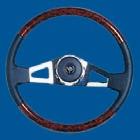
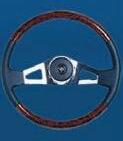


32 INDUSTRY BORN AND BRED
Hugh Paton, a recent QTA ‘Young Achiever’ winner, talks about the award, his life around trucks and his passion for the transport industry
36 PATLIN’S EAGLE ROCKS





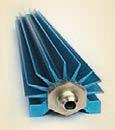
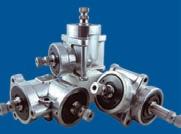

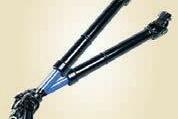



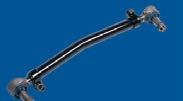

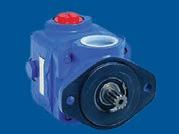

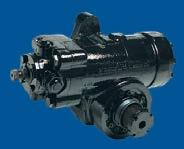

It was a break-up that had to happen as Joe Papaluca of Patlin Heavy Haulage reluctantly passed the keys of his much-loved International Eagle 9900i to young driver Jayden Perry
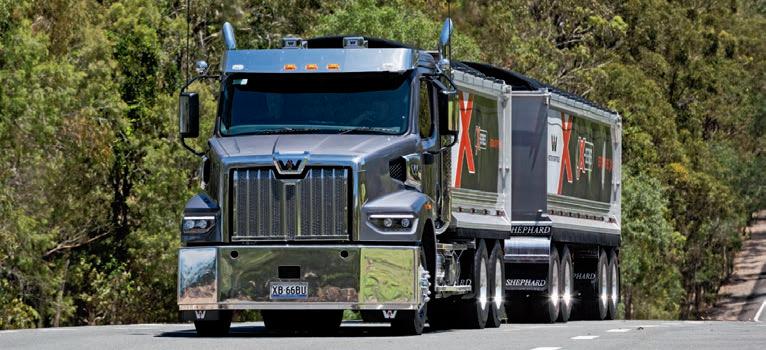
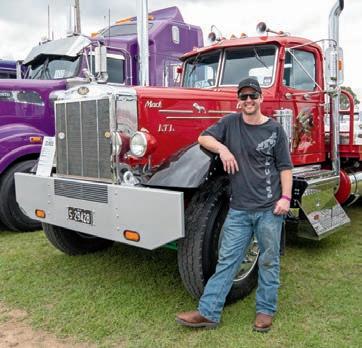
58 THE PENSKE PUSH
The last few months will likely go down as the most dynamic and perhaps definitive time in Penske Australia’s history



60 BACK IN THE GAME
The three-pronged X-series lineup of 47X, 48X and 49X models has the specification, the features and the versatility to blast Western Star into a bold new era


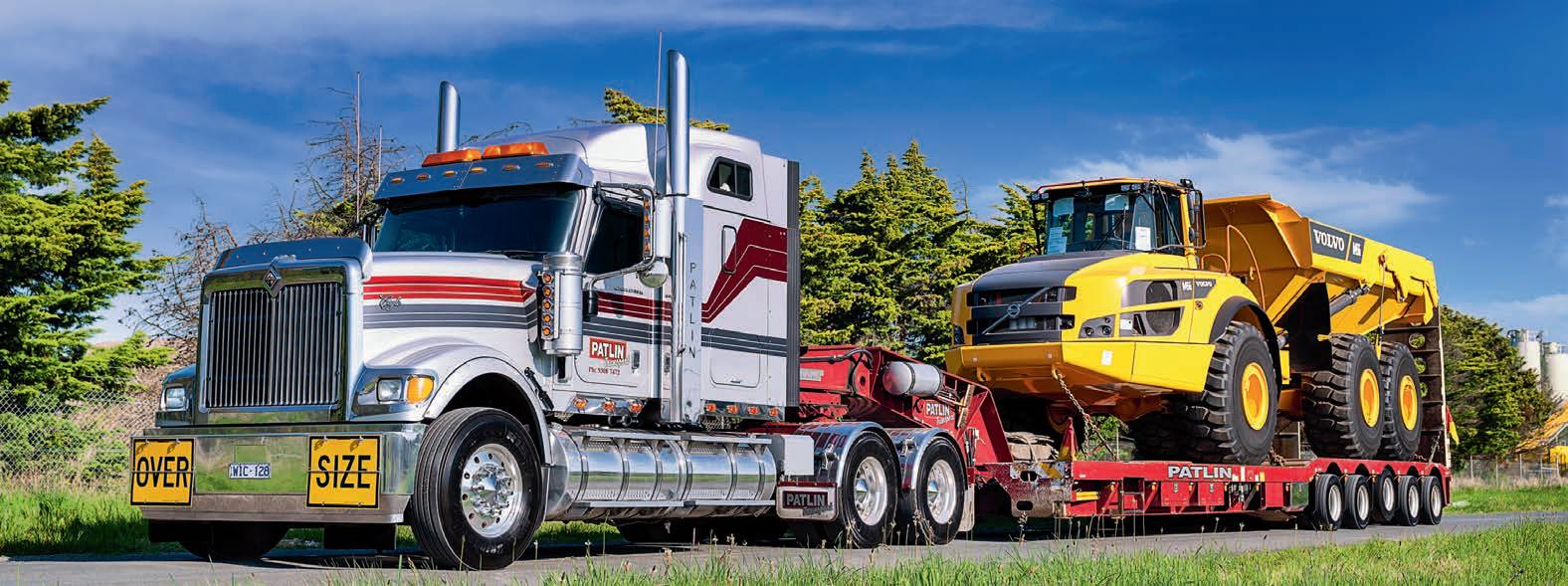
66 MAN ON A MISSION
Judging by the recent test drive performance of the top-shelf TGX 26.640 model, the big MAN from Munich is certainly ready to rumble
Contents #359 DECEMBER 2022 BRITTON ST TAITST CUMBERLANDHWY LONG ST HASSALL ST HASSALL ST GIPPS RD Truck & Bus Power Steering Specialist Repair or Replacement (new or refurbished) Steering Gears & Pumps, Drag Links, Slip Shafts, Rod Ends, Seal Kits, Coolers and MORE Drive in Drive Out Workshop* including steering system optimisation service. *Not at all locations NEW & EXCHANGE STEERING GEARS STEERING WHEELS POWER STEERING PUMPS & PARTS OIL COOLERS & ROD ENDS KITS & PARTS DRAGLINK ASSEMBLIES MITRE GEARS Locations: • Bayswater Victoria Ph. 03 9762 8855 • Laverton Victoria Ph. 03 9314 5000 • Perth WA Ph. 08 9493 5885 • Brisbane QLD Ph. 07 3555 8750 • Sydney NSW Ph. 02 9604 5693 info@hydrosteer.com.au www.hydrosteer.com.au HYDROSTEER SYDNEY IS MOVING YEAR, NEW HOME E ective January 3, 2023 NEW ADDRESS WILL BE: Unit 1 /90 Hassall St, Wetherill Park NSW 2164 Phone (02) 9604 8271 Fax (02) 9604 8271 “This
Western Star
Something
22 36 12 TRANSPORT WOMEN TO DRIVE
will
is what
should be.
it hasn’t been for a long time.”
Six women
receive scholarships under the Daimler Trucks-sponsored Transport Women Australia Driving the Difference program
The Matty Hillcoat’s Truckies Day Out brought the trucking community together to raise funds for Sudden Infant Death Syndrome research
60
6 DECEMBER 2022 ownerdriver.com.au
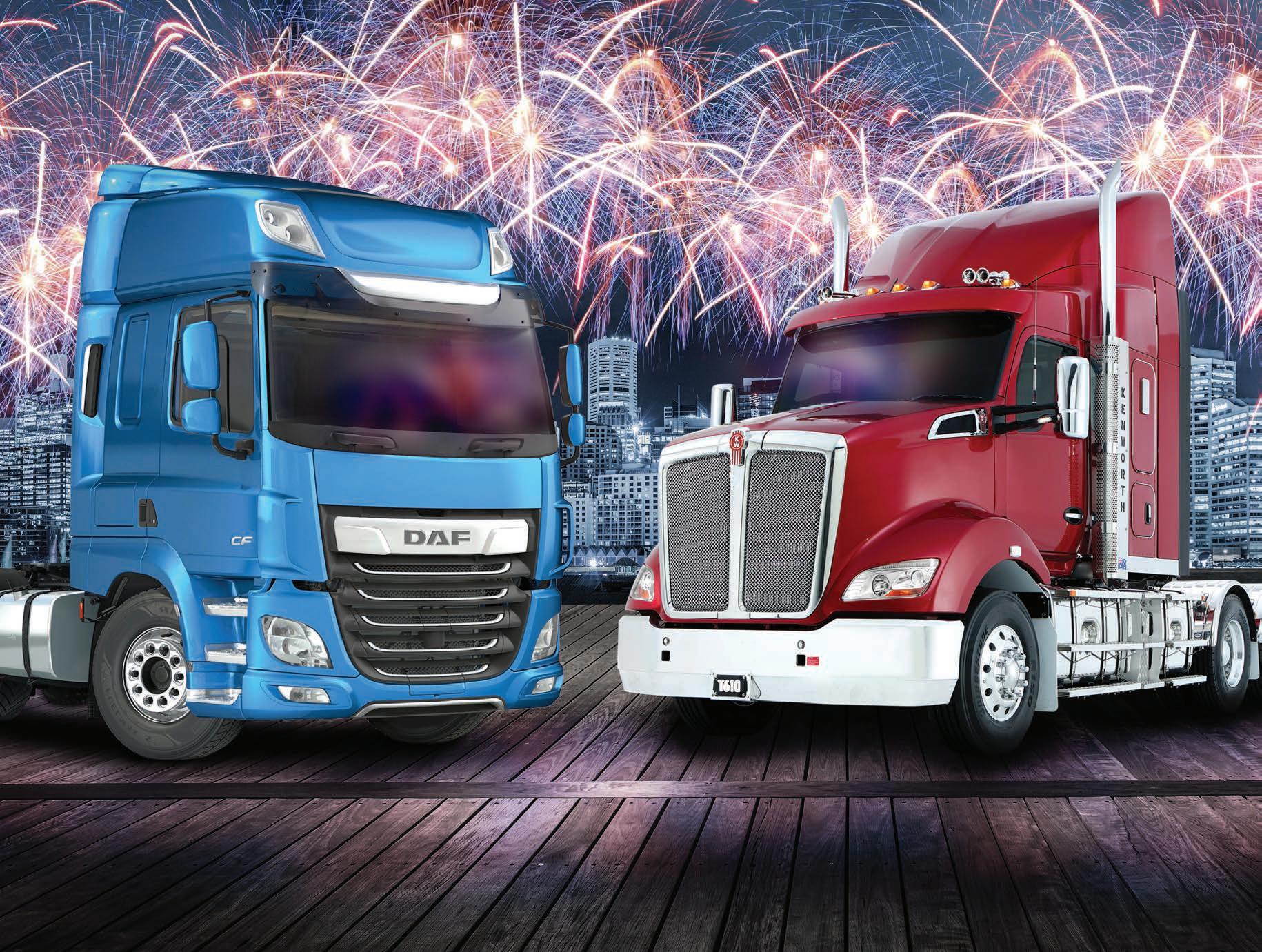



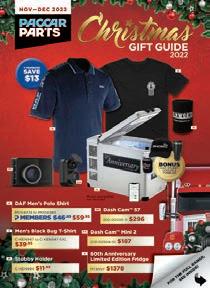

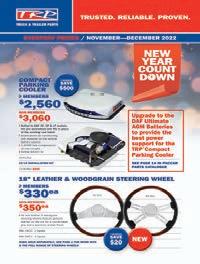
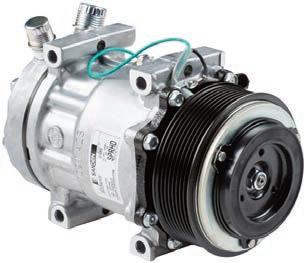

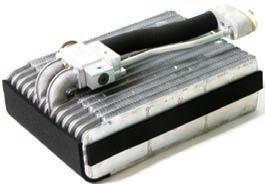






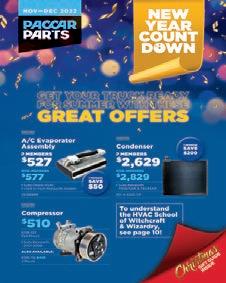







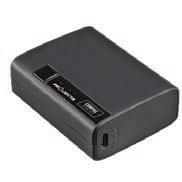



NOV-DEC 2022 CHECK THE CATALOGUE ONLINE PACCARPARTS.COM.AU/CATALOGUE Prices herein are recommended selling prices for both Privileges members and non-members, inclusive of GST. Recommended selling prices are a guide only and there is no obligation for Dealers to comply with these recommendations. Freight charges may apply. Core charges are not included in selling price however may be applied by the dealer. All items have been included in good faith on the basis that goods will be available at the time of sale. Prices and promotions are available at participating Dealers from 1 November to 31 December 2022 or while stocks last. * Calls from Australian landlines are generally free of charge whilst calls from mobile phones are typically charged based on the rate determined by the caller’s mobile service provider. Please check with your mobile service provider for call rates. We are unfortunately experiencing shipping delays which means some products may not be in store on the advertised on-sale date. We are trying our best to limit these delays and at the time of publishing, advertised product sale dates are correct; however, they are subject to change due to factors outside our control. Compressor MEMBERS $ 499ea NON-MEMBERS $549ea F69-1006-211 Used on most Conventional & Cab Over Kenworth models F69-1020 Used on Kenworth models; T610 & T610SAR F69-1006-211 $50 MEMBERS SAVE Air Distribution Unit MEMBERS $717 NON-MEMBERS $767 I Used on most Kenworth Models 25189006 $50 MEMBERS SAVE A/C Evaporator Assembly MEMBERS $527 NON-MEMBERS $577 I Suits Delphi HVAC I Used in most Kenworth models 25188998 $50 MEMBERS SAVE CHARGE AIR COOLER FROM $1,895 I Australian design & manufactured for Australian conditions I Unique silicone grommet system provides leak free operation & extended service life I Greater vibration & load handling, eliminating premature failures TRP1504392-1 $1,895 Suits T350/T359/T401/T601 SEE IN STORE FOR COMPLETE RANGE TRP1504392-1 NEW EVAPORATOR CORE $214 I Suits most 2010 - current Kenworth models S31-TP-1000 NEW STEEL JACKET BRAKE DRUMS FROM $167 I 285 PCD, 10 Stud DB017TRP $142 $167 16.5” x 7” NEW 5” Light Weight Steel Brake Drum DB020TRP $175 16.5” x 5” Steer DB017TRP RECEIVER DRYER MEMBERS $39.95 NON-MEMBERS $44.95 I Manufactured using OE materials & dimensions I Does not require installation modifications I Spring-loaded design that keeps desiccant under constant pressure GD11350 Suits Kenworth models 2002 onwards $5 MEMBERS SAVE BONUS CAP, STUBBY COOLER & TUMBLER GENUINE MERCHANDISE C Men’s Black / Red Puffer Vest C-KEN894 to C-KEN894-5XL $89.50 A Cordless Soldering Iron Kit 56394 $139 B Rapid Charge Power Bank PB10 $79 D Dash Cam™ Mini 2 010-02504-10 $187 E Dash Cam™ M57 010-02505-11 $296 F 60 th Anniversary Limited Edition Fridge MT45SY $1378 Bonus 60th Anniversary Cap, Stubby Cooler and Tumbler A B C D E F DEALERS AUSTRALIA WIDE | Visit us paccarparts.com.au For more details, Freecall* 1800 PPARTS (772 787) 57
Bring on the new year
s 2021 comes to an end, the unrelenting weather patterns are causing havoc with road transport as flash floods impact highways and other major arterial roads. Couple that with new COVID variants affecting workforce participation and you have a panic station situation added to the usual pre-Christmas rush.
All roads lead back to the muchpublicised driver shortage. The Federal Government seems keen on helping out by enticing more workers from around the globe to fill the void. Of course this will only work out if these newbies receive the correct training.
There’s also a big push for more women to get behind the wheel. That appears to be working well over in the north of Western Australia where the ‘heavy haulage girls’ are proving to be a godsend.
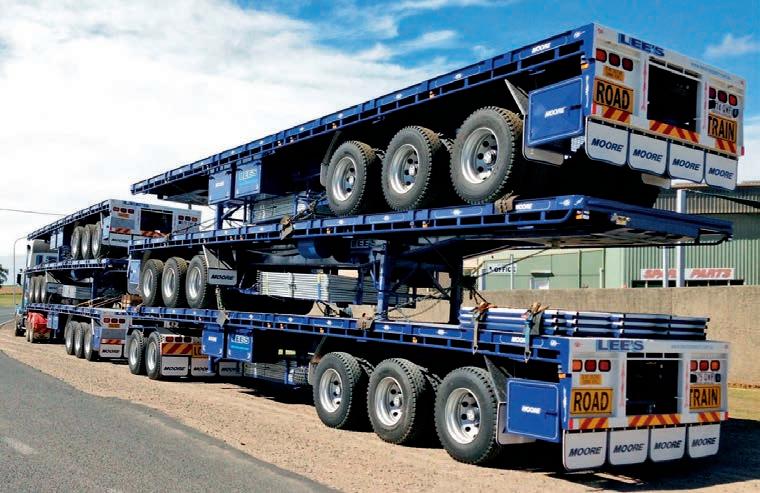
Transport Women Australia, teaming up with Daimler Trucks, are also doing their bit by offering scholarships to their Driving The Difference program. It’s not just for truck driving through – there’s also a shortage in the various technical vocations within the heavy vehicle industry.
As I’ve mentioned previously, there are some aspects of the road transport industry that need changing in a bid to entice younger drivers into trucking. Truck manufacturers have come to the party with safer trucks, the National Heavy Vehicle Regulator is doing its best to bring the eastern states under one banner.
Despite this, reports of a small number of overzealous roadside authorities, keen on making an example of truck drivers for minor blemishes, is a major deterrent for trucking companies in their efforts to attract new blood.





For owner-drivers and small fleet operators, one issue that has brought a breath of fresh air is the recent introduction of the unfair contracts legislation. These changes will offer protections to small businesses which employ less than 100
people or have an annual turnover of less than $10 million.


However, it will be 12 months before the new laws come into effect. But it’s better late than not at all.

After that, it should bring about an end to the ‘take it or leave it’ deals where small operators can have their existing contracts ended within a month’s notice.
The ACCC is threatening companies with fines of $50 million for some conduct.
Hopefully this will also remove the 90-day payment terms that big corporations force onto small operators. It seems the bigger the business, the more reluctant they are to pay within a reasonable time.
Here’s hoping the road transport industry undertakes more positive changes in 2023.

From everyone at OwnerDriver, all the best for Christmas and the New Year.
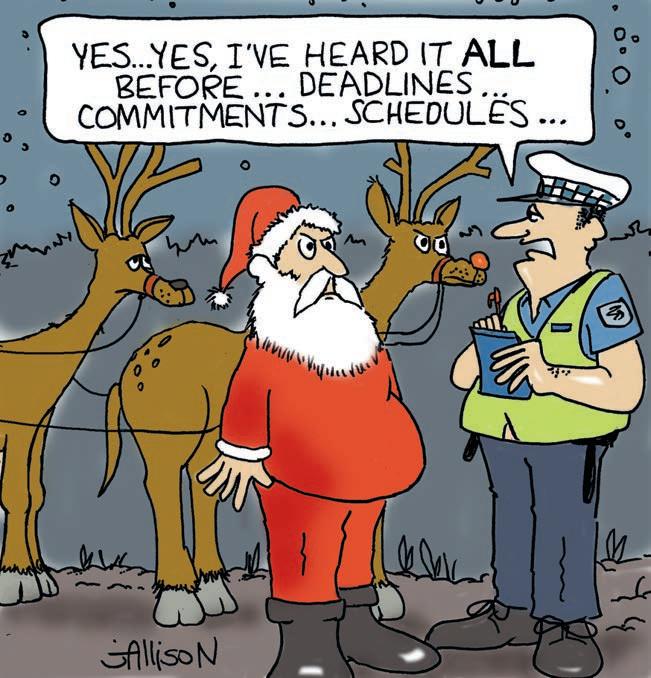

8 DECEMBER 2022 ownerdriver.com.au 07 4693 1088 www.mooretrailers.com.au TRAILERS MOORE Moore trailer for your money! BEHIND THE WHEEL Greg Bush OwnerDriver magazine is owned by Prime Creative Media. All material in OwnerDriver is copyright and no part may be reproduced or copied in any form or by any means (graphic, electronic or mechanical including information and retrieval systems) without written permission of the publisher. The Editor welcomes contributions but reserves the right to accept or reject any material. While every effort has been made to ensure the accuracy of information Prime Creative Media will not accept responsibility for errors or omissions or for any consequences arising from reliance on information published. Opinions expressed in OwnerDriver are not necessarily the opinions of, or endorsed by the publisher unless otherwise stated. EDITORIAL Editor Greg Bush Ph 0408 780 302 E-mail Greg.Bush@primecreative.com.au Journalist Julian Daw E-mail Julian.Daw@primecreative.com.au Technical Editor Steve Brooks E-mail sbrooks.trucktalk@gmail.com Contributors Warren Aitken, Polly Antees, Frank Black, Warren Clark, Rod Hannifey, Michael Kaine, Rob McDonald, Sarah Marinovic, Sal Petroccitto, Sally Tipping, Ken Wilkie Cartoonist John Allison PRODUCTION Art Director Bea Barthelson Print IVE Print ADVERTISING Business Development Manager James Phipps Ph 0466 005 715 E-mail James.Phipps@primecreative.com.au SUBSCRIPTIONS www.ownerdriver.com.au/subscribe Phone +61 (0)3 9690 8766 Mon-Fri 8am-4.30pm (EST) Email subscriptions@primecreative.com.au Mail 379 Docklands Drive, Docklands, VIC 3008 Australia EXECUTIVE GROUP CEO John Murphy COO Christine Clancy Operations Manager Regina Fellner Trader Group Sales Director Brad Buchanan Owner Driver is published by Prime Creative Media 379 Docklands Drive, Docklands Melbourne VIC 3008 Telephone: (+61) 03 9690 8766 www.primecreative.com.au ISSN 1321-6279 A


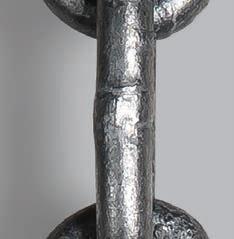




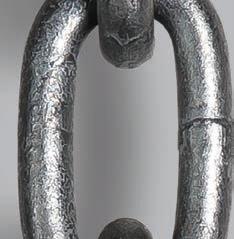




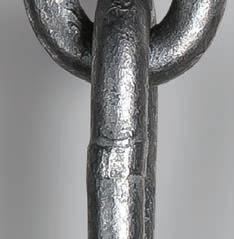
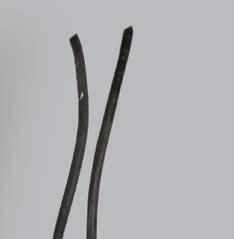



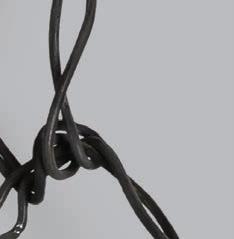












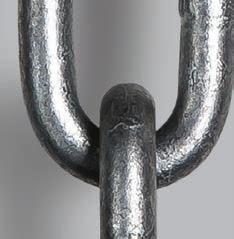




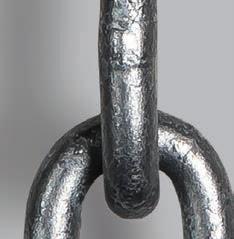



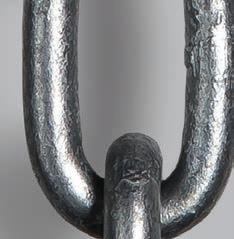




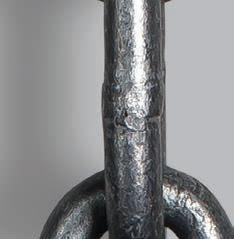






Would you trust your livelihood to a replacement part that isn’t backed by Isuzu?
keep your truck performing at its best, only trust Isuzu-backed parts, which include Isuzu Genuine Parts, Isuzu Best Value Parts & Isuzu Approved Parts. FSA/ISZS1080
To
The Goods
NHVR releases PBS discussion paper
The National Heavy Vehicle Regulator is calling for industry input into shaping the future of the PBS scheme
The National Heavy Vehicle Regulator (NHVR) has released a Discussion Paper seeking industry input to help shape the future of the Performance Based Standards (PBS) scheme – ensuring it continues to lead and promote innovation in the Australian heavy vehicle industry.
NHVR CEO Sal Petroccitto says
the Performance Based Standards
2.0 Discussion Paper primarily focuses on opportunities to reduce regulatory, administrative and cost barriers for industry and promote innovative approaches to heavy vehicle safety and productivity.
“The PBS scheme, which now has more than 15,400
combinations operating across the country, has played a significant role in transforming road freight transport in Australia,” Petroccitto says.
“The scheme puts safer, more productive vehicles on our roads –allowing more freight to be moved in a safe way with fewer truck movements.
“As the freight task keeps growing and we continue to be challenged by driver shortages, it is essential that we do everything we can to improve accessibility to safer and more productive heavy vehicles and encourage innovative approaches to move goods.
“The Discussion Paper has a strong focus on working with road managers to open up increased access for PBS vehicles, so they can operate on the same networks as their conventional equivalents, provide certainty of access for these vehicles, and eliminate the need for permits.
“It also provides a pathway for PBS vehicles to exit the PBS scheme into the ‘as-of-right’ fleet, as we have recently delivered through the National Class 3 20m Long 3-axle Truck and 4-axle Dog Trailer Mass and Dimension Exemption Notice.”

Federal Government tops up rest area funding
Assistant Minister for Infrastructure and Transport, Carol Brown, has confirmed that the Albanese will deliver on its commitment to truckies through an $80 million commitment to new and refreshed rest areas.
The funding is in addition to the $60 million already set aside to fund rest areas and supplements the existing Heavy Vehicle Safety and Productivity Program funding.
Brown says the $80 million commitment the Labor Party took to the election brings the total commitment in dedicated funding for heavy vehicle rest areas to $140 million.
“In delivering the Rest Area Program, the Government will be working side by side with truckies and industry experts to deliver a suite of heavy vehicle rest areas across the country,” Brown advises.
“Truckies will be at the table, providing their expert advice for the targeted rest area projects.
“On top of this, the Government has committed $12.4 billion to infrastructure this financial year and $55.1 billion dollars over the next four financial years.”
Brown says the funding the Government has committed to through the budget will include
upgrades to freight routes heavily used by truck drivers across the country –from the Bruce Highway in Queensland, through to the Bass Highway in her home state of Tasmania.
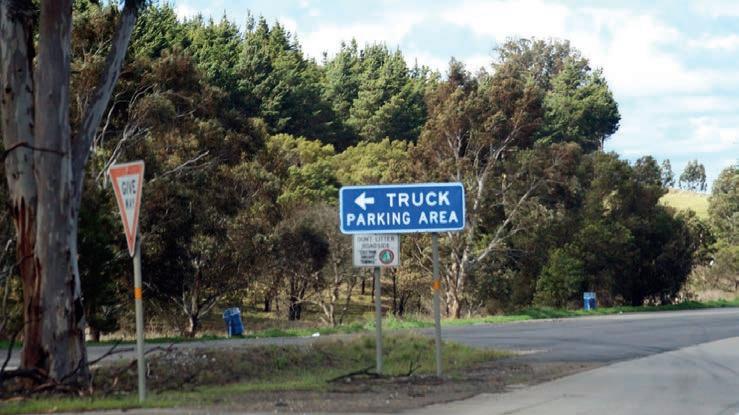
“We’re continuing to invest in the Roads of Strategic Importance (ROSI) initiative which supports the upgrade of key freight routes, and to help connect regional businesses to local and international markets, and better connect regional communities,” she adds.
“The ROSI initiative is ensuring our key freight roads efficiently connect areas of regional and remote economic activity to ports, airports and other transport hubs.
“ROSI is delivering works such as road sealing, flood immunity, strengthening
and widening, pavement rehabilitation, bridge and culvert upgrades and road realignments.
“We know that the improved access provided through the ROSI initiative is making work easier and, importantly, safer for truckies by improving freight routes you travel often.”
Brown says the Albanese Labor Government has also committed $65 million per year through the Heavy Vehicle Safety and Productivity Program. The Program provides funding for projects which work to make the most utilised freight routes safer for truckies, and other road users.
The NHVR’s preferred option presented in the PBS 2.0 Discussion Paper comprises three key components that will:
• ensure PBS vehicles remain at the forefront of innovation through the dynamic management of PBS Standards
• c reate a ‘lifecycle’ for a PBS vehicle from initial concept through to exit from the PBS scheme for common and mature design concepts
• e xpedite end-to-end approval processes through opportunities for third parties – such as, assessors, certifiers and manufacturers – to support delivery of regulatory functions.
“The Discussion Paper provides a comprehensive review of the PBS scheme and is designed to be a consultative process. We know there is a lot to consider, so we’ll be holding a series of webinars in early 2023 to provide the chance to discuss your views and provide feedback,” Petroccitto says.
“The work undertaken through PBS 2.0 will inform the Review of the Heavy Vehicle National Law.”
To read the Discussion Paper, register for a webinar or find out how to submit your views, visit http://www.nhvr.gov.au/pbs2-0 and submit a written submission before February 17, 2023.
10 DECEMBER 2022 ownerdriver.com.au
NEWS
FROM THE HIGHWAY AND BEYOND
Welcome protection for WA subbies
•
•
•
•
•
Owner-Drivers Amendment Bill 2022
The Owner-Drivers (Contracts and Disputes) Amendment Bill 2022 has passed Western Australia’s Parliament, which is said to provide additional protections for small business and independent contractors in the road freight transport industry.
The amendments claim to enhance operational efficiency, safety and regulation of dealings between owner-drivers and hirers, providing benefits for all road users across the road transport network.
The changes to Owner-Drivers (Contracts and Disputes) Act 2007 (the Act) are said to be the result of years of work and extensive consultation with the Road Freight Transport Industry Council and Road Freight Industry Tribunal.
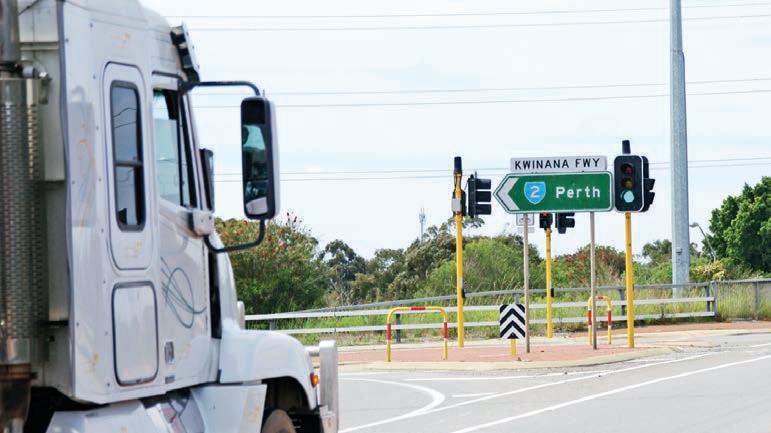

“As owner-drivers play a key role in enabling the efficient and safe movement of freight across WA, changes to the Act will help provide more protections to small business and contractors in the industry,” says Rita Saffioti, the state minister for transport.
“It is important there are sufficient and appropriate safeguards and



protections for those small business operators and better avenues for dispute resolution between owner-drivers and hirers through improved administration of the Act and Tribunal proceedings.”






The Department of Transport (DoT) says it will be working alongside industry to implement updated changes, which include the below:
• contracts greater than three months will have a 90-day minimum notice

is



to contribute to more sustainable operations across the WA road freight transport industry



Council publish “guideline rates” to inform industry participants when they bargain rates of pay.




Non-compliance with guideline rates will be a factor relevant when the Road Freight Transport Industry Tribunal determines whether there has been unconscionable conduct; and • changes to the Tribunal’s powers and jurisdiction to ensure they are better equipped to deliver just and efficient outcomes in dispute resolution.
DoT will work with industry to prepare for the implementation of the changes which will come into effect in the first half of 2023.
period and contracts less than three months a 7-day minimum notice period

• workplace right of entry for an owner-driver’s authorised representative for the purpose of investigating suspected breaches of the Act
• discrimination will be a form of unconscionable conduct under the Act
• the Road Freight Transport Industry




“The Bill helps simplify and enhance the day-to-day operations of the WA Owner-Drivers laws and contributes to safer and more sustainable operations across the WA road freight transport industry in years to come,” Minister Saffioti says.
“Industry will continue to be consulted with in the coming months to ensure they are ready for the changes that will come into effect in the first half of 2023.”
SUPERCOIL FEATURES

Accelerated Testing to ISO 4982-2)










• 40% lighter than traditional Type B Suzi-Coils




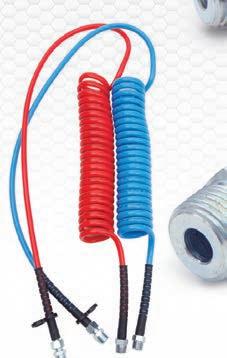

• High elasticity with excellent flexibility and recoil memory.






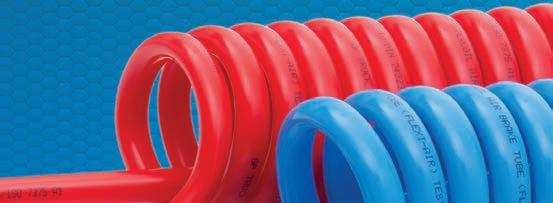
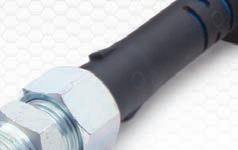


Part#

DECEMBER 2022 11 ownerdriver.com.au GP TRUCK PRODUCTS available from Truck & Trailer parts outlets Australia wide. Compliant Standards: ADR-38/05 & DOT Phone +61
9580 1811 sales@gptruckproducts.com.au www.gptruckproducts.com.au UNCOMPROMISING PERFORMANCE ANTI KINK SUZI-COIL POGO STICK & TECCLAMP COMBOS Part# GP-925-C Chromed steel heavy duty Pogo Stick Part# GP-925-C3 Chromed Pogo Stick with 3 hole Tec-Clamp Part# GP-925-C4 Chromed Pogo Stick with 4 hole Tec-Clamp TEC-CLAMP SUZI-COIL CLAMP The new 4 hole TEC-CLAMP allows you to lock in your lines and go! No tools or hardware needed for fast, easy installations! Versatile design can be used with both rubber air hose or coiled tubing hook-ups. GP-9888 3 hole NEW 4 hole Part# GP-9889 GP AIR COUPLINGS TRUCK & TRAILER Huge range of Air Couplings & Adaptors to suit your truck or trailer. GP Air Couplings & Adaptors are designed & manufactured to conform to the Australian Design Rules ADR-38/05, Australian Standards AS4001.3-2003. Couplings - Male, Female, Sealing & Non sealing. Adaptors - Male, Female, Sealing & Non sealing. Dust covers, Adaptor plates, Trailer coupling locks Part# GP-7750 Long Tail Coil Part# GP-7000 Short Tail Coil SUPERCOIL Compact 74mm diameter coil Regular Suzi-Coil 130mm Diameter
3
Compliant Standards: ADR-38/05, Tested to DIN 74323, 74324 & ISO 7375 A1
Anti Kink Thermoplastic Polyurethane material
Excellent abrasion resistance
Excellent mechanical properties, combined with a rubber-like elasticity
and Diesel
Oil
resistance
(>4000
High UV resistance
hours of
expected
Transport women to drive the difference
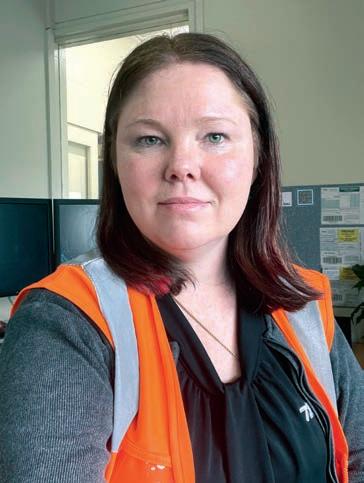
Six women to receive scholarships under the Daimler Trucks-sponsored Transport Women Australia Driving the Difference program
Transport Women Australia Limited (TWAL) has announced the scholarship winners for Daimler Truck Australia Pacificsponsored Driving the Difference scholarship winners for 2022.
TWAL says it is proud to provide this opportunity every year to women in the transport and logistics industry who want to advance their career within the industry or to enter our industry.
The program is in its fourth year and TWAL says each year the applications become harder to choose. It says not only has the quality been extremely high but the range of courses selected by the candidates in 2022 has been the most varied since the inception of the scholarships.
TWAL says this year was the hardest year of judging that it has had so far, and adds that it is always disappointing that awards cannot be given to everyone.
However, TWAL says it has chosen six very worthy candidates
Call for LBRCA young drivers nominees

who will be presented with their certificates at end of year functions in the city closest to them.
The successful applicants are:
• Ainsleigh Bilato, Adelaide
• Brooke Tran, Perth
• Ellen Tandy, Forbes
• Nichole Speers, Wollongong


• Joana Feiteira, Sydney, and
• Sally-Ann Eather, Sydney.
The TWAL says all the candidates provided outstanding applications and courses that will assist them in advancing within the industry and contribute to the future of all women as leaders.
TWAL and Daimler are very proud to support women as female participation continues to grow in the road transport.
Leadership skills and careers are enhanced by programs such as these, and the opportunity that the scholarship provides. The
Driving the Difference scholarship means that those successful applicants can undertake a course
of study that might otherwise be out of their reach.
TWAL encourages everyone who can apply for these scholarships to do so in 2023 when they become available.
Livestock, Bulk & Rural
Association (LBRCA) president Wade Lewis has announced that the association is seeking nominations for young driver of the year for 2023.
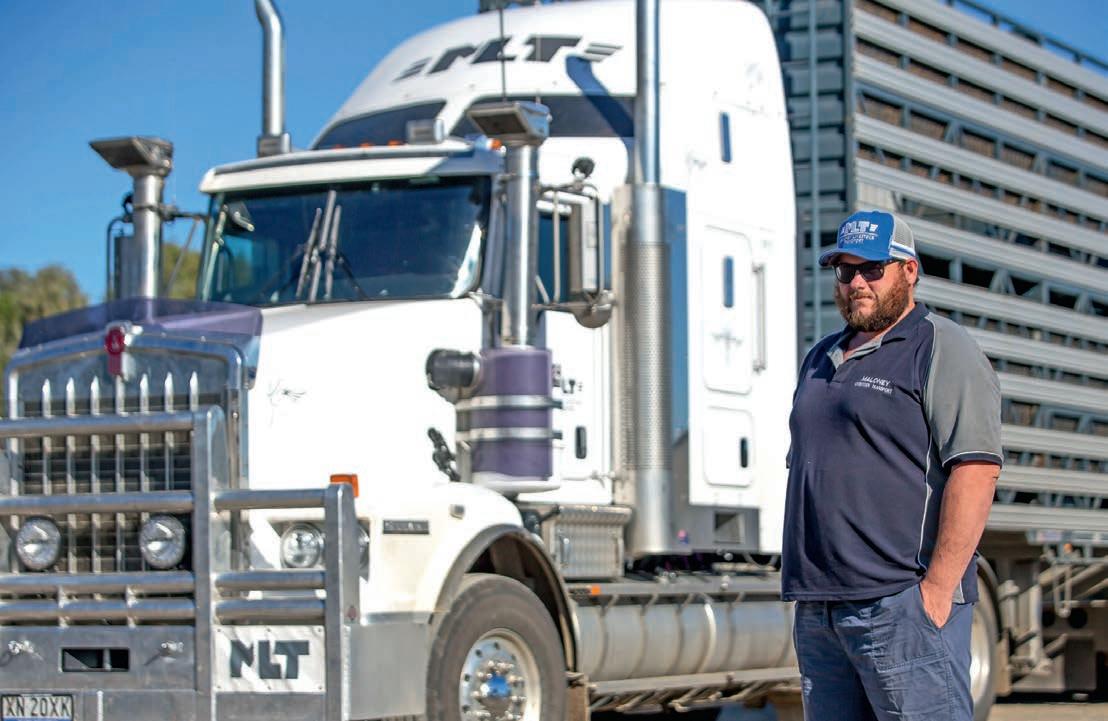
Nominations are open until January 20, 2023. The award will be presented at the Annual LBRCA Conference, to be held in Tamworth on March 10 to 11.
“The young driver award recognises our top young drivers and showcases their commitment to safety and best practice,” Lewis says.
“We’re looking for young talented individuals who are making a difference in the road transport industry.
“The award winner must demonstrate a best practice approach to driving and safety and will be rewarded with a

$5,000 study tour to the United States, New Zealand, or Western Australia,” Lewis adds.
Nominees must be aged 35 years or under (as of December 31, 2022) and must be an LBRCA member or an employee of an LBRCA member.
12 DECEMBER 2022 ownerdriver.com.au
Above: Joana Feiteira of Sydney is one of six Driving the Difference scholarship winners
Below: Nichole Speers from Wollongong is one of two regional NSW scholarship recipients
THE GOODS NEWS FROM THE HIGHWAY AND BEYOND
Bottom: Elle Tandy from Forbes, NSW
Carriers
Above: Matt Benseman was a LBRCA Young Driver Award winner in 2021
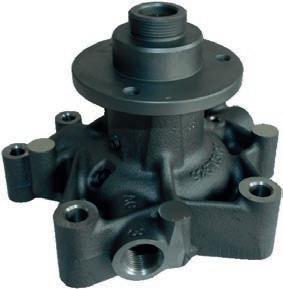
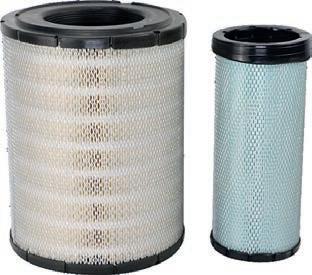
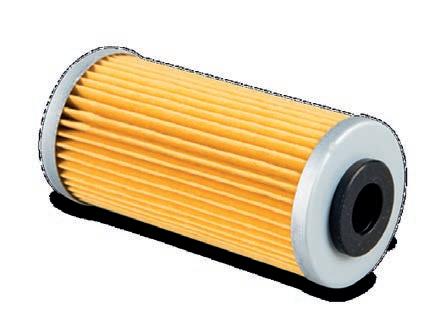


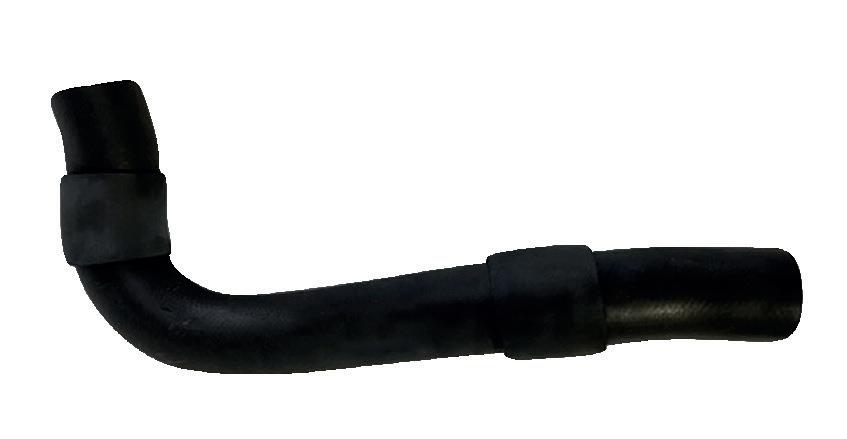


Offers available 1st December 2022 to 28th February 2023 �The�offers�presented�are�subject� to stock�availability�during� the�promotion�period�and�are�available�at�Daimler� Trucks�participating�dealerships�only.�Participation�can�be�determined� by�calling�1800�033�557�or� by calling�your�nearest�dealership.�Parts�listed�may�be�VIN�specific,�parts�advertised�have�been�identified�to�suit�the�majority�of�the�models�specified.�Part�numbers�should�be�checked�against�the�VIN�to�ensure�suitability.� For�assistance,�please�contact�your�nearest�participating�Daimler� Trucks�dealership�prior� to�purchase.�Prices�within�this�promotion�are�recommended�maximum�selling�prices�including� GST,�excluding�labour�and� fitment�costs� from�a�participating�dealer.�Prices�will�be�valid�during� the�promotion�period�stipulated�at� the�front�of�this�catalogue.�All�items� have�been�included�in�good�faith�on� the�basis�that� they�will�be�available� during�the�promotion�period.�Photographs�are�for�illustrative�purposes�only�and�may not�represent�actual�products.�We�reserve�the�right�to�correct�all�printing�errors.�Freightliner�and�Alliance�Truck�Parts�are�registered� trademarks�of�Daimler�Trucks North�America�LLC,�all�distributed�by�Daimler�Truck�Australia�Pacific�Pty�Ltd.�ABN�86�618�413�282. Air Filter - Inner Element Water Pump QME160952 • Suits: Shogun/ Heavy FV51J, FV54J QMK667228 • Suits: Canter FEA21, FEA61, FEB21, FEB51, FEB71, FEC71, FEC81, FEC91, FECX1, FGB71 $54.85 $423.75 Radiator Hose QMK523507 • Suits: Rosa BE64D $86.20 Fuel Filter Fan Belt Windsheild Wiper Rubber QQY012200 • Suits: Heavy/Shogun: FP547, FS527, FV517, FV547 QME360569 • Suits: Heavy/Shogun: FV51J, FV54J $96.10 $53.95 $11.35
New station a welcome resource
Rod Hannifey is no stranger to long hauls behind the wheel of truck bringing freight from state to state across Australia. Over the years, Hannifey says he has found music, radio shows, and more recently, audiobooks, have provided welcome company while driving, keeping his mind active and broadening his interests.
He recalls a time when there was really only the ABC, and as he’d pass through each country town he’d find the local version to hear what’s going on around him. There was also a comedy show at about 3am every morning he would tune in for, to have a laugh as dawn edged ever closer.
“We can be away for four, five or six days a week and we’re not in contact with a lot of other people really,” he says.
Asked about the recently launched Australian Truck Radio, Hannifey says having a national station designed specifically to cater for the needs and tastes of Australia’s truck drivers was a great idea and sure to be popular.
He said carrying content relevant to truck drivers and the industry throughout the entire day would mean drivers working the day shift would also have the opportunity to hear what’s going on in their industry – where previously they missed out as any truck-focused radio shows tended to find air-time
VALE STEVE STURGESS
from midnight to dawn.
And having it available via the internet, across borders, was another bonus for drivers who would be able to tune in from one end of the country to the other and enjoy the continuity of content, he says, reflecting on a time when he used to listen to radio serials but would miss multiple episodes as he crossed the borders out of the range of the stations that ran them.
As a correspondent for several road transport magazines in Australia and New Zealand over many decades, high profile US trucking writer Steve Sturgess was a constant source of detailed and often groundbreaking reports on the North American trucking industry. Steve Brooks recalls the passing of a friend and valued colleague
Steve Sturgess was certainly one of a kind. The old adage ‘they don’t make ’em like that anymore’ would, in many ways, be a fitting epitaph for the man whose smiling presence and quick-witted conversation hid a deep and determined approach to uncovering the latest developments in North American trucking hardware and performance.
From the highest offices of massive fleets to the executive corridors of some of the world’s best known truck and component brands, and possessing a deft hand at the wheel of any truck, Steve’s ability to deliver accurate and authoritative reports on the people and products of the North
American road transport industry had few peers.
Born in England and discovering early a passion for automotive pursuits, it was his eventual move to the US where Steve forged the platform for a long and auspicious career in truck reporting.
He became, without question, one of the best known and most experienced writers on happenings within the North American trucking scene. With a naturally enquiring mind and inherent understanding of sometimes complex engineering developments, his association and camaraderie with a couple of Australian and New Zealand editors made Steve Sturgess an ideal ally and valuable correspondent.
“I carry fruit and nut mix in the truck to stimulate my body and give me energy, and it’s the same thing with the radio – only it’s for the mind,” Hannifey says.
Australian Truck Radio’s Simon Smith says the station has had sensational support from the Australian Trucking Industry over the past couple of months.
“Australian Truck Radio is all about

the people who move the Nation 24/7 –a huge mobile community,” Smith says.
“Truckies, we know, love something to listen to on the road, and are looking for great music, along with industry news and information to keep them up to date and entertained while on the road.
“At Australian Truck Radio, we know we have to be listener responsive to make sure we deliver the goods for our valued listeners around Australia.
“Radio is never `set and forget’ and we want the valuable opinions of drivers, to make sure our programming reflects exactly what they want to hear on their Trucking Radio Station - 24/7.
“We listen to you, so you will listen to us,” Smith says.
On the feedback front, Australian Truck Radio is contactable via the Australian Truck Radio Facebook page or its website at www.australiantruckradio.com.au
He genuinely liked Australia and New Zealand and often expressed considerable regard for the character and initiative of trucking in our part of the world.
Always cheerful and thoughtful, Steve passed away recently from a progressive illness and his long contribution to Australian and New Zealand trucking media will be sorely missed.

He was, above all, a good bloke.
“So, if you have a favourite song you want to hear, maybe a birthday coming up or you’re celebrating an anniversary while on the road, drop us a line and let us know anytime,” Smith says. “We will get it on the air!”
He says the station is continuing to evolve and drivers should listen out as Christmas neared for the Truckies Top 500 countdown, competitions, giveaways and plenty of industry news.
“So, if you have a ‘Trucking Classic’ you want to hear let us know,” Smith says. “There’s lots more to do, but together, we will keep Trucking 24/7.”
14 DECEMBER 2022 ownerdriver.com.au
Long term truck driver, safety advocate and current president of the National Road Freighters Association Rod Hannifey has plenty of good things to say about a radio station created just for truck drivers
THE GOODS NEWS FROM THE HIGHWAY AND BEYOND
Late night long haul: time to switch on Australian Truck Radio.
Photo by Steve Skinner


YOU DESERVE A SMOOTHER, BETTER BUSINESS WITH CALTEX
At Caltex, we are committed to providing the most advanced premium industrial lubrication technologies available for every kind of operation - from mining to agriculture, power generation to construction, trucking to global marine.
No matter what challenges you might face, the journey will be Smoother, Better, Together with Caltex.
Talk to your local distributor or find out more about Caltex fuels and lubricants.
www.caltex.com/au/business-solutions
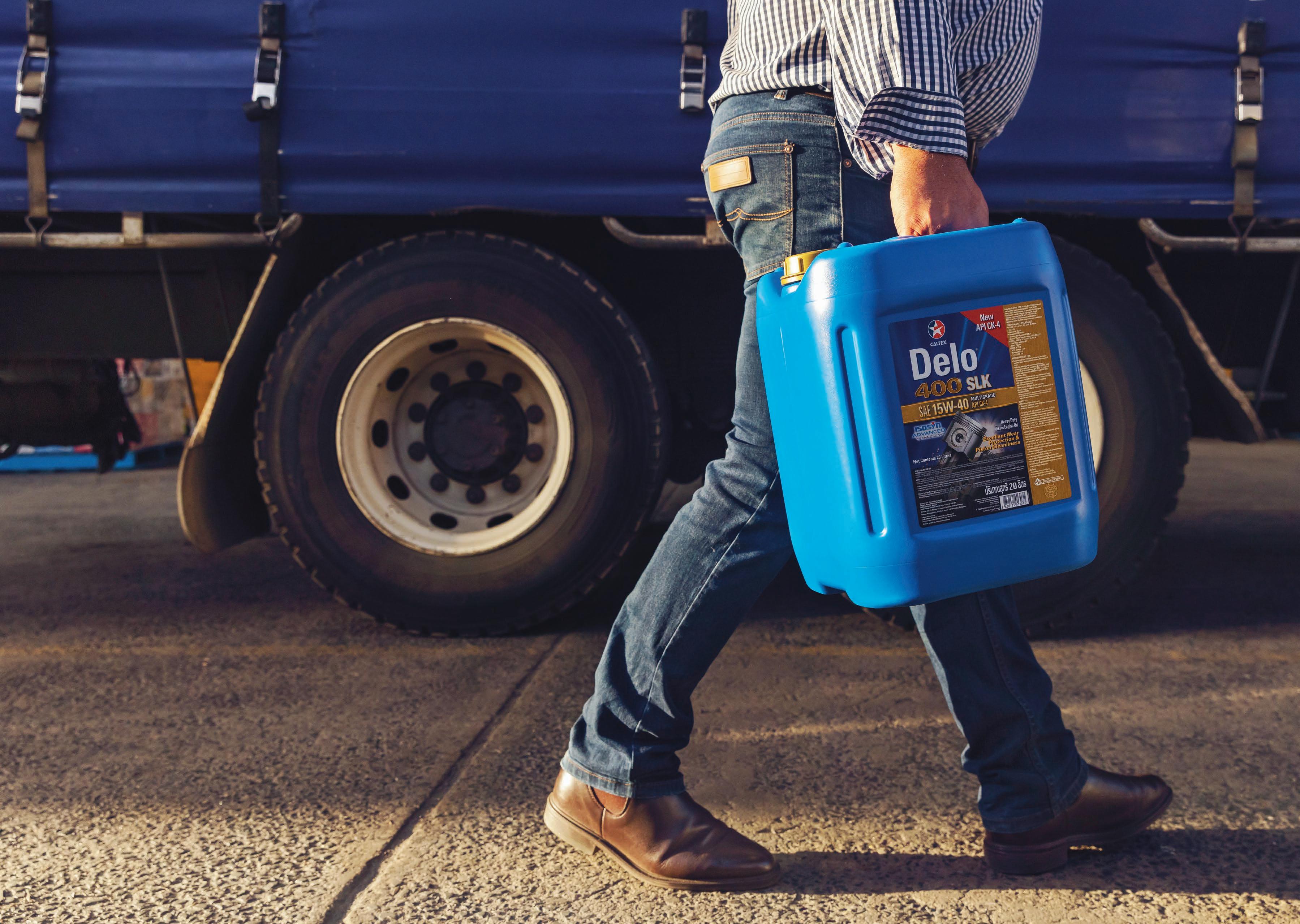

LICENCE LUNACY
At a time of a profound and increasingly dangerous shortage of experienced truck drivers, why do faceless bureaucrats contend that reaching a certain age automatically compromises competence? It’s a question nagging at our ‘mature’ technical editor
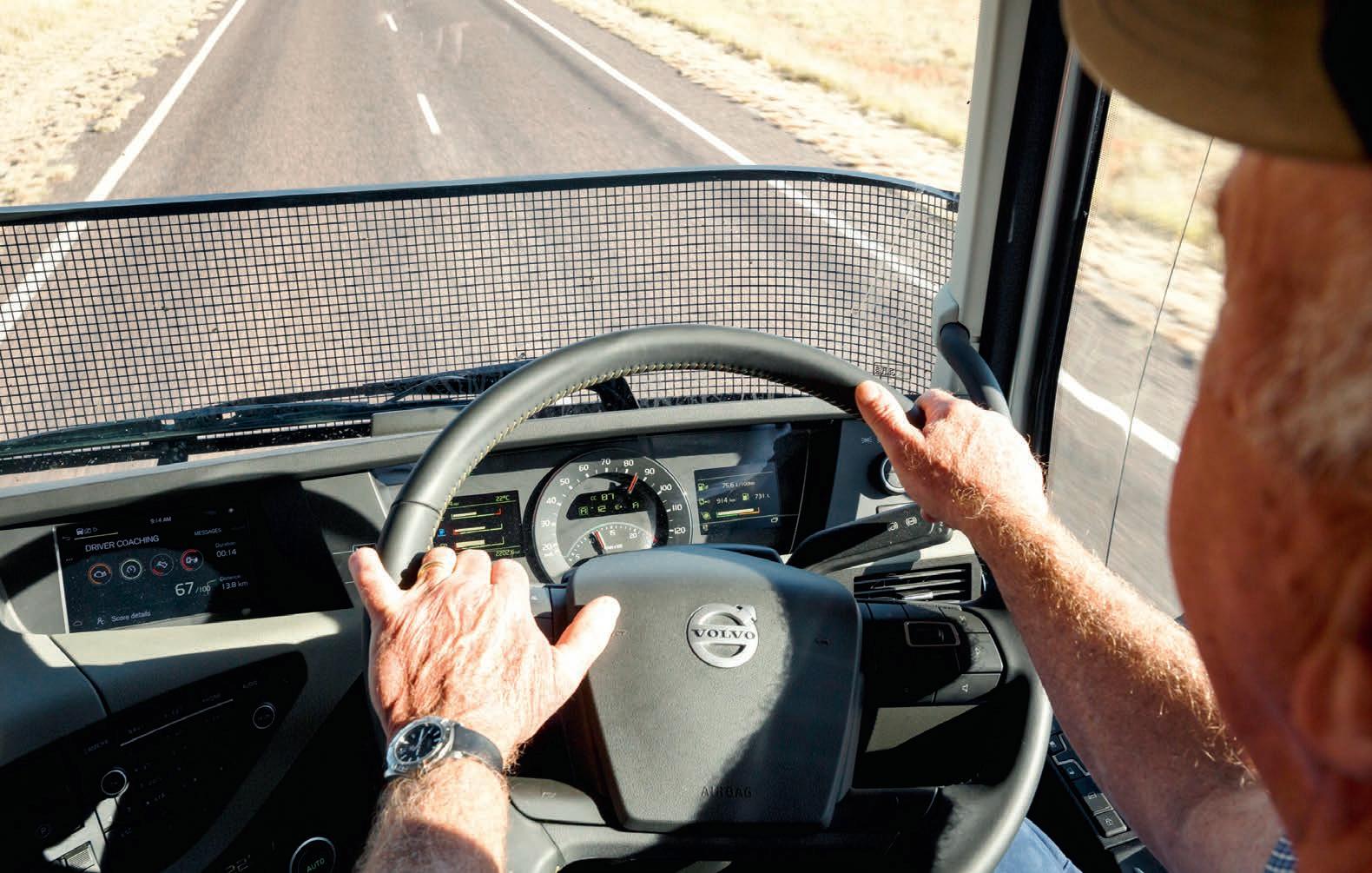
Reaching a new decade of life in a state of good or even reasonable health is always a milestone worth celebrating, quietly or otherwise. As a close mate likes to say, “Life is there to be lived, so get on with it.” It’s a maxim which takes on even greater significance as years start to stack up.
But there are those inanely immovable and somewhat insensitive authorities who can make ‘getting on with it’ decidedly difficult for active and capable people at the veteran end of experience. Transport for NSW is one of those authorities.
What follows will be no doubt viewed by some as nothing more than a whinge by an aging journalist with a capacity for candid commentary. True enough perhaps, but it is also a truthful account of what happens when experience and ability become totally irrelevant to the appeasement of a bureaucratic, indelible line in the sand.
A few months back I hit 70 years of age. Great! I made it this far and as an added bonus, after almost 45 years in the road transport media, I’m still content and capable enough to keep driving and reporting on trucks of every shape, size and brand.
Equally, and gratefully, the world’s leading truck brands still find it worthwhile to offer their latest and greatest creations for honest and practical assessment. I am, of course, not the best driver in the business but nor am I the worst, and the good fortune
to drive well is as much a product of the exceptional mentors and professionals I have encountered over many decades as any inherent affinity with heavy trucks and machinery.
Still, it appears none of this counts for anything upon entering the septuagenarian years.
Maybe a month before the big day, a letter arrived from Transport for NSW, bearing the indecipherable signature of someone titled ‘Manager – Licence Review Unit’. The letter was not unexpected. Since turning 60 a decade ago, there has been the requirement to have a medical test every two years to maintain the national MC – multiple combination – licence I’ve held since the classification was first mandated more than three decades ago, ostensibly to ensure competence behind the wheel of B-doubles and roadtrains. Like a lot of others though, B-doubles and much bigger combinations had been driven long before the introduction of an MC licence.
Nonetheless, the biennial medical test from 60 years onwards is a rational requirement to protect the safety of both the truck driver and other road users. The medical, however, becomes an annual requirement from 70 years but even at this duration, it’s still a smart move. After all, an annual check-up by a doctor is good practice for anyone at any age.
But then, at 70 there also comes the condition to pass an aged driving test to keep your MC status. Not once, but every single year from that age onwards.
Steve Brooks
Suddenly, at 70, it seems experience and a good driving record are completely inconsequential. Overnight you’re old, you’re losing your marbles, you could drop dead at any time, you’re not as capable as you were the day before, and maybe you should drive something a little less challenging, you old fart!
You can, of course, try to work with the system but calling the department’s contact number and waiting interminably before someone actually comes on the line, delivers little more than policy platitudes. Sure, the lady on the phone was polite and pleasant, and purportedly sympathetic, but after a few more minutes checking with her managers, plainly stated that yes, you need to demonstrate your competency every year, the cost is yours and you can either supply your own vehicle – we’re talking about a B-double here – or you can go to a commercial licence assessor.
So alright, how much to sit for an aged driving test in a B-double with a licenced and so-called professional trainer? A quick call to a company specialising in truck licences revealed that half a day to determine you can actually drive a B-double competently costs “about a thousand bucks.” Every year, mind you, plus the department’s administrative costs and obviously, the cost of your time and inconvenience. Every single year.
One more thing, is that in a manual or auto truck? Apparently, there’s not much requirement for manual
18 DECEMBER 2022 ownerdriver.com.au
driver licensing
shifters these days, so driving school prime movers are almost totally autos. “We have manual HR (heavy rigid) trucks,” said the assessor representative on the other end of the line, “but that’s a separate assessment if you want to go that way.” No, I’ll be right thanks.
Weirdly though, Transport for NSW provides an easier and far less expensive option. At 70 years of age, you can select to forego your MC classification and simply swap to a HC – heavy combination –licence and automatically, and quite unbelievably, the requirement for an aged driving test is pushed out to 80 years of age and most surprising of all, the annual medical check-up for a HC doesn’t kick in until you reach 75.
Bingo, stick your MC!
Seriously though, this is a brainless situation. In the modern world of Performance-Based Standards, a HC still allows holders to drive heavy and highly demanding combinations, including truck and dog outfits which nowadays routinely weigh more than any number of B-doubles on local, regional or even linehaul work. Furthermore, the skill to competently handle a six, seven or eight-axle truck and dog combination can be every bit as challenging as being at the helm of a B-double. Indeed, the truck and dog operator is invariably expected to put the combination into extremely more difficult sites.
Meantime, a HC licence also allows the holder to drive indivisible and oversize loads on a single trailer, apparently even if it’s a low loader with rows-of-eight axles hauling a piece of massive mining machinery.
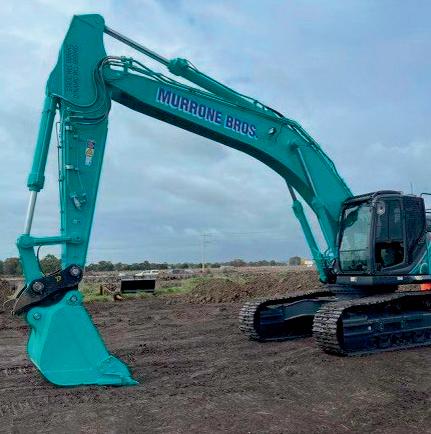
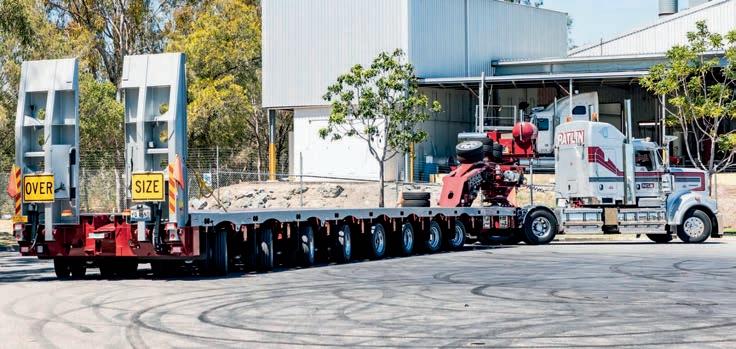
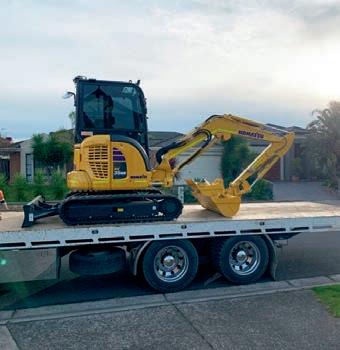
What’s more, a HC holder can still drive a B-double and more as long as he’s in the cab with the holder of an MC licence. This, in itself, can be a ludicrous situation when a senior person who has despairingly downgraded to a HC licence is quite possibly a far more capable operator than the person in the passenger seat on the other side of the cab who happens to have the right piece of plastic.
Obviously enough, the point of all this is that age should not be the defining factor in determining a person’s suitability to hold an MC licence, particularly with the trucking industry desperate to maintain high standards at a time of severe driver shortage; a shortage invariably cited as a contributing factor in an increasing number of notable trucking companies opting out of the industry altogether.
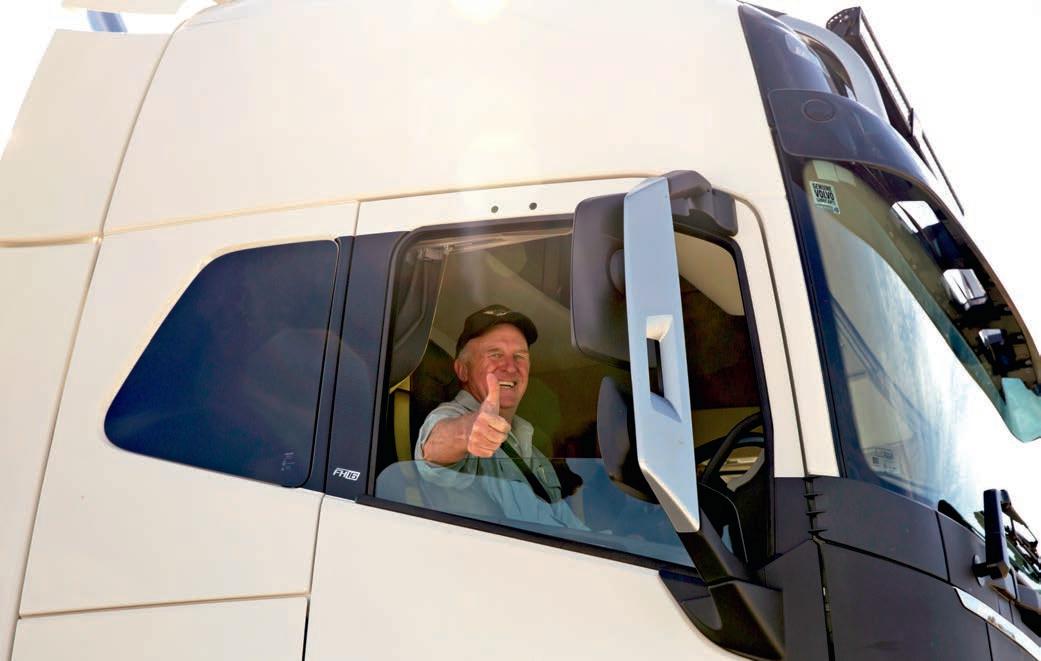


And while road transport’s representative bodies agitate for relaxation of visa rules to encourage overseas drivers to fill the gap, perhaps an effort to rid the industry of draconian bureaucratic

regulations would be a wise and worthwhile way of not only keeping good operators in the system, but also help raise the overall standard which by most estimations continues to slide dramatically, and dangerously.












So, surely a person of sound mind and sound body with decades of experience in MC combinations and a reputable driving record should be encouraged and appreciated, and arguably subject to the same regulatory demands as HC drivers, rather than stigmatised by nothing more than a birthday milestone.


Anything less is prejudice, plain and simple.



DECEMBER 2022 19 ownerdriver.com.au
Melbourne (03) 9305 9400 Sydney (02) 8294 5597 Brisbane (07) 3053 5661 Absolute Competence Genuine care of your business The Easiest process to obtain finance Ainsley Cutts 0413 111 511 Donella Cutts 0433 002 211 Patrick O’Keefe 0433 002 204 Richard O’Keeffe 0410 667 523 Free Assessment Available on our website at www.allfreightfinance.com.au Or call one of our qualified brokers for an assessment over the phone Deal with one Broker, Simple! OVER 20 YEARS IN EXPERIENCE FINANCE WE DO INSURANCE PREMIUM FUNDING WE CAN FUND YOUR WORKCOVER PREMIUM TO TAKE ADVANTAGE OF THE EARLY PAYMENT DISCOUNT – CALL US NOW FOR A QUOTE TRUST OUR EXPERIENCE IN THESE DIFFICULT TIMES PROUD SPONSORS OF 2022 AUSTRALIAN SUPER TRUCKS RACING SERIES
NHVR Sal Petroccitto
Tyres fit for PBS
The NHVR has responded to industry feedback, enabling a wider range of tyres for PBS

Since I last wrote, the National Heavy Vehicle Regulator (NHVR) has announced two critical steps to ensure the Performance Based Standards (PBS) scheme continues to deliver improved, fit-for-purpose outcomes and efficiencies for industry, the environment and our communities.
On December 1, as part of our strong focus on breaking down barriers to enter into the scheme, we introduced a generic tyre approach, enabling PBS vehicles to use a broader range of tyres.
PBS vehicles now no longer need to have their on-road performance assessed using specific tyre types and brands. Instead, any brand of tyre can be used, as long as an assessment shows the design passes the relevant PBS standards.
We developed this approach in direct response to feedback from industry that the previous approach was complicated, restrictive and outdated, creating unnecessary costs and
operational limitations.

It’s feedback like this that we really welcome. It helps us know where to concentrate our efforts to have the biggest impact and benefit. In this case, it’s enabled us to provide a solution that will allow operators greater flexibility, increased productivity and lower costs, without impacting safety and performance. Indeed, since ministers endorsed the generic tyre approach last year, we have undertaken extensive testing to ensure the safety of PBS vehicles is not compromised by adopting this new approach.
DISCUSSION PAPER
Our second initiative involves taking a step back and considering ‘where to from here’ for the PBS scheme. We recognise the key role the scheme plays as an incubator for innovation in the Australian road transport industry, and we want to make sure this focus is maintained and strengthened.
Last month, we released the
vehicles
SAL PETROCCITTO became CEO of the NHVR in May 2014, bringing extensive knowledge of heavy vehicle policy, strategy and regulation to the role. He has broad experience across state and local government, having held senior leadership roles in transport and logistics, land use, transport and strategic planning, and has worked closely with industry and stakeholders to deliver an efficient and effective transport system and improved supply chain outcomes. Over the past seven years, Sal has led a significant program of reform across Australia’s heavy vehicle industry, including transitioning functions from participating jurisdictions to deliver a single national heavy vehicle regulator, harmonising heavy vehicle regulations across more than 400 road managers, and modernising safety and productivity laws for heavy vehicle operators and the supply chain.

Performance Based Standards 2.0 Discussion Paper to seek views on what a revamped PBS scheme might look like.
The discussion paper provides a comprehensive review of the scheme and suggests options for how to incentivise industry to uptake PBS vehicles, accelerate growth in the scheme and enable continued fleet innovation.
The paper also has a strong focus on working with road managers to open up increased access for PBS vehicles, so they can operate on the same networks as their conventional equivalents, provide certainty of access for these vehicles, and eliminating the need for permits.
To date, the PBS scheme has fundamentally transformed the way we move freight in this country, and it’s important we continue to work closely with industry to improve and grow the scheme for the benefit of all road users and our broader economy.
We want to hear from all interested parties and are excited about the conversations to be had. To read the discussion paper, register for a webinar or find out how to submit your views, visit www.nhvr.gov.au/ pbs2-0. The closing date for written submissions is December 16, 2022.
THE NHVR’S PREFERRED OPTION PRESENTED IN THE PBS 2.0 DISCUSSION PAPER COMPRISES THREE KEY ELEMENTS THAT WILL:
• ensure PBS vehicles remain at the forefront of innovation through the dynamic management of PBS standards
• create a ‘lifecycle’ for a PBS vehicle from initial concept through to exit from the PBS scheme for common and mature design concepts
• expedite end-to-end approval processes through opportunities for third parties – such as, assessors, certifiers, and manufacturers – to support delivery of regulatory functions.
20 DECEMBER 2022 ownerdriver.com.au
“The PBS scheme has fundamentally transformed the way we move freight in this country.”
PERFORMANCE AND ECONOMY

no compromise
Detroit’s DD16 delivers all the power you need.
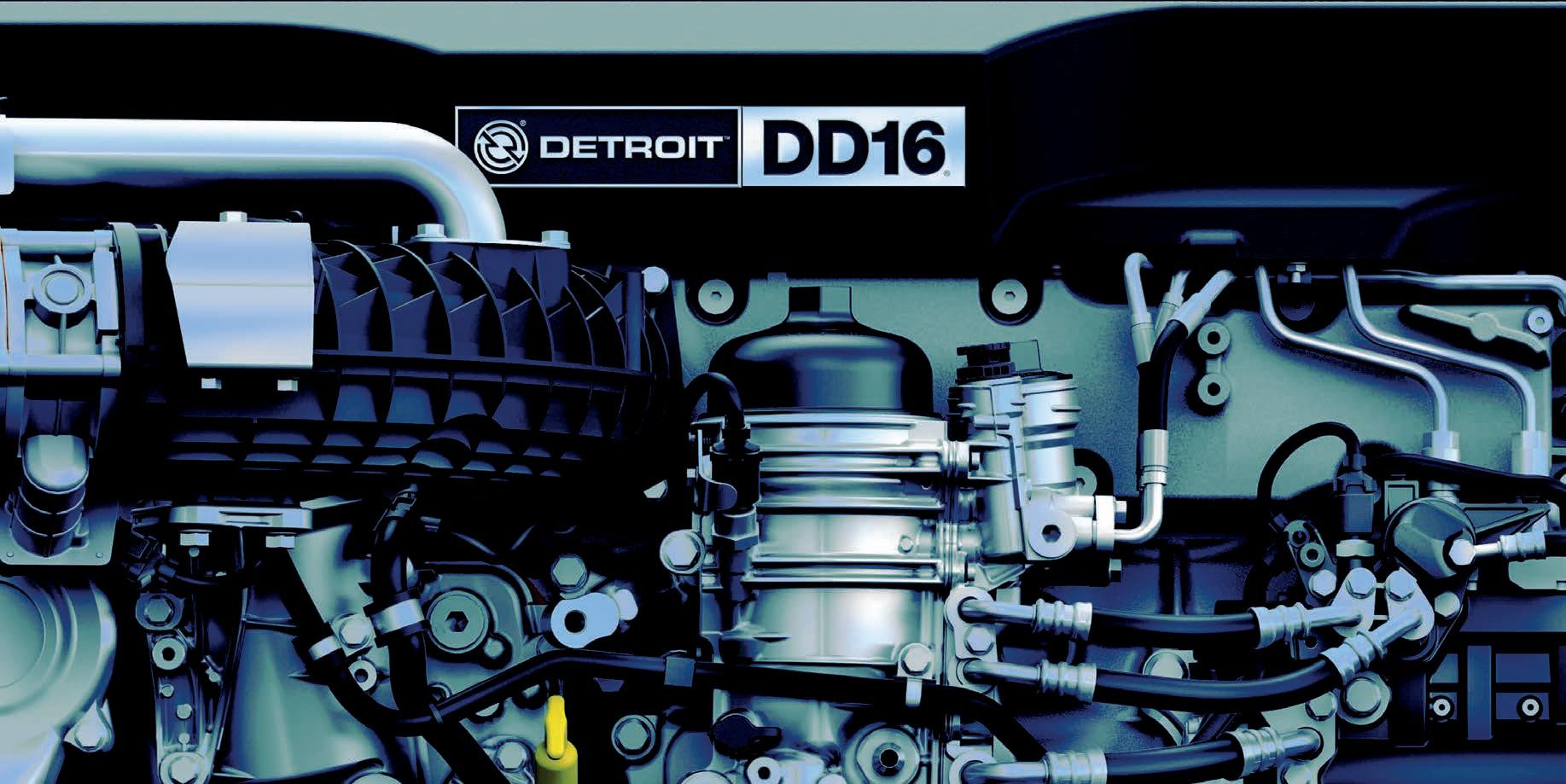
With up to 600 horsepower and 2,050 lb-ft of torque, the big bore workhorse provides efficient and dependable power and performance without compromise. Detroit’s advanced technology also means GHG17 requirements are met through innovative fuel efficiency resulting in lower emissions.
This power, performance and efficiency prowess is backed by our industry-leading warranty and extended coverage packages that ensures the highest level of support for our customers.
Combined with superior fuel economy and the absence of a midlife change out, the DD16 delivers an enviably low total cost of ownership and maximum uptime.
This is all backed by our well-established and extensive national service and support network which, together with our highly skilled factory-trained technicians, means you can count on getting the right advice when you need it.
With Detroit, there’s no compromise.
detroitaustralia.com.au detroitanz
REMEMBERING
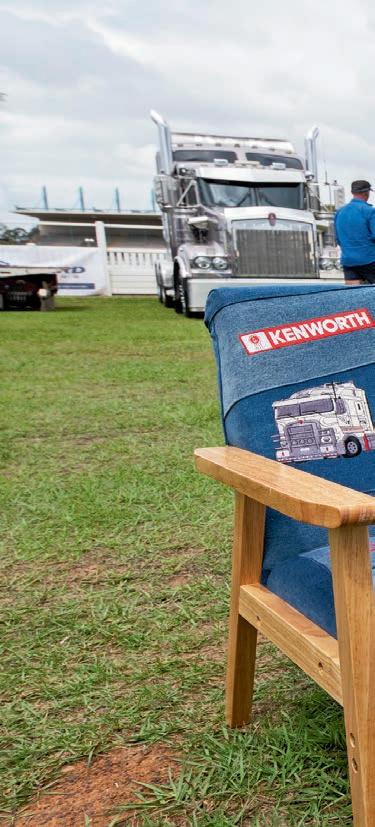
















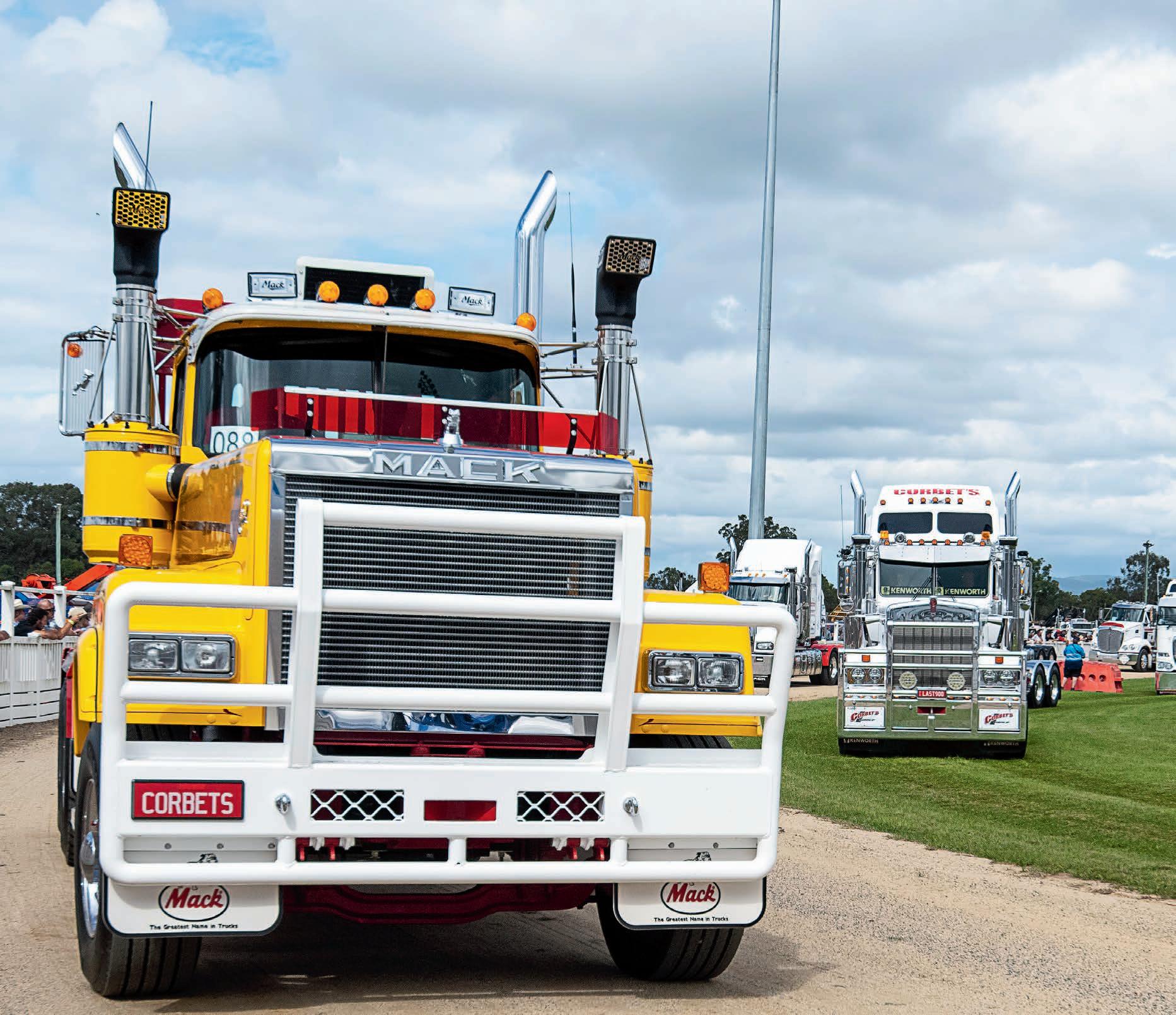


22 DECEMBER 2022 ownerdriver.com.au truck
events
Ifinally made it! Matty Hillcoat’s Truckies’ Day Out has finally been knocked off my bucket list!! I have been wanting to attend this increasingly popular event for a few years now. I missed it in 2017, 2018 and 2019 due to an uncontrollable V8 Supercar addiction (the Bathurst 1000) and then I missed it in 2020 and 2021 due to the world going pandemic crazy and everything getting cancelled. However, 2022 saw the return of the Matty Hillcoat’s Truckies Day Out and I made it.





It was the fourth running of this increasingly popular day and I obviously wasn’t the only one pleased to see it back. Record crowds and a record number of trucks rolled into town to show off their rigs, relax for the day and raise such much needed funds for a very important cause.
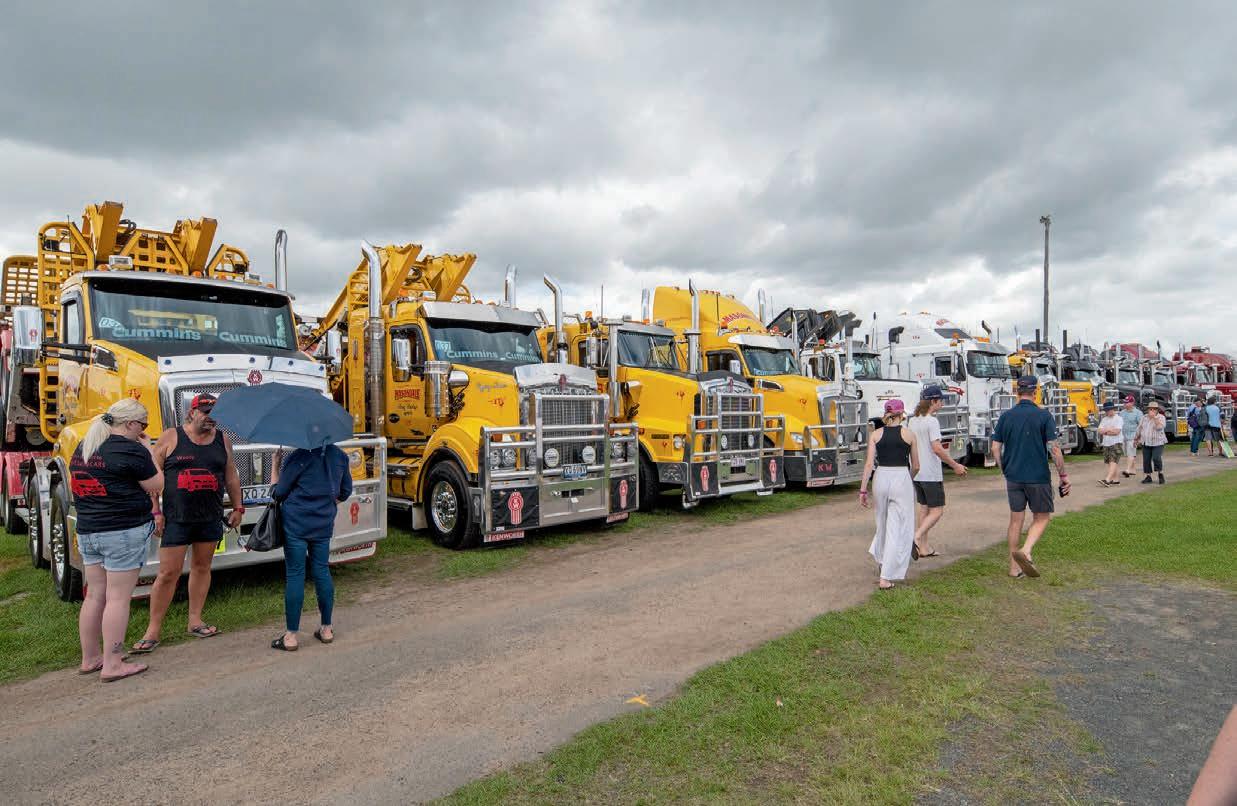
For those of you unaware of the Matty Hillcoat’s Truckies’ Day Out, let me bring you up to speed. First let’s talk location. Just north of Brisbane in the heart of the Wide Bay-Burnett Region you will find the town of Gympie. The Gympie area is famous for it’s nuts and it’s Gympie Muster Music Festival. Random fact here, Gympie was originally called Nashville. I’m serious, up until 1868. It had been named after James Nash, a dude that discovered gold there.



















Gympie is also a town that has been the victim of repeated with catastrophic flooding over the past few years. Like all tough country towns though the community bands together and keeps fighting on. It’s this kind of community spirit that will
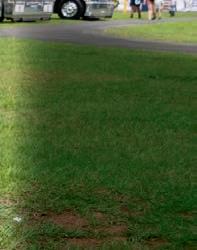
Top, L to R: I just had to capture this custom-made chair for Ben and Kasey of B&K Haulage; The Masondale Heavy Haulage fleet turned up in spades with some stunning log trucks. Their T610SAR later picked up the Best Log Truck award
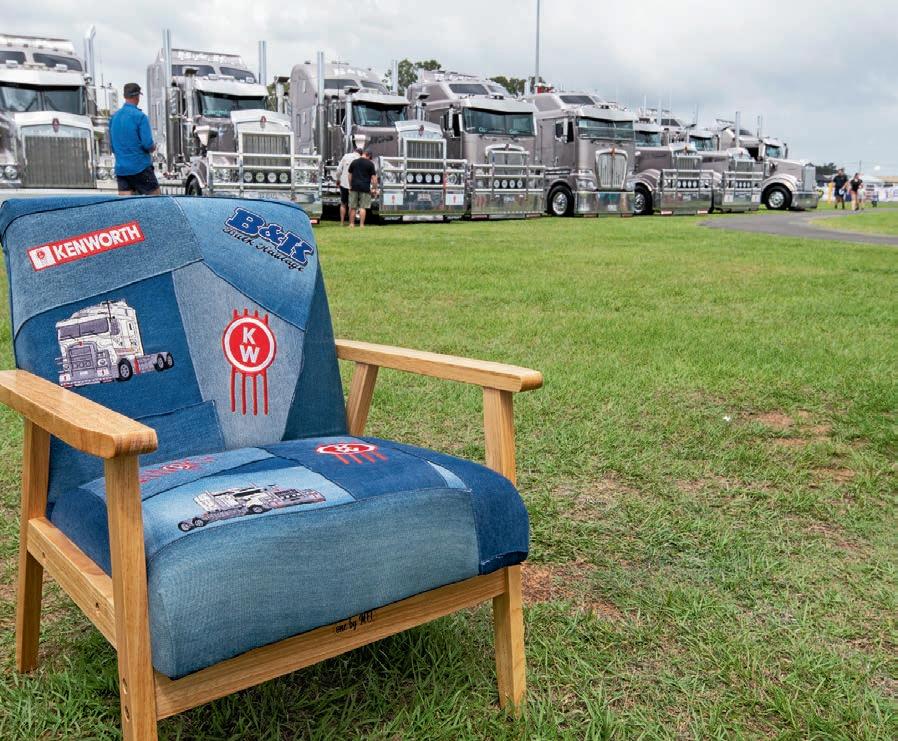
Above, L to R: Corbet’s Group from Gympie put on a hell of a show by themselves, picking up second place in the Best Fleet category and tying for first in the Largest Fleet; Sam Steele and Jess Steele were stoked to be at the show with the fuel tankers they run for CPB out of Gympie

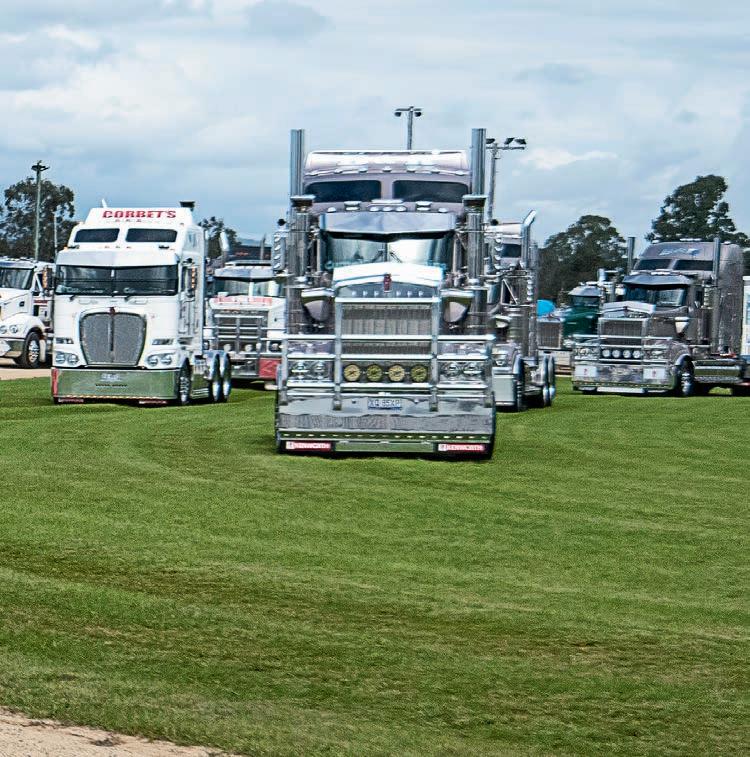
DECEMBER 2022 23 ownerdriver.com.au
Tragedy inspired a Gympie couple to add another truck event to the Australian calendar. Now with the fourth running of Matty Hillcoat’s Truckies Day Out, it has brought the trucking community from nearby and further afield for an annual family fun day, but more importantly raising funds for Sudden Infant Death Syndrome research. Warren Aitken writes
MATTY


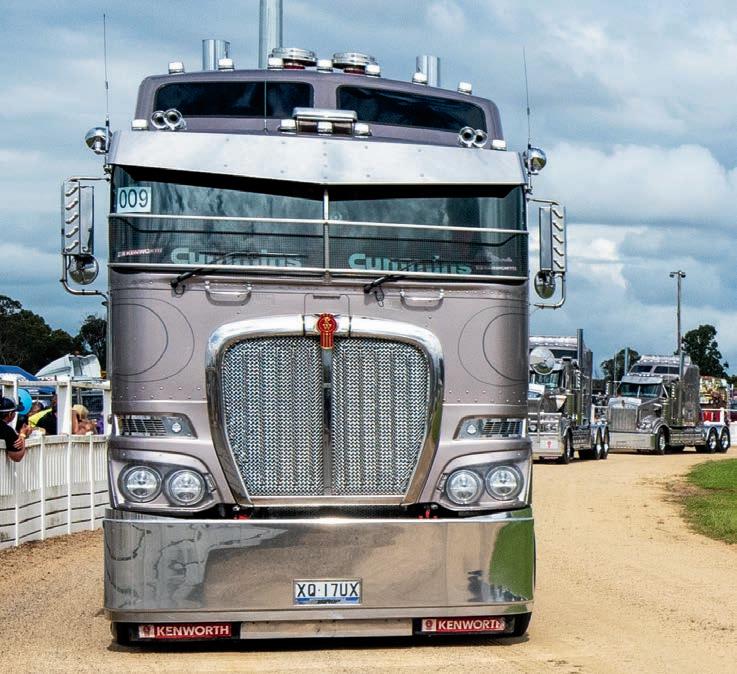



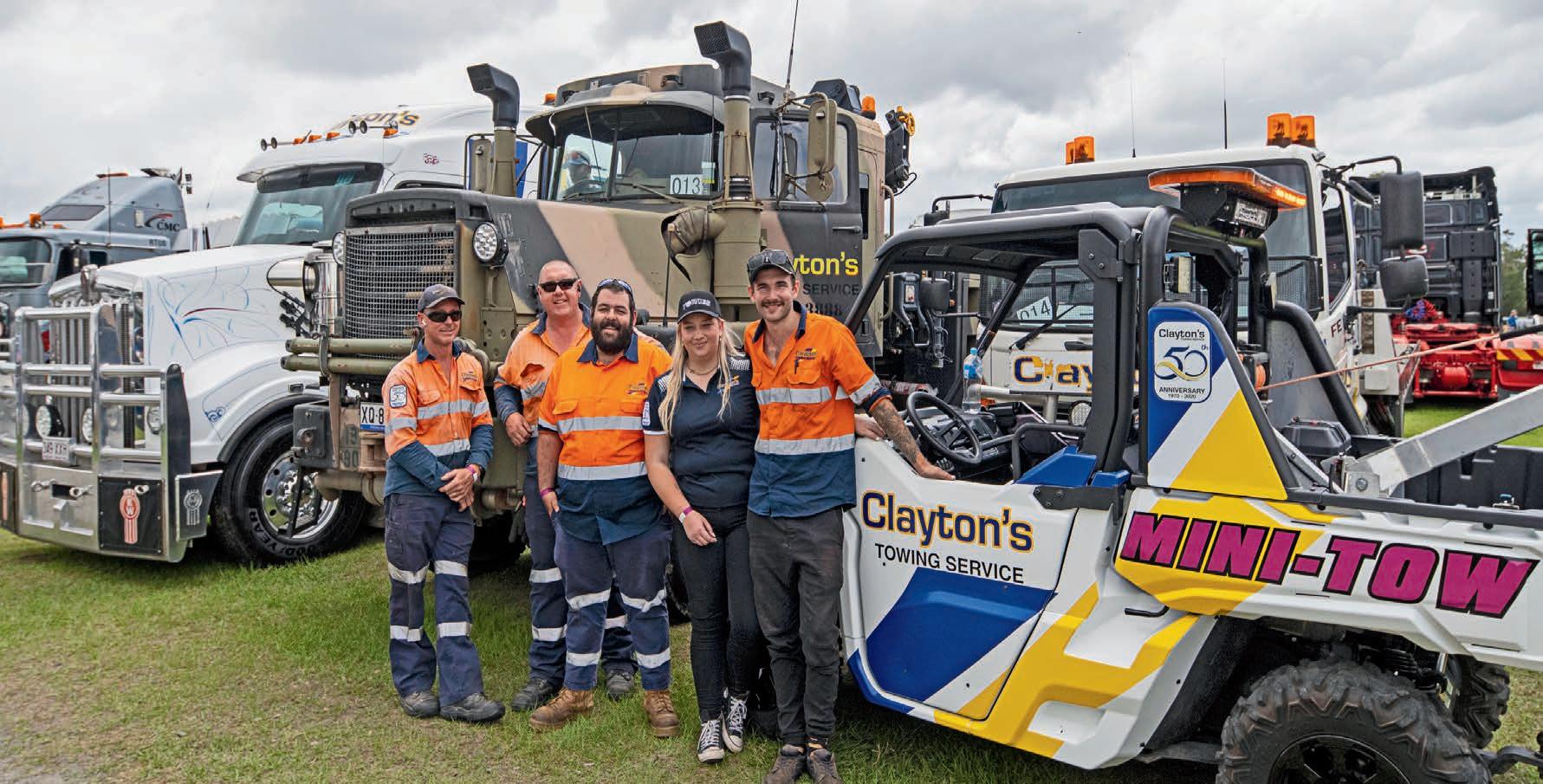


















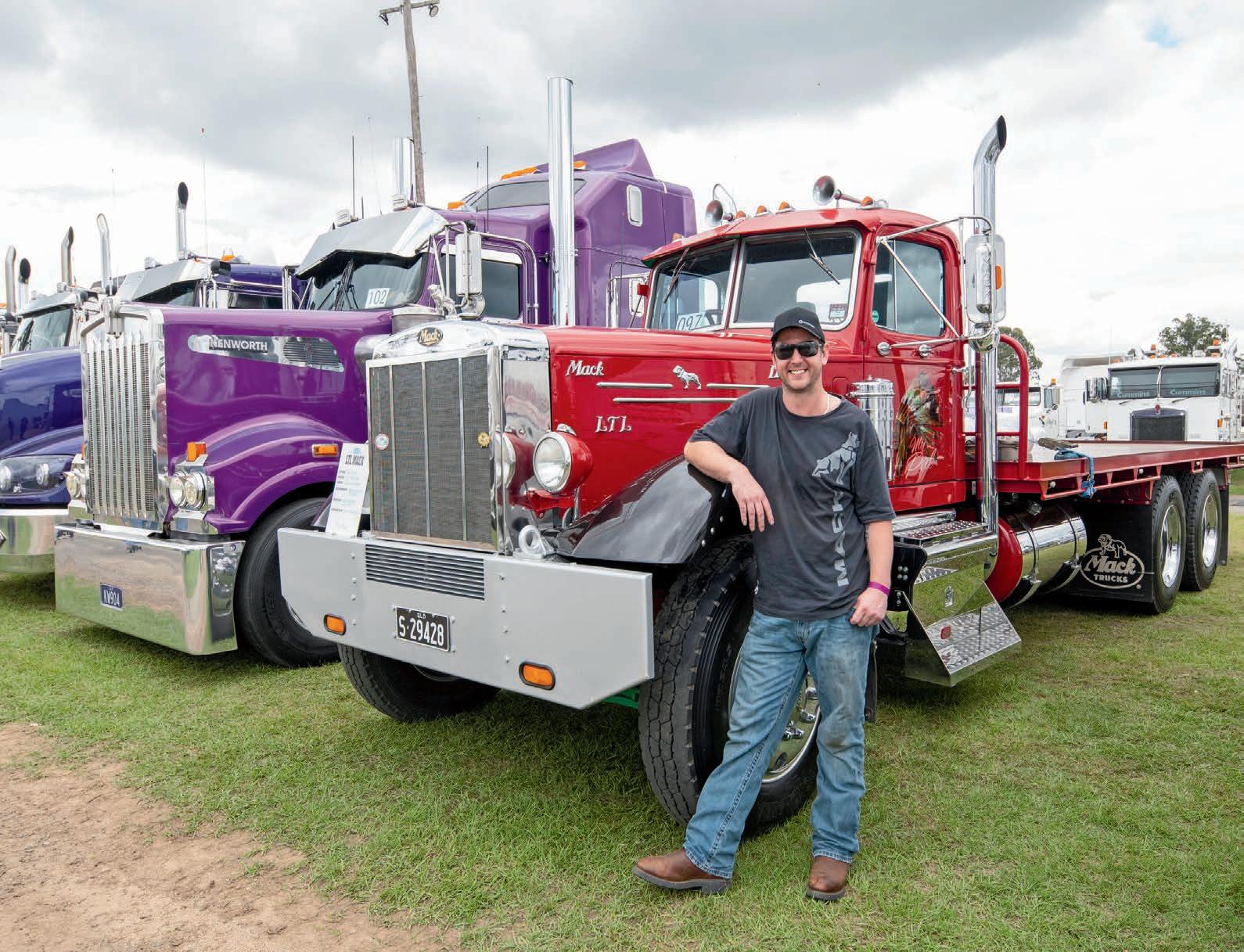
ownerdriver.com.au
segue me into the motivation behind the Matty Hillcoat’s Truckies’ Day Out.
SIDS charity









Unfortunately, the story behind this fantastic fundraising event is not one anyone would like to experience. In 2011 Dan and Kristine Hillcoat’s second son Matty passed away in his sleep. Matty was just four months old. This bright bubbly young boy was one of over a thousand kids per year that die from sudden infant death syndrome (SIDS) worldwide. It is every parent’s worse nightmare and there is no way I could ever comprehend that kind of experience.
The same year that Dan and Kristine lost Matty, a Geelongbased charity called River’s Gift began. Started by a family that went through the same nightmare as the Hillcoats, River’s Gift is now Australia’s solely SIDS focused charity and the leading source of funding for SIDS research.


Dan and Kris aligned themselves with the charity and participated in much needed fundraising events. In 2018 they decided to organise a truck show as a means of raising
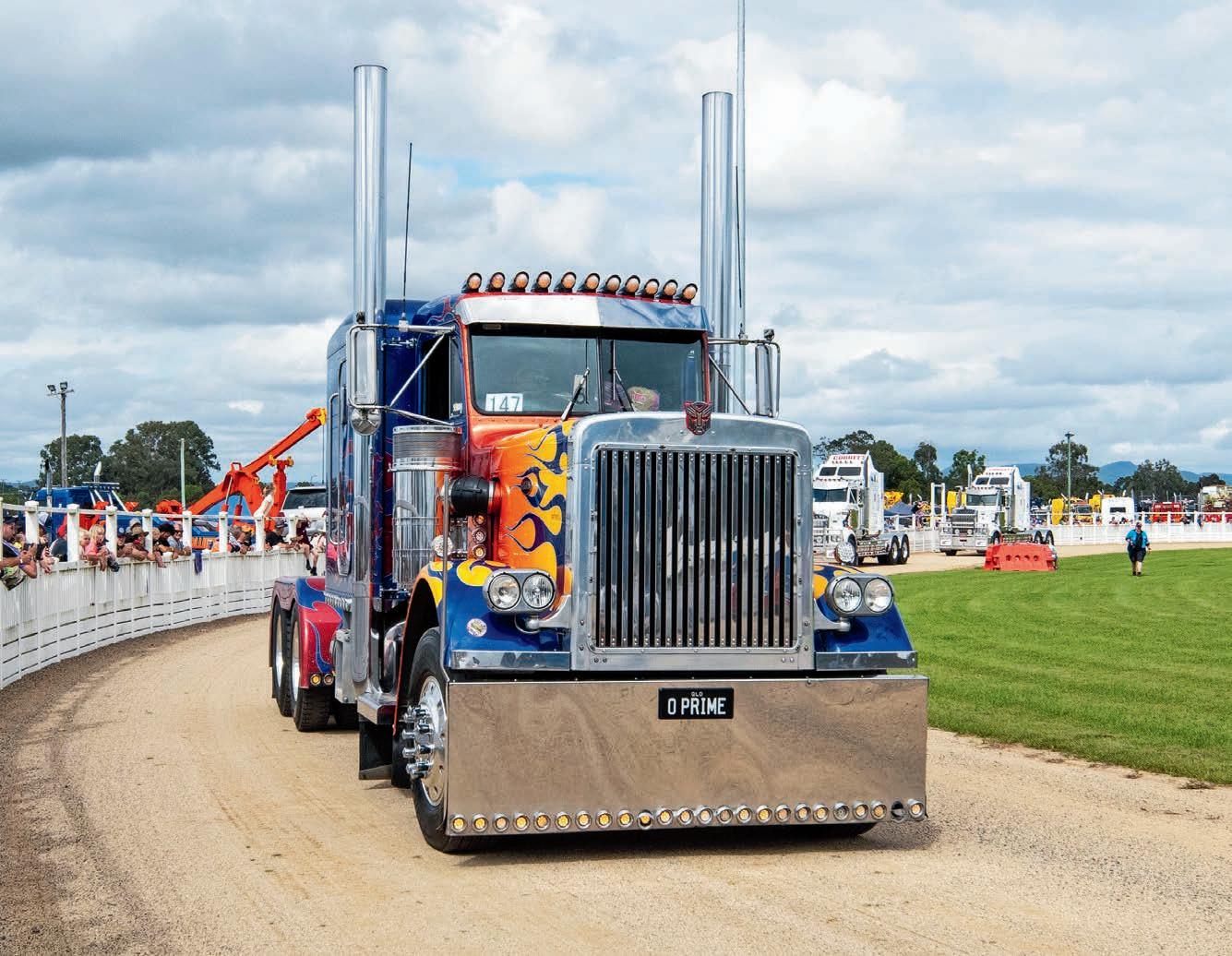


Top, L to R: Greg Ryan was lucky enough to be piloting Bernie Tobin’s 1956 LTL Mack. This unit deservedly picked up the Best Vintage 50-plus award; Mel Lake gets a video of hubby Mick firing up ‘Filthy’, the winner of the Best Custom Truck award

Above, L to R: The Clayton’s Towing crew. From left: Kev, Linden, Chris, Sharnee and Tristan stand proudly in front of an eclectic range of tow trucks; It’s not a show without Watego & Sons’ Optimus Prime, which added another People’s Favourite trophy to Marshall’s pool room
Left & far left: The afternoon was broken up with a cruise around the showground; Close to the action – the parade around the grounds was well attended

DECEMBER 2022 25 ownerdriver.com.au
“Dan Hillcoat has grown up surrounded by trucks so it seemed a logical avenue.”
I look forward to being a part of something that will make a difference for people in the transport industry.”
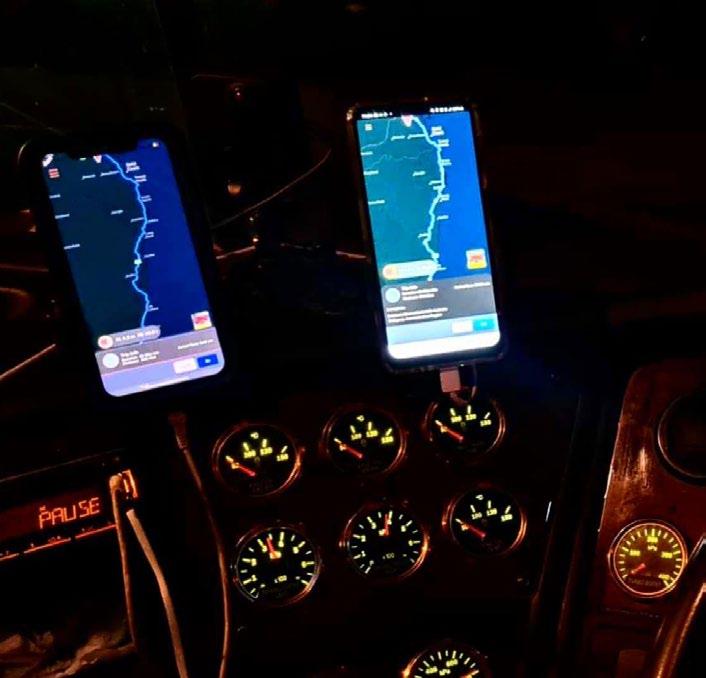


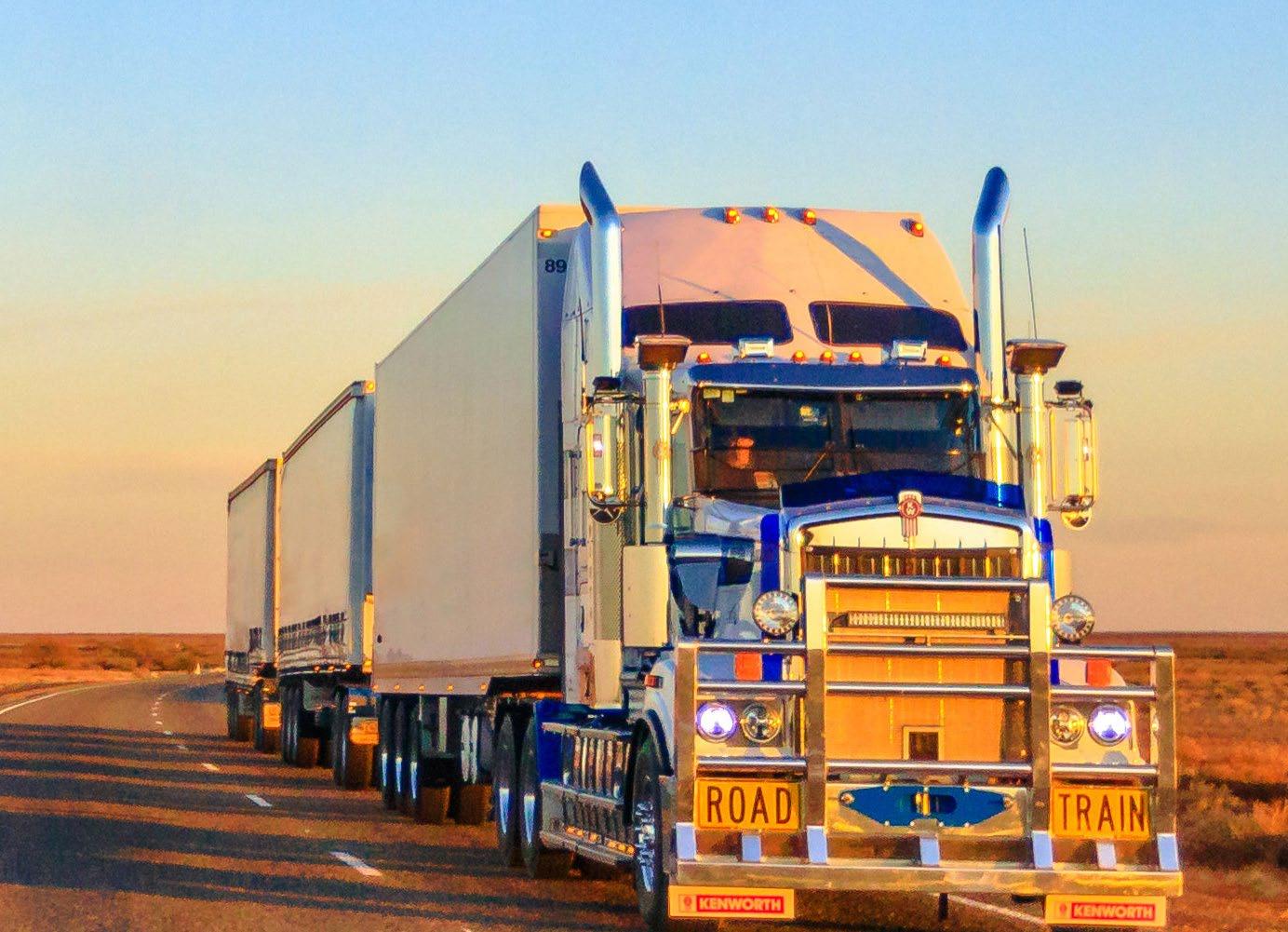
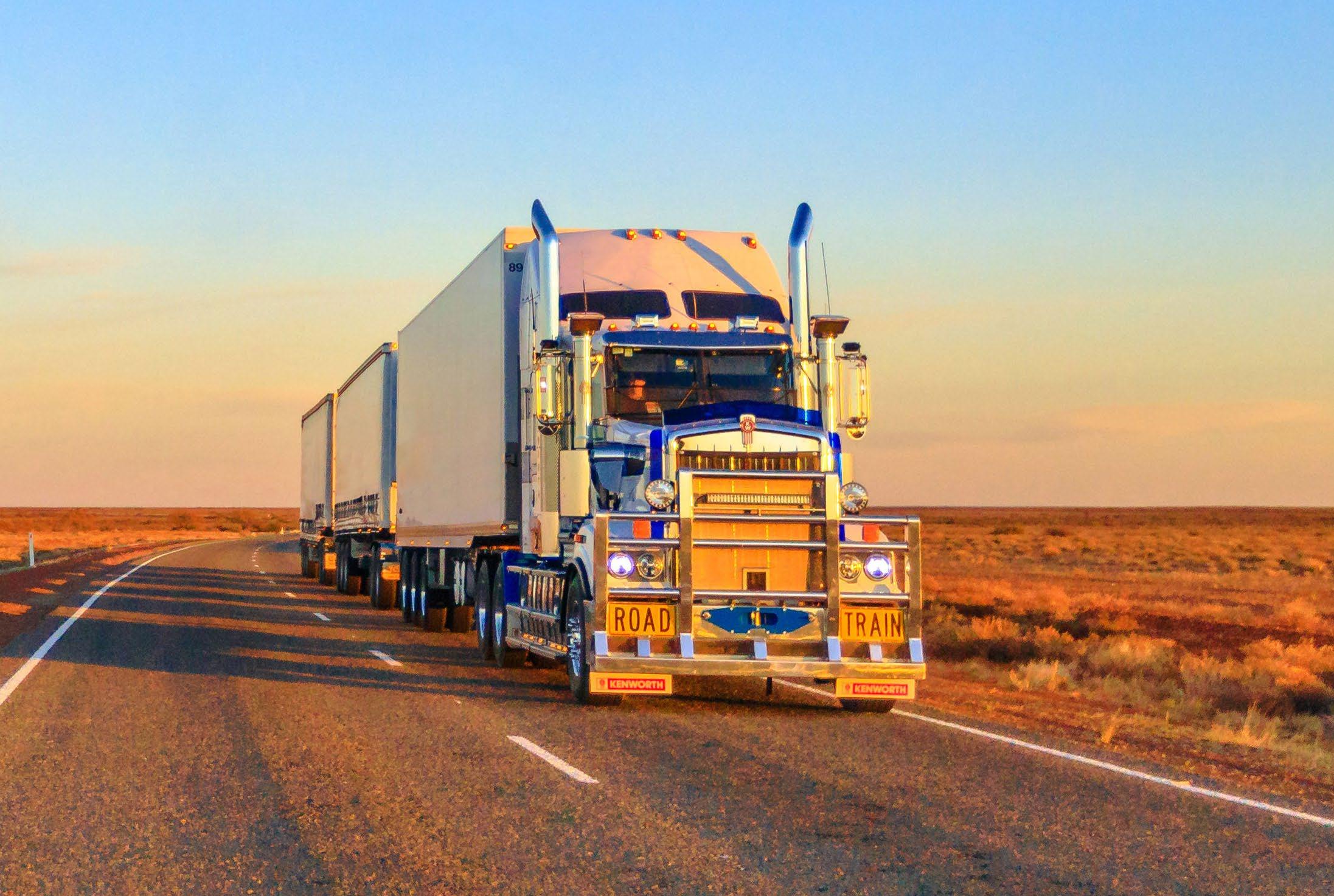

For advertising opportunities contact peter.hockings@primecreative.com.au or call +61 410 334 371 YOUR NATIONAL STATION 24/7 Scan and LISTEN NOW
“Truckies around Australia carry the nation 24/7. They really deserve their own radio station that is with them on the road all day and all night. I really support developing Australian Truck Radio to provide an active voice for Truckies around Australia.
Arana Mcdonald Macca, Founder TruckWiz, Trucking App
From top, clockwise: B&K Haulage out of Gladstone turned up and rightfully took out Best Fleet. All their stunning Kenworths were on point!; I was lucky enough to grab a shot of John Carrol and Tristan Carrol with their amazing rebuilt project – a 1987 Mercedes-Benz; This driver had made an extension cord, allowing some kids to toot the horn. Understandably, it was well used; Winner of the Best DAF went to Cornwall Logging’s stunning 2019 XF105; Queensland House Removers brought their 2021 Mack Anthem along, taking out third place in Best Mack section
was Dan and Kris wanted it to be more than just a truck show, they wanted to make a whole day of it. They wanted to get the community involved, not just the trucking community but the entire community.









The inaugural show back in 2017 roped in nearly 60 trucks and raised over $22,000. This year saw in excess of 150 registered for judging, raising more than $90,000.
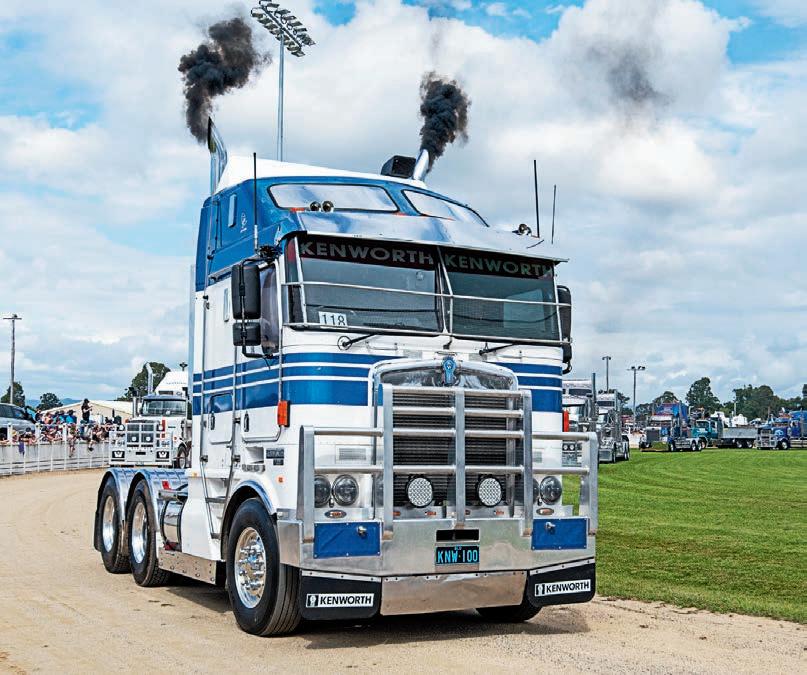















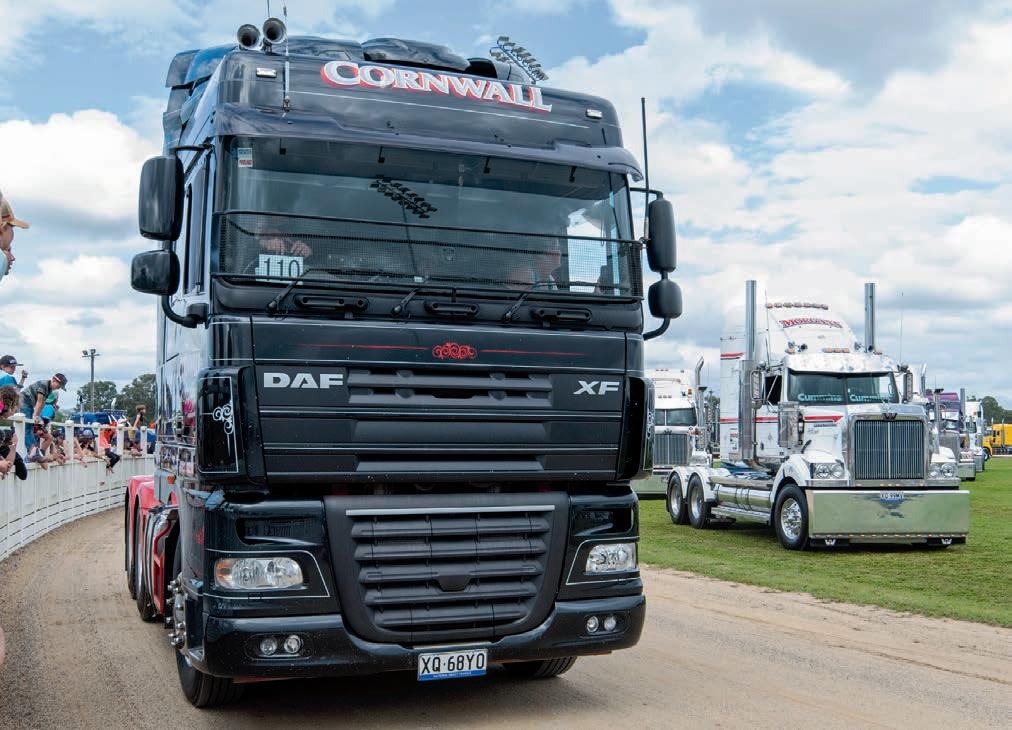





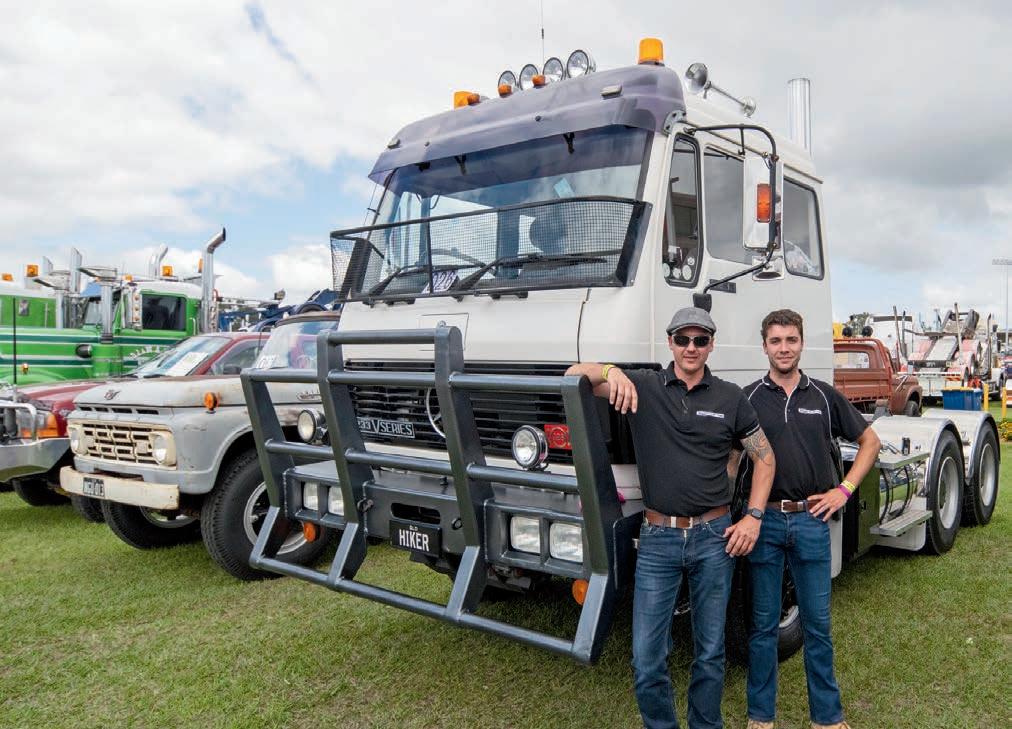







With the explaining all done and dusted, does anyone care to hear how the show was for me? Well, firstly full credit to Mother Nature because it was an absolute pearler of a day for the show. My assistant and I arrived nice and early in order to be well positioned to check out the trucks rolling in. Unfortunately, access was denied as the big horsepower units weren’t able to enter the Gympie Showgrounds until the fourlegged horsepower variants had finished with the racetrack.
Once we were in though there was plenty of on-track action. I admit it took me a while to separate myself from the large consortium of gleaming trucks, but when I did I was not short of entertainment. I spent a fair bit of time watching the ladies and gentlemen of the tractor pull club doing their bit. There was a couple of young ladies that were really ‘givin’ it the jandal’ (which translates in Australian to ‘putting pedal to the metal’).




DECEMBER 2022 27

















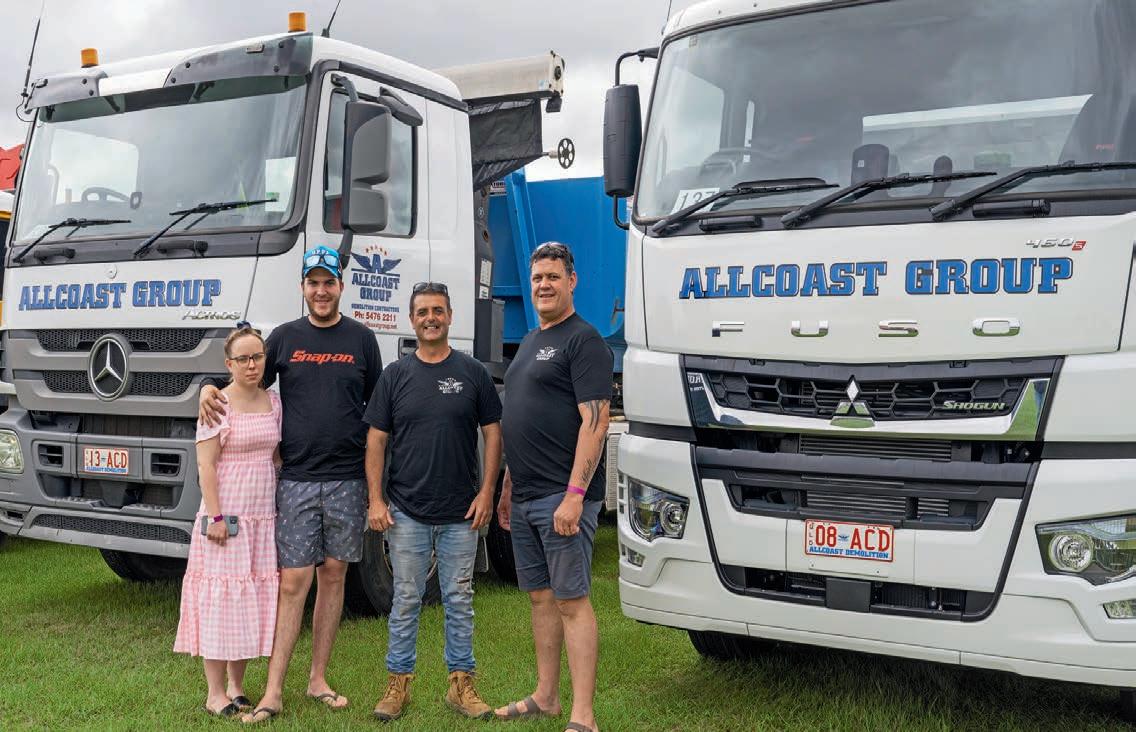









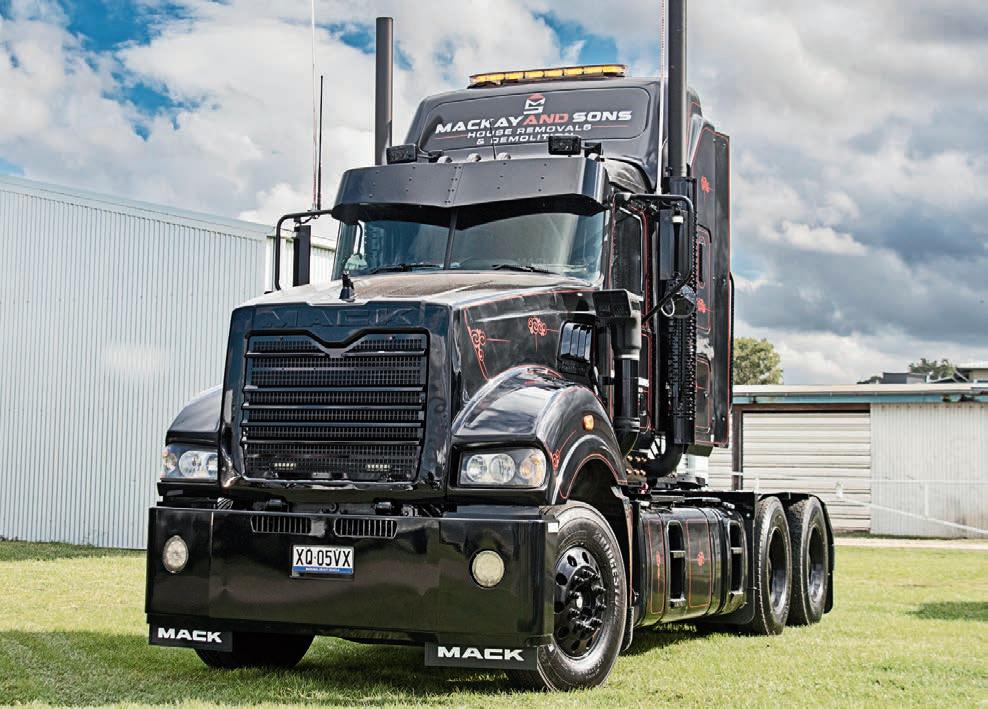




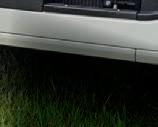






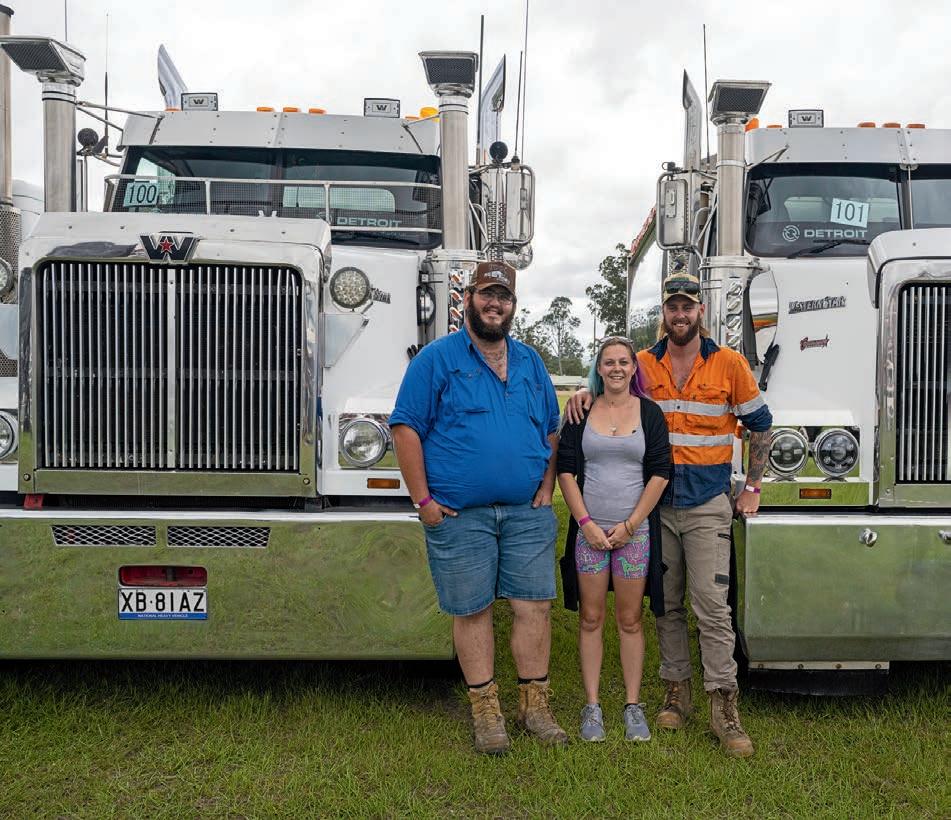











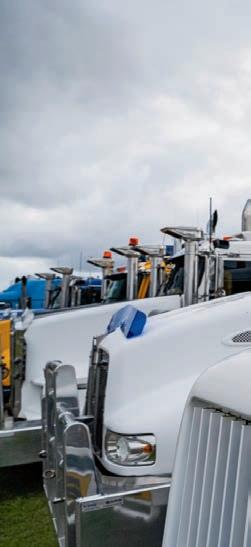
ownerdriver.com.au
Top, L to R: Demolition trucks don’t get much nicer than the Benz and Fuso of Allcoast Group. Zac Weir (second from left), seen here with Briee Jordan, drives the 2017 Benz. Shaun Danger (right) drives the brand new Fuso, whose owner is and Joe Macarlino (second from right); Cornwall Logging’s Scania R 620 took out 2nd place in the Best of the Rest Cab-over category; Susan, Shelley and Sarah were out early checking the details on the long list of registrations
Middle, L to R: My pick for one of the coolest looking trucks was this fresh on-the-road Mack for Mackay and Sons House Removals and Demolition; John Bentley, Micquala Thomsen and Korby ‘Mullet’ McPherson from Gravel Empire Holdings came down from Hervey Bay with their tip trucks
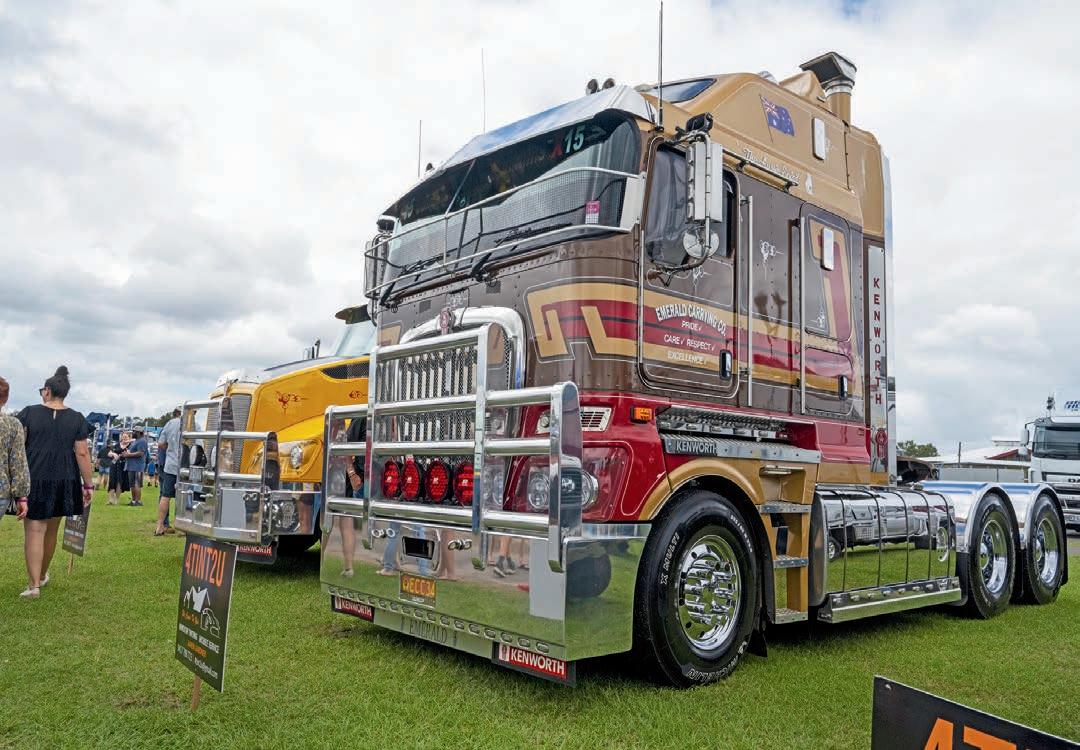
Above: Winner of Best Truck 4-9 years was this impressive Emerald Carrying Co K200



Far left: A big thumbs-up to Brock and the team from RTE who rocked up with their 1997 T900, which scored second place in the Best Kenworth category

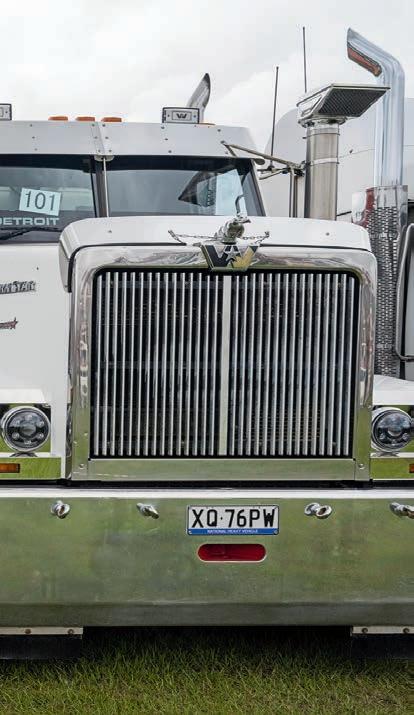
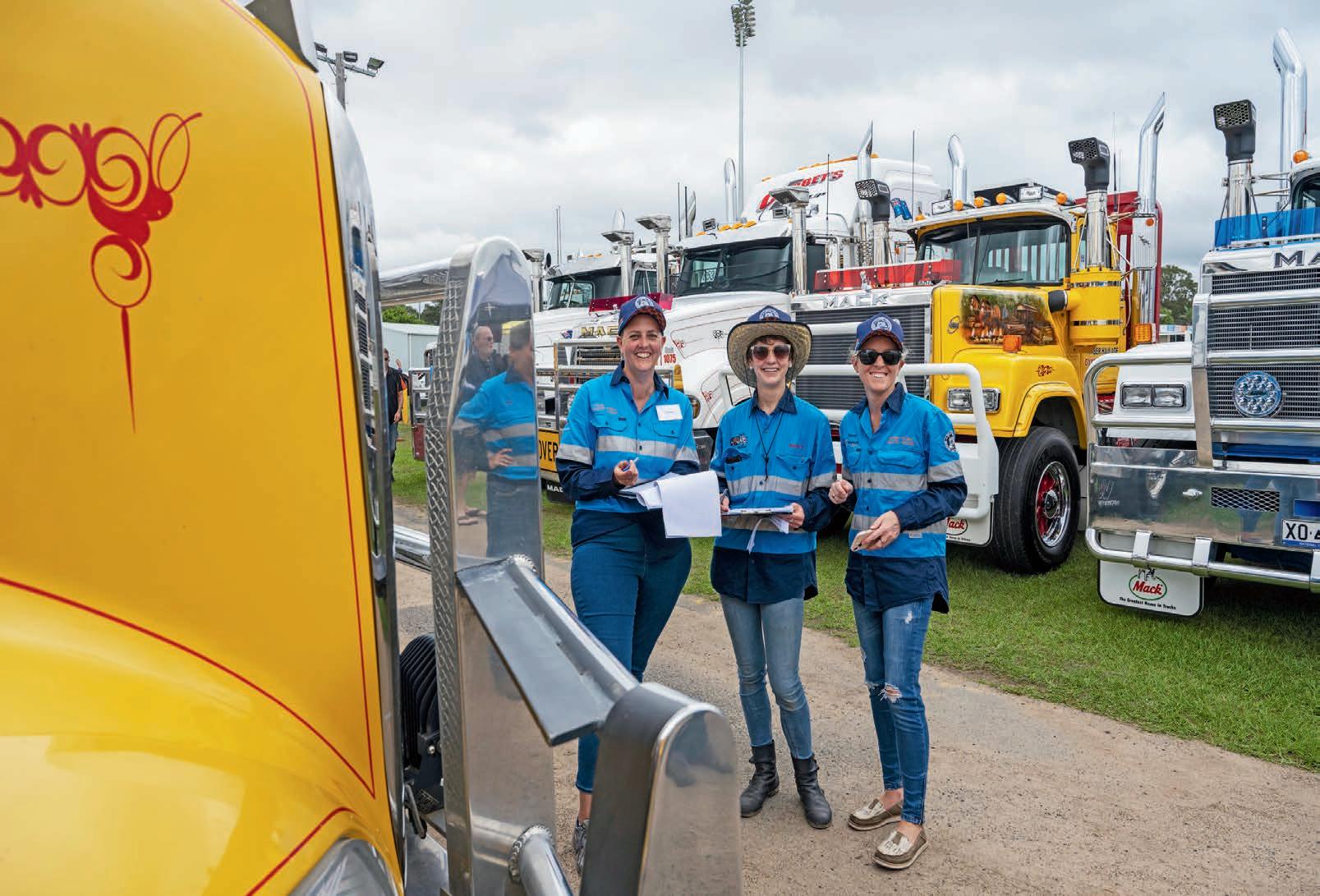
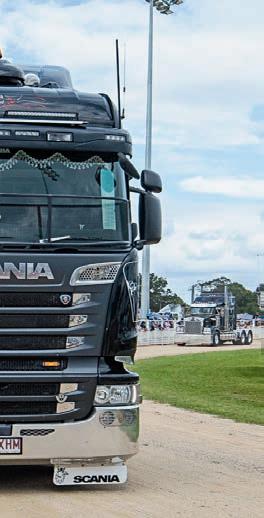
If trucks and tractors weren’t enough there was a massive collection of old machinery. That area seemed to be an attraction for the more senior attendees. It seems if a machine doesn’t have Bluetooth capabilities, then people aren’t interested.














At the other end of the spectrum the young ones had oodles of opportunities to have fun. Under the big tent there was a constant stream of entrants completing colouring competitions. The very flexible and funny Crackup Sisters had several performances. It was a kids show but it was still worth checking out. Those ladies were great for a laugh.
Back outside the tent there was literally a carnival going on, with all manner of rides and games. You could make yourself sick in a variety of ways. I can’t not mention the pig racing either, if only because it was one of the more disappointing aspects of the event. Try as I might I could not find any app taking bets on it, nor could I find any of the vendors willing to roast the losing pigs. Sure, the kids had a ball naming them and watching them race, but I made no money and ended up with no bacon either.
While the trucks were the centrepiece of the show, for most of the day they are the static displays. That was until around 3pm when the inside of the showgrounds opened up.
When the first show started the idea was for the trucks to do a parade lap around the racetrack so the crowds could hang of the fences and wave to all the truckies. That was great when the show started. With the large number of trucks this year though, the racetrack was nowhere near long enough for this. In fact it was bumper to bumper before half the trucks made it in.
I’m not sure which ingenious truckie took the reins, but the parade started a kind of Archimedean spiral, allowing all the trucks to get a turn entertaining the crowds. The spiral eventually fell apart and the grounds look like the setting for the world’s most expensive demolition derby before the group was parked up in the middle for plenty of selfies.
While I had to pull the pin and return home to try and







DECEMBER 2022 29
“With the large number of trucks this year though, the racetrack was nowhere near long enough.”
raising

































catch the Bathurst 1000 Top Ten Shootout, the Matty Hillcoat’s Truckies’ Day Out carried on well into the night. Many truckers hung around to enjoy a relaxing catchup and participate in the light show as well. I was a bit disappointed I missed the prize giving as the trophies are another feature that makes this day stand out.
All in all, I’m extremely glad I finally made it to the Matty Hillcoat’s Truckies’ Day Out. I’m not just saying that because the Top Ten shootout got rained off. This event is still very young in the truck show world and it has the potential to become one of those must-attend events.
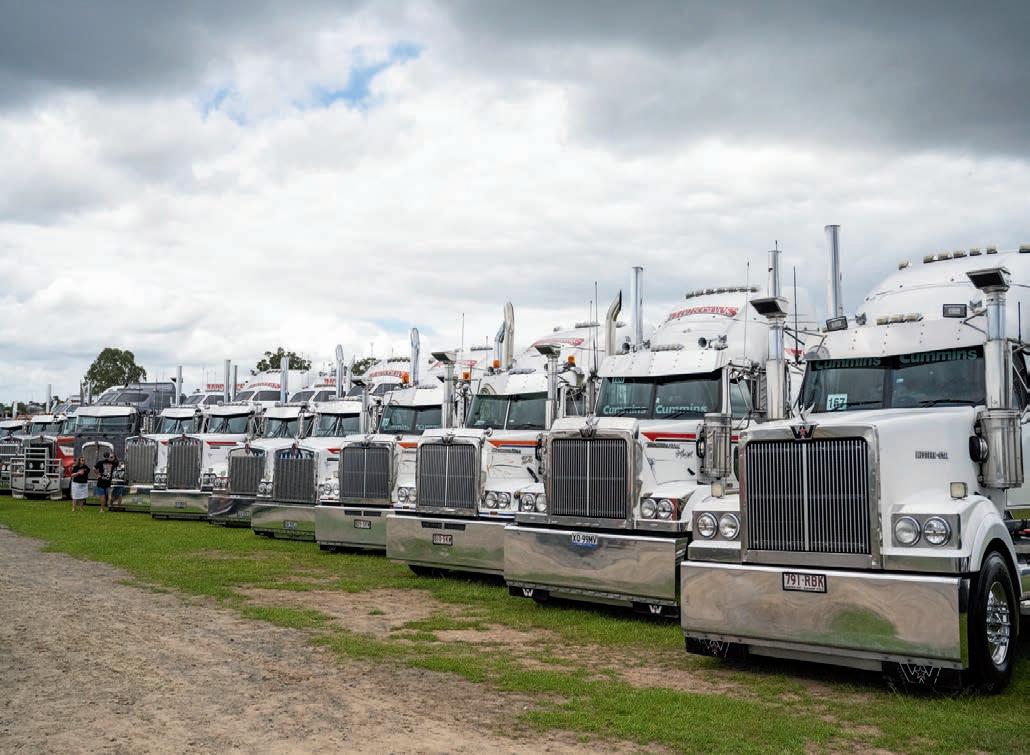





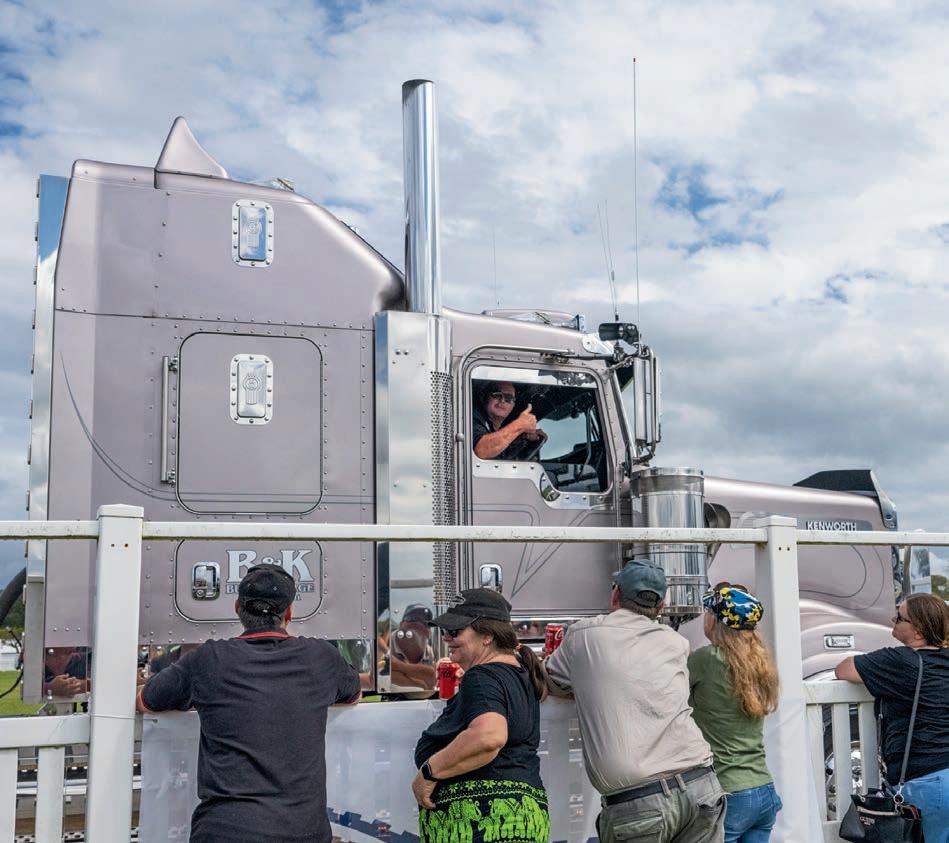





There is something for everyone. It’s a family friendly event raising funds for a very important cause. I can’t wait to attend next year’s show and, fingers crossed, by then they’ll have a bookie and butcher on hand for the pig racing.
Top, L to R: The Morgan Transport fleet tied for the Largest Fleet trophy; Just a little bit of posing from one of the security guards
Middle, L to R: Mackay and Sons were represented by Andrew Bone, Brendon Roy, Toni Papa and Dean Crompton – and a stunning line-up of trucks; A big thankyou to Glenn, Gerry, Heidi and Owen from the Gympie Volunteer First Aid Services for their work throughout the day


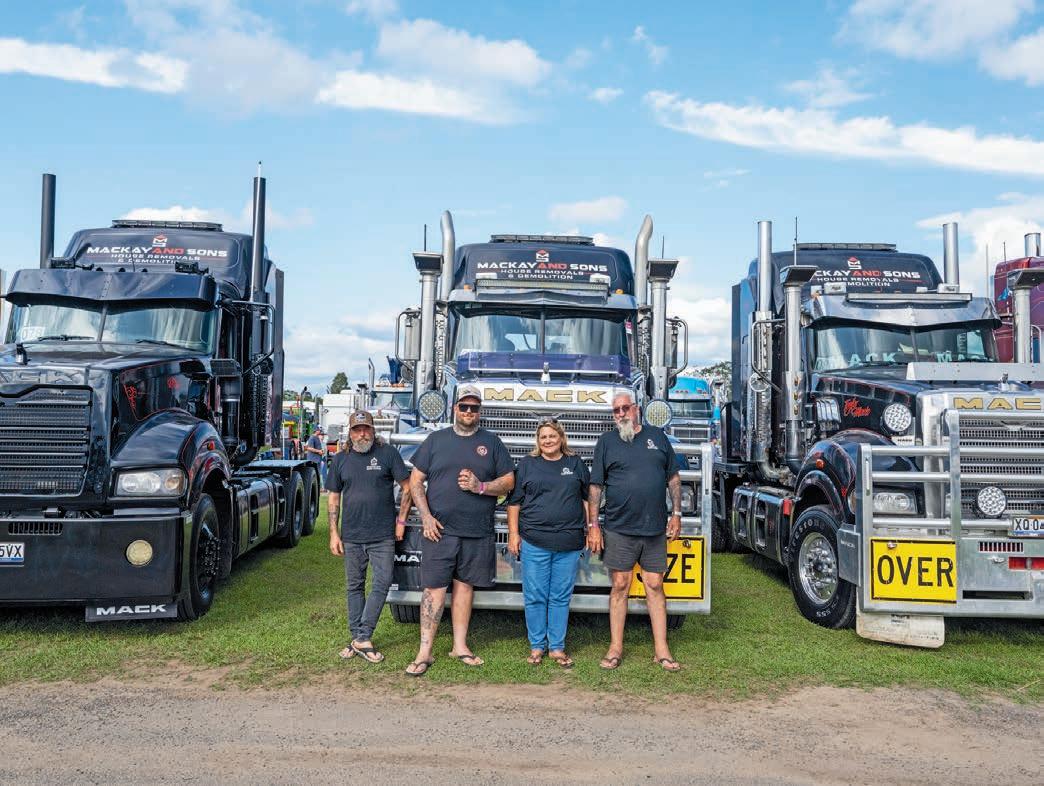
Always a man looking for attention is B&K driver Bryce McGaughy. He spotted the camera and made his presence felt


ownerdriver.com.au
“It’s a family friendly event
funds for a very important cause.”
NATROAD


Warren Clark
Change on the way
Although 12 months away, new unfair contracts law will be a welcome boost for
operators

The recent news that Coles, one of the nation’s largest supermarkets, has written to suppliers to demand they cut costs rather than request price rises comes as no surprise.
Inflation is the ‘word of the year’. It’s the genie the Federal Government wants to slay and it’s the pressure point for every small business around the country.
Coles is firing a shot across the bows of its suppliers, warning it won’t play ball with any that seek to opportunistically increase their retail price. In correspondence with suppliers obtained by The Australian newspaper in October, Coles said every business should “turn its mind” to reducing costs.

If only the people carting goods between suppliers and their big supermarket customers had it that easy. As usual, the road transport operator is caught in the middle.
A contract the National Road Transport Association (NatRoad) has seen required the operator to find a five per cent “productivity” saving each year during the term of the contract. The operator’s tenure could be ended, without cause, on a month’s notice but the contract is for a five-year term.
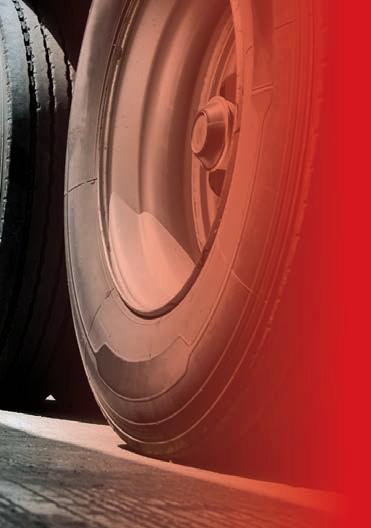
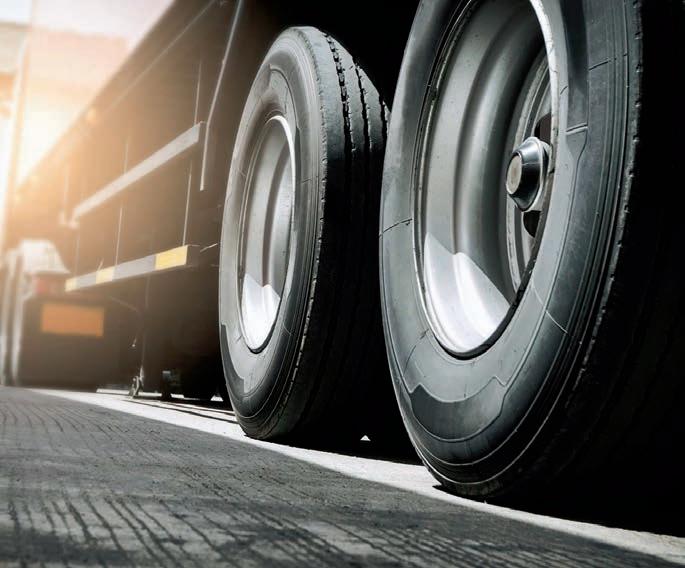
It’s just one example of an onerous and one-sided contract that unfairly puts the weights on operators to deliver on their freight task regardless of circumstances beyond their control. If an operator’s costs rise, they have little or no option but to absorb them.
We’ve seen contracts where the price falls each year over the life of the contract, with the operator required to

take a price hit each year in the name of productivity.
For far too long, it’s been a case of “like it or lump it” if a small business didn’t like the unfair terms of a contract with a big customer. Not anymore.
BILL REVIVED
By the time you read this, new national unfair contracts legislation will have


become law. It’s something that NatRoad constantly lobbied for over the years. The draft legislation made it into Parliament right before the Federal Election, but too late to pass. Thankfully, the draft Bill was revived in the life of the new Parliament.
There was a lot to like about the Bill. It strengthens the remedies and enforcement of the current regime by prohibiting the proposal of, use of, application of, or reliance on, unfair contract terms in a standard form consumer or small business contract.
It creates new civil penalties for breaches and it allows a court to make orders to void, vary or refuse to enforce part or all of a contract.
And it expands the class of contracts covered by the unfair contract terms provisions.
Most importantly the changes will introduce a financial penalty and increase the number of small business contracts to which these laws apply.
There were legal remedies available –but they cost an arm and a leg to access as courts needed to impose an order.
The legislative wheels turn slowly and all these changes will take 12 months to come into force. This is to enable industry to make any necessary changes, including examining contracts that might be used once the legislation is in force.




But change is coming and we believe it will make a difference.
NatRoad communications are intended to provide commentary and general information. They should not be relied upon as legal advice. Our advisers are available to clarify any questions you have and provide the right advice for your business and workforce. Contact Richard at richard.calver@natroad.com.au, or on (02) 6295 3000.
DECEMBER 2022 31 ownerdriver.com.au
WARREN CLARK is CEO of the National Road Transport Association (NatRoad).
“If an operator’s costs rise, they have little or no option but to absorb them.” MOUNTING PLATE OUT-OF- BALANCE POINT DURAMETAL SPHERES IN DAMPING FLUID CIRCULAR TUBE NEVER BALANCE WHEELS AGAIN! 1300 822 765 www.centramatic.com.au INCREASE TYRE LIFE up to 35%+ SAVE TIME. No more hassles getting wheels balanced THELARGEST CAPACITY to suit even super single tyres AUTOMATICALLY BALANCES your wheels while you drive EXTENDED suspension life. REDUCED vibration. SMOOTHER ride. AVAILABLE FOR US, European and large Japanese trucks CIRCULAR TUBE OUT-OF-BALANCE POINT MOUNTING PLATE DURAMETAL SPHERES IN DAMPING FLUID UNBALANCED WHEEL Balancing weights move opposite the out-of-balance point.
Q: How did it feel to accept the award?
A: It was a real honour; I’ve been working in the transport industry all my life but being so young I never expected anything like an award that’s for sure.
Q: Did you ever think you would win?
INDUSTRY BORN AND BRED
Hugh Paton recently had the honour of becoming a ‘Young Achiever’ co-winner at the Queensland Trucking Association’s Freight Industry awards. Hugh works as the operations manager for Sizer and Cogill in Townsville, Queensland. He sat down with OwnerDriver’s Julian Daw to talk about the award, his life around trucks and his passion for the transport industry
A: No way, I never expected any of this to happen that’s for sure. I just thought someone had to show up to the event because my company was part of the association and had tickets to the dinner event. I honestly had no idea I was to be the winner until the moment they called my name out at the show.
Q: How did the nomination come about?
A: We’re part of the QTA (Queensland Trucking Association). The person we deal with there nominated me. She has a lot to do with our business up here in Queensland. I was really busy at the time and tried to say that I couldn’t make it to Brisbane for the show. I kicked and screamed and told my boss I wasn’t going to be there. He came to me and said I had to go whether I liked to or not. So I begrudgingly got on a plane and flew over, went to the show. And bugger me dead I won the award.
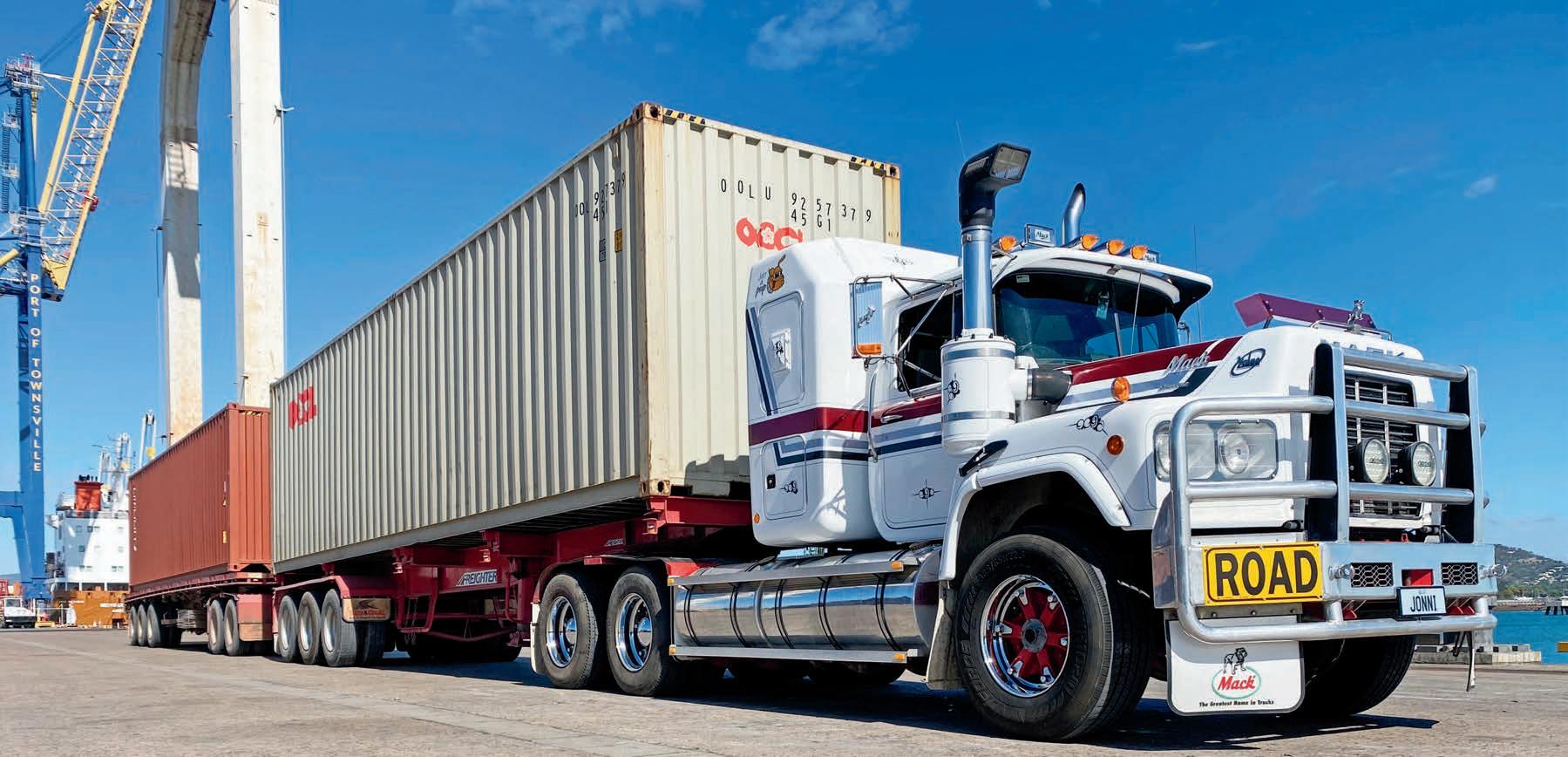
Q: What’s your background in the industry?
A: I’ve born into the industry; my dad has a transport logistics company and so there were always trucks around when I was growing up. I’d come home from school and wash trucks or on the weekend help out. Then as soon as I could get my licence, I was in a truck every chance I could get pretty much.
I had a mind to stay out of the trucks when I left school though, I wanted to become a diesel mechanic. I just didn’t think the lifestyle would suit me, it’s such a tough job. But it’s still in my blood, I can’t avoid it completely. Even now every now and then I still like to get away for a drive.
After school I did a dual apprenticeship as a diesel mechanic and an auto electrician. Once I finished that I started my own business as a mechanic and a contractor and that’s how I got involved with Sizer and Cogill, who I work for now, because I was a contract mechanic for them.
Chris Sizer, the director, then asked me to move to Townsville. I worked for them as a mechanic for a short time but then was soon in a truck helping out. With the driver shortage they needed all the help they could get, and I had my heavy vehicles licence already so I just

32 DECEMBER 2022 ownerdriver.com.au
industry profile
jumped in and started driving.
Everything really changed for me one Sunday afternoon when I was sitting having a beer and my boss Chris suddenly comes and says to me, “Here’s my phone” and handed me his work phone. He wanted me to be the manager while he was away just like that; we seriously did the handover the morning he was leaving. He just said, “You’ll be right”.
So that’s how it all started. I was proper worried about it at first, I told him no way this is happening. But then I just grabbed it with both hands and now 18 months later I’m still doing it.
A: The peace and the quiet and the long drives, the people you meet up and down the road. As well as all the challenges you come up against out in the bush.
Q: What’s the biggest challenge you face in your role now?
A: At the moment it’s not having the young fellas in the industry. I really don’t know what the future holds for transport in this country. Kids these days are pushed to either go to uni or do an apprenticeship. And even if young people do want to work, because of the insurance, no one wants to employ anyone under 25 most of the time. Unless you’re born and bred into the industry it’s very hard to get a start.
Q: What do you have to say about the state of younger people in the transport industry?
A: It’s a shame there isn’t more young people working because it’s a tight knit community and a lot of fun really. There’s so many opportunities and different experiences, you get to see the country too.
The QTA has now come up with their apprenticeship program which I think is a good thing for the industry to bring more young people in. But there’s a massive gap there between the older folks who are working and the younger people coming through.
Q: What do you think is stopping young people from joining the industry?
A: The fact that you must be 25 before anyone will give you a real start in the industry. Most people, by then, have already started their career pathway, they’ve done an apprenticeship or gotten a university degree. It’s very hard for younger people to get a start. The only reason I was able to get a start before then, and I think this is the rule generally, is because I was born into it and started working with trucks from a very young age.
Q: What does the future look like for you?
A: I’m keen to keep on as operations manager of Sizer and Cogill for a while, we’re growing a lot now with 24 trucks that we have moving around.
Q: How do you think the industry will change in the future?
A: Employers will be forced into using electric trucks if the shortage of drivers continues.

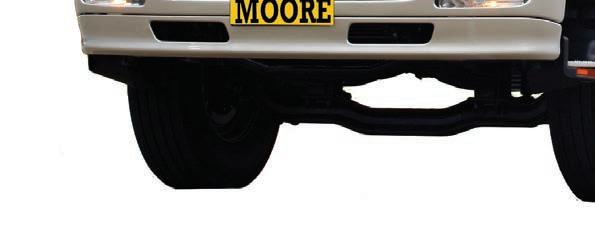
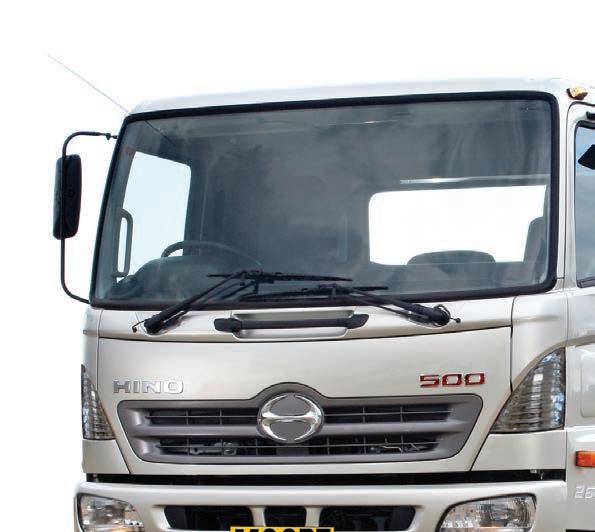
the driver shortage
Above: Hugh Paton was a surprised winner during the Queensland Trucking Association’s Freight Industry awards

Opposite top: Hugh occasionally gets behind the wheel. Here he’s delivering containers to Townsville’s port in an evergreen Mack Valueliner
Opposite bottom: Harvest time in Central Queensland for these Sizer and Cogill Western Stars
DECEMBER 2022 33 ownerdriver.com.au
“With
they needed all the help they could get.”
Q: What do you enjoy about truck driving and working in your industry?
www.mooretruckparts.com.au Unit 3/10 Bluett Drive, Smeaton Grange NSW 2567 Toll Free: 1800 044 909 Unit 3/10 Bluett Drive, Smeaton Grange NSW 2567 Toll Free: 1800 044 909 RRP. $400 +GST $360 CALL US NOW 1800 044 909 A PAIR. +GST SAVE $40ea TO TAKE ADVANTAGE OF THIS AMAZING DEAL EXCLUSIVE NEW ARRIVAL NEW ARRIVAL BRAND NEW QUALITY AFTERMARKET WITH 2 FUNCTIONS FLASHING OR STROBING. To suit Hino: Ranger Pro (2003-2017) FY700 (2004-2018) FS700 (2004-2018) Sold only as a pair. While stocks last.
TWU Michael Kaine
Seats at the table
Through consultation, the Federal Government is steadily lifting road transport out of the dark days
As we head into another busy Christmas period, it’s safe to say it’s been a challenging year for owner-drivers. While many industries are shutting down as we head towards the end of the year, demand in road transport is ramping up – and so is the supply chain pressure on drivers and transport operators.
The lead-up to the busiest season for road transport is a daunting and exhausting prospect following a string of tough years. Throughout the pandemic, we’ve seen drivers work longer hours than ever before, all while having to put themselves and their families at risk to keep supplies moving around the country. Prior to the pandemic we faced devastating bushfires, drivers and operators once again stepping up to help communities in need.
The past 12 months, of course, has had its own unique challenges.
At the beginning of the year we saw supply chains crippled as COVID exploded through workplaces, with workers not guaranteed free rapid antigen tests, and many forced to go to work sick. Under the Morrison government, workers’ concerns and warnings about protecting supply chains were ignored at every turn.

Continued flooding across the eastern states has further stretched drivers and operators already under immense pressure. Drivers have had to deal with blocked roads, disruptions to rest areas and, for those in states not flood-affected, widespread stand-downs.
Fuel and operating prices have skyrocketed, bringing with it the need to push back on supply chain demands, all of which can introduce immense pressure to drive tired, overload, cut back on maintenance or take risks on the road to make ends meet. Devastatingly, over 150 people have died on our roads in truck crashes this year.
We know that these external events and pressures – which disproportionately impact road transport compared to other industries – will keep happening.
But by working and fighting together, this year we’ve also seen huge breakthroughs in our fight for a safer and fairer road transport industry, that will allow drivers and transport operators to respond to these kinds of crises and financial pressures more safely.
FAIR STANDARDS
In May this year, as the newly minted Federal Government came into power,
we have had our most significant advance in years towards a safer, more viable and sustainable industry.
At the beginning of September, Workplace Relations Minister Tony Burke announced the Federal Government’s intention to empower the Fair Work Commission to set fair standards for the entire road transport industry.
Building on Senator Glenn Sterle’s comprehensive two-year inquiry hearing from dozens of road transport workers, Burke’s commitment will save trucking jobs, businesses and lives. It will do that by ensuring that those entities reaping the economic benefit from the industry – major retailers like Aldi, the big manufacturers, miners and the like pay their fair share in transport supply chains and do not engage in contract bullying tactics so that standards lift throughout the industry. This commitment would not have been possible without the unprecedented unity of our industry. Leading the charge were workers, with hundreds of owner-drivers, employee drivers, gig workers and couriers joining convoys around the country calling for reform.
An industry round-table ahead of the Federal Government’s Jobs and Skills Summit drew together a crossindustry coalition calling for reform which included the Transport Workers Union, the Australian Road Transport
Industrial Organisation, NatRoad, the National Road Freighters Association, state transport associations, transport operators like Toll, Linfox, ACFS and FBT Transwest, and even supply chain clients Woolworths and Coles.
Following years of campaigning, gig giants Uber and DoorDash have even backed in the need for reform. Though they may seem unlikely allies, they too now face the threat of being undercut out of business by new entrants in the lawless gig economy which would accelerate the downward spiral of standards and make it even harder to run a sustainable business in transport. Standing shoulder to shoulder, we can turn the tide and inject sustainability back into the operation with new laws that back in a level playing field.
It could not come at a more urgent time. Crucially, the new system will apply to all sectors including the tsunami of the gig economy. The gig economy today is not just food delivery riders and rideshare – it has now entered the heart of freight.
PIECE RATES
In 2022, we’ve seen FedEx become the first traditional transport company casualty of the Amazon Effect in dragging down standards.
FedEx’s appalling proposal was to bring in owner-drivers on piece rates, made to deliver as many as 93 packages per 10-hour shift – the equivalent of one every six minutes or risk being sacked.
Forced to compete with bottom-feeder Amazon, this trend towards shocking conditions on a take-it-or-leave-it basis is the greatest threat our industry has every faced.
This is the Amazon effect in practice, and the gig-style model threatens to effect other major transport companies, followed by the rest of the industry, if it’s not reined in.
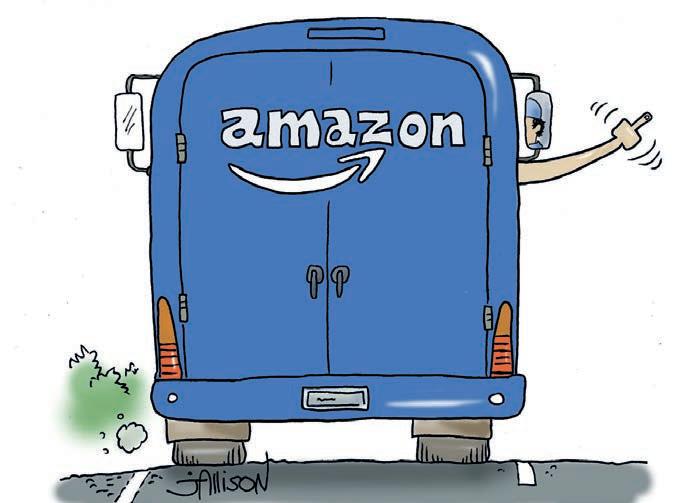
But the Federal Government’s commitment will mean Amazon would no longer be able to import the same deadly tactics it’s used to attack traditional operators in other countries, dragging down industry standards and gaining unfair and dangerous economic advantage by exploiting transport
workers through on-demand gig systems.
Between natural disasters, the lingering effects of the pandemic and operating costs, it’s been a tough year in 2022. But as we head towards 2023, there is hope on the horizon for a road transport industry where all can prosper from a level playing field.
We finally have a Federal Government that is prepared to listen to workers and give you a seat at the table. Our job now is to make sure it follows through on its commitments.
In 2022 we have become closer than ever to a safer, fairer industry with Labor’s commitment to enforceable minimum standards. In 2023 we will need to ramp up our efforts to make this a reality.
34 DECEMBER 2022 ownerdriver.com.au
MICHAEL KAINE is the national secretary of the Transport Workers Union of Australia. Contact Michael at: NSW Transport Workers Union, Transport House, 188-390 Sussex Street, Sydney, NSW 2000. twu@twu.com.au
“A take-it-or-leave-it basis is the greatest threat our industry has every faced.”
VERSATILITY YOU CAN RELY ON



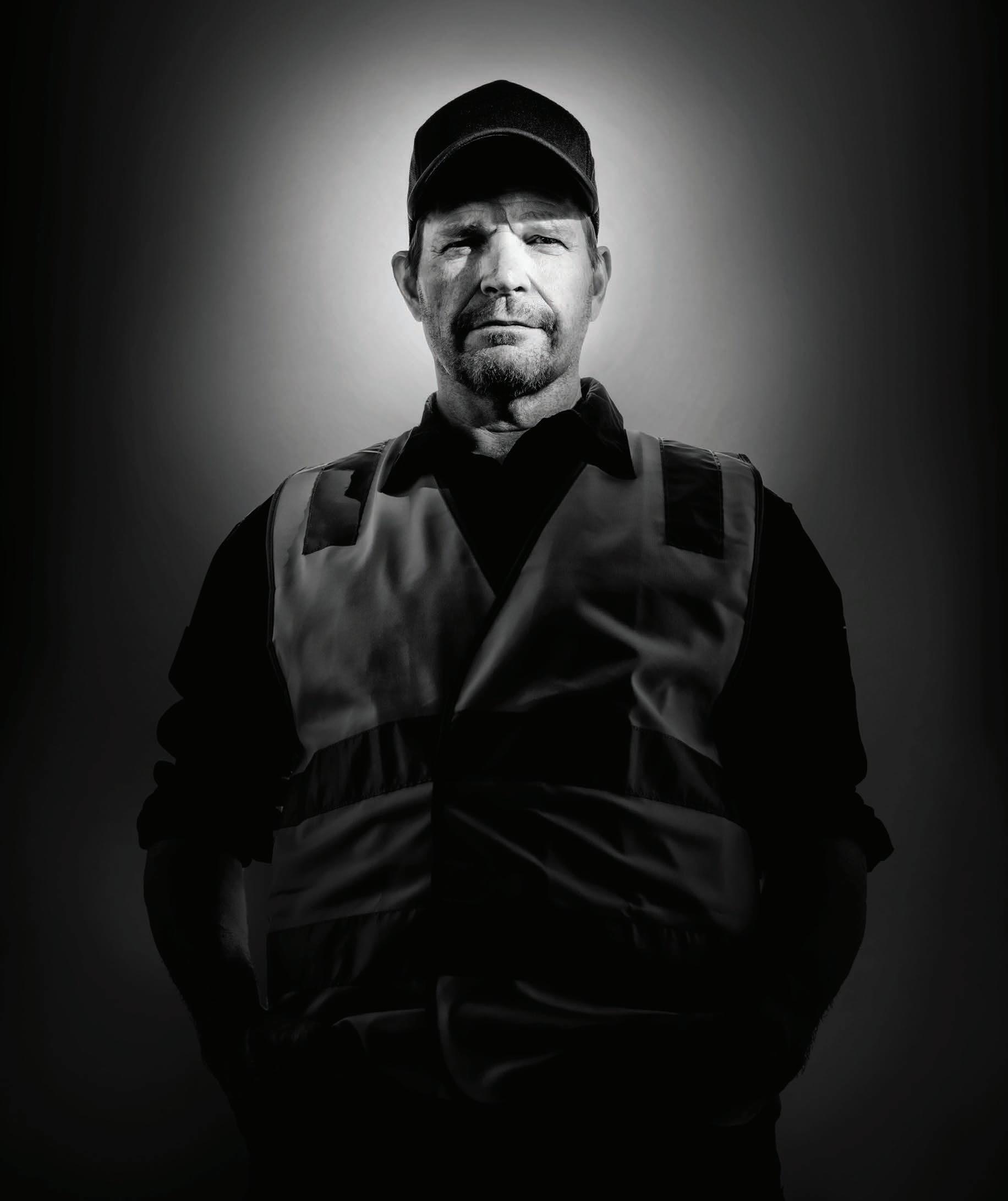
CASTROL RX SUPER - RELIABLE VERSATILITY



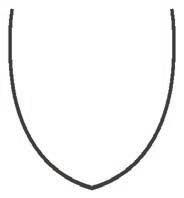
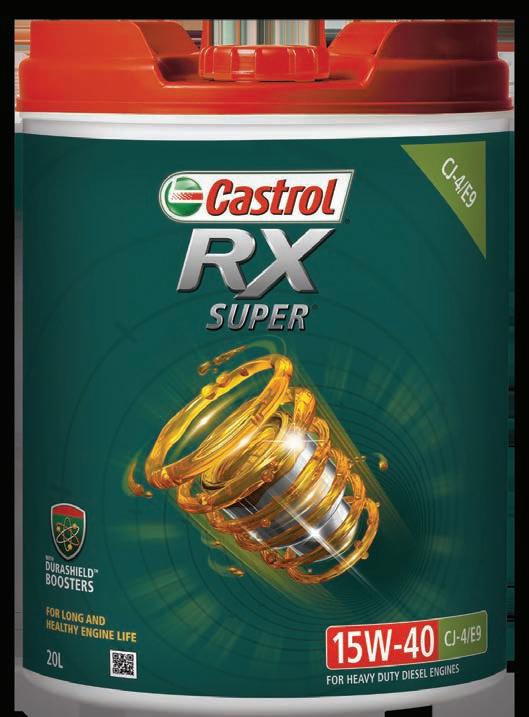


Whatever the season demands you rely on improved Castrol RX SUPER to get things done. The versatility of the upgraded CJ-4 specification combats soot and gives critical moving parts a tougher protective layer. New DuraShield BoostersTM giving up to 40% better protection against wear*. Improved Castrol RX SUPER - as versatile as you are.

IMPROVED TO DELIVER UP TO 40% BETTER WEAR PROTECTION*
truck of the month

PATLIN’S EAGLE
36 DECEMBER 2022 ownerdriver.com.au
ROCKS
It was a break-up that had to happen as Joe Papaluca of Patlin Heavy Haulage reluctantly passed the keys of his much-loved International Eagle 9900i to young driver Jayden Perry.
Warren Aitkens investigates
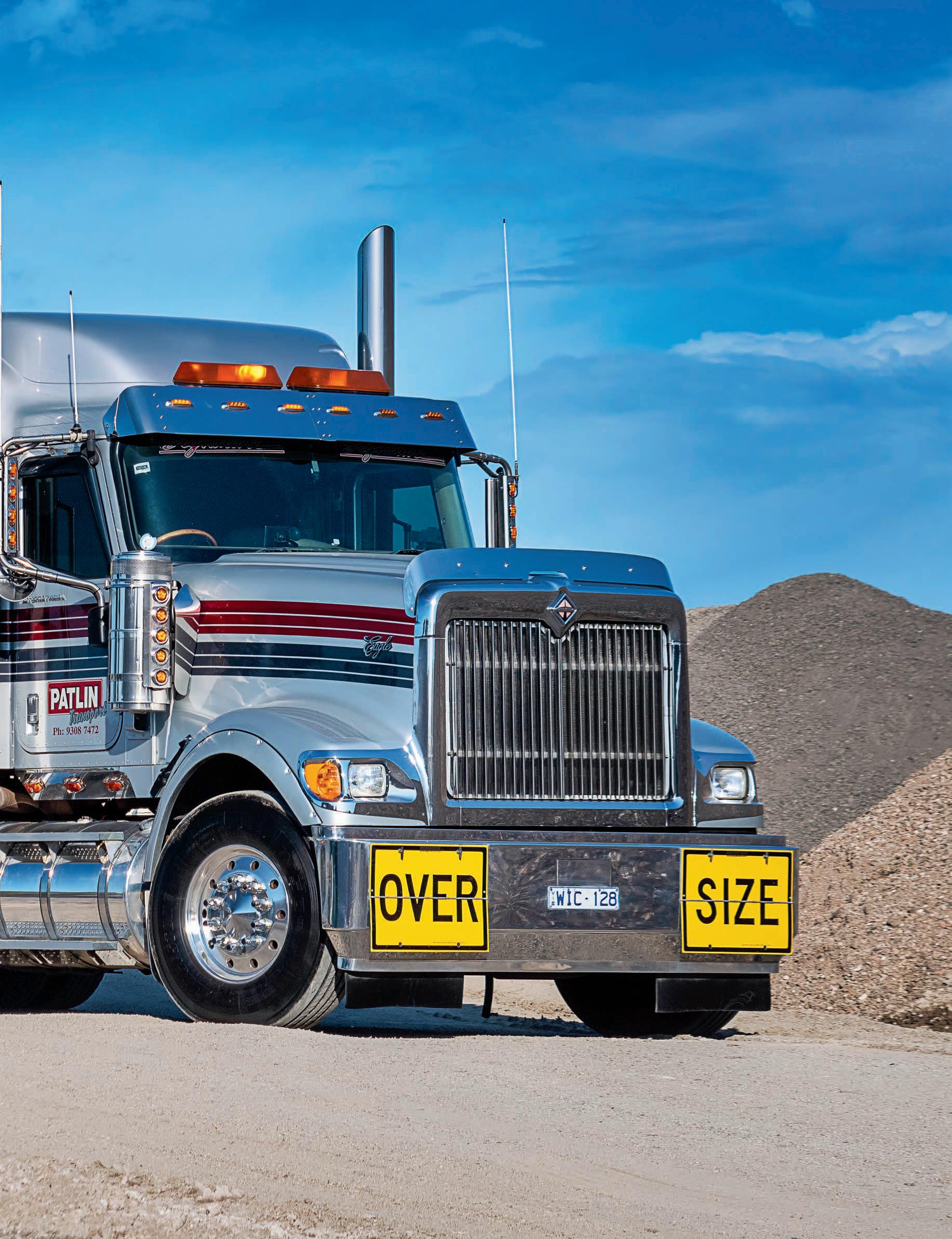
DECEMBER 2022 37 ownerdriver.com.au
ACCOs and
T-lines
Let me set the scene for all the avid readers out there. It is Monday morning as I sit in my office (sauna) here in balmy Queensland. The fan is recirculating the humid air as I try and avoid breaking out the air-con too early –I’m all for saving the planet and that kind of stuff.
I’m at my desk with my laptop open, Microsoft Word on the screen and the Patlin Heavy Haulage opening title ready. I can feel my editor’s glare from his office 50-odd kilometres away near the city as he once again waits for me to get my story in, hopefully close to the deadline.
I know I should start typing, however behind my laptop are the screens for my PC. The screens are awake, with lightroom running and the images of Patlin Heavy Haulage’s International Eagle 9900i on full display. Two screens with two different angles of this stunning truck, but instead of typing out the story I am writing an apology email to the editor because quite frankly I’m just far too distracted by the photos to be productive and my deadline has gone whizzing past.
The International Eagle 9900i is one of those iconic trucks that just seems to catch every truck lover’s eye. It has a shape and style that distinguishes it from all others. Much like the Ford LTL, a squared off Super-Liner or those stunning ’80s SARs.


Therefore, it really isn’t my fault that I’m struggling to get my story in before my deadline. I’m fighting a good fight but just look at how cool this truck is. Go on, have a look. I’ll wait.
Was I right or was I right? The Patlin Heavy Haulage Eagle is simply spectacular, the credit for it going to not just the driver Jayden Perry but the entire Patlin Heavy Haulage family. Well, it is 90 per cent Jayden who goes to bed dreaming about rewashing his truck.
However, we will get back to Jayden and his dedication shortly. Let’s first focus on the Papaluca family, their affiliation to all things International and the incredibly successful company that this Melbourne family has cultivated over the last 30-plus years.
trailer supplier for Patlin Heavy Haulage these days.
Last but not least is youngest son Steve. Steve is heavily involved in the company and currently drives one of Patlin’s stunning C509s doing the big shifts.
Backbone brand
As I mentioned earlier, the Papaluca family have been massive International supporters, the brand being the backbone of Patlin’s success. Pat’s entrance into transport began with an F Model Mack back when he was just 19. That was his first truck and, coupled to a backhoe, it was the beginning of Patlin Transport.
Over the years as the fleet grew the little Mack became a forgotten friend. It was all International.
Right: It’s hard to believe the Eagle is 15 years old and nearing a million kilometres
Opposite top and underneath: Joe Papaluca stands with the Eagle, a favourite with not only him but also his dad Pat and driver Jayden; Hidden away in the back paddock is the big TranStar, ready for another rebuild project … eventually
My tour guide for the Patlin Heavy Haulage history lesson is Joe Papaluca. Joe now fills the role of operations manager for the business, having previously done his time behind the wheel and behind the tools. He has known nothing other than the family business. His entire youth was spent either in the passenger seat of a truck trying to see over the dash or in the workshop with dad learning how to rebuild a truck. It was the life every young truck nut aspires to.
Joe is the oldest of Pat and Lina Papaluca’s three sons. The other two boys are also heavily involved in the family business.
Second son Matty works as a Drake trailer mechanic, so while not directly in the family business he spends a fair bit of time working on the company gear, as Drake is the predominant
38 DECEMBER 2022 ownerdriver.com.au
Above: There’s plenty of room inside the old Eagle
“The
the
were dad’s bread and butter t rucks.”
“The ACCOs and the T-lines were dad’s bread and butter trucks,” Joe says. “They were a money maker’ they were a working truck”.
As the company grew there were a few other brands gracing the company colours, but the Patlin yard was dominated by T-lines, S-lines, TranStars and ACCOs. There wasn’t a lot of new trucks, however.
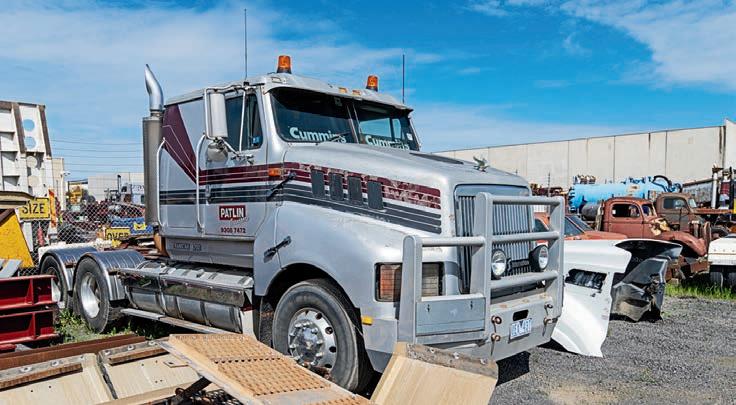

You recall I mentioned that Joe spent a fair bit of his childhood in the workshop helping dad. Well, that wasn’t just learning maintenance and servicing but also undertaking major rebuild projects. In the beginning buying new trucks wasn’t an option for the Papaluca family but refurbishing old ones definitely was. Those self-taught skills helped save a lot of money and allowed the family to put solid reliable trucks on the road.
Pat Papaluca recalls the expense of a new truck back in those early days. “At the time I really wanted a brand new TranStar,” Joe’s dad Pat tells me. “But they were about 160 grand and I just couldn’t afford that. So, we found an old wreck, bought it and
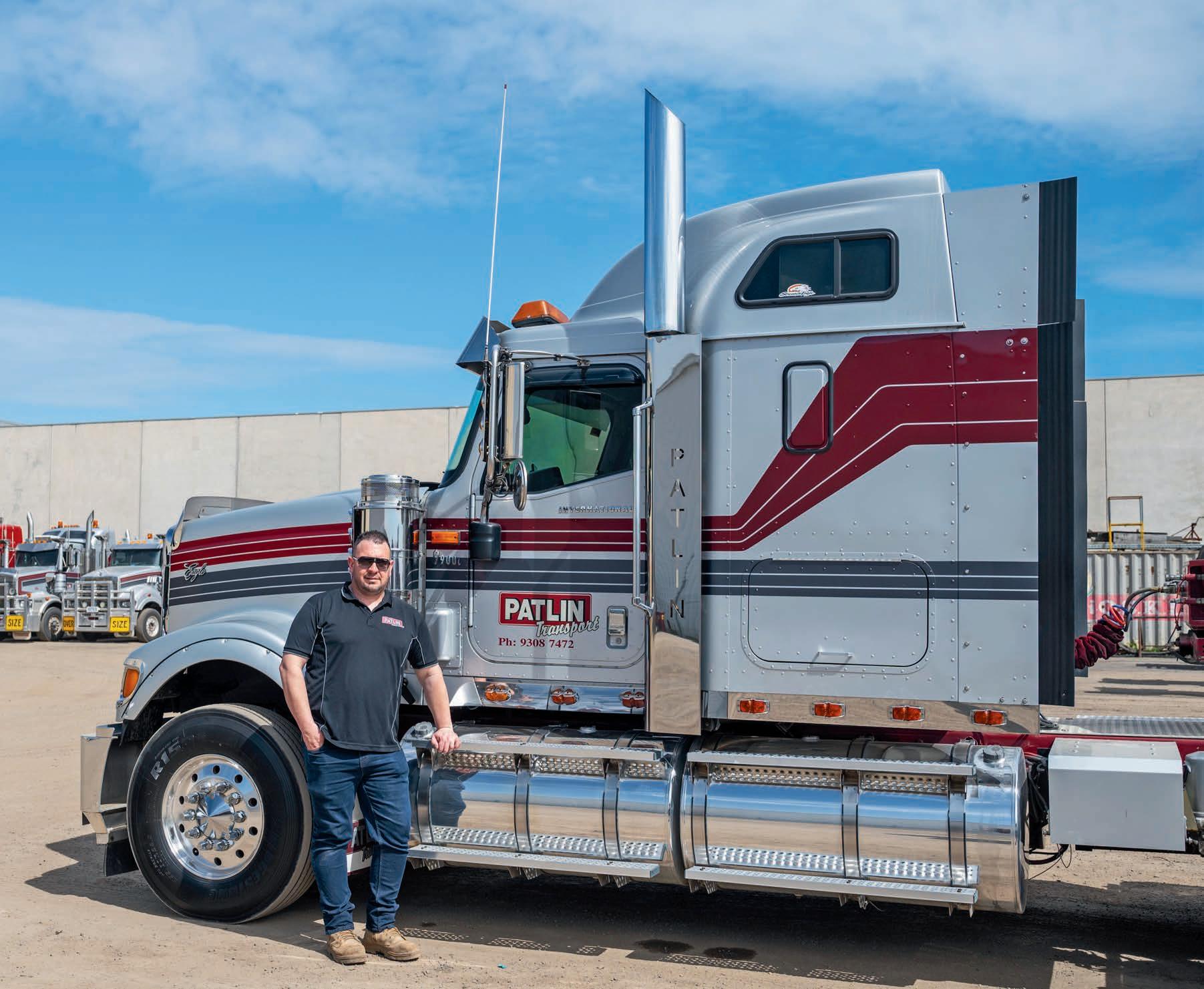
DECEMBER 2022 39 ownerdriver.com.au







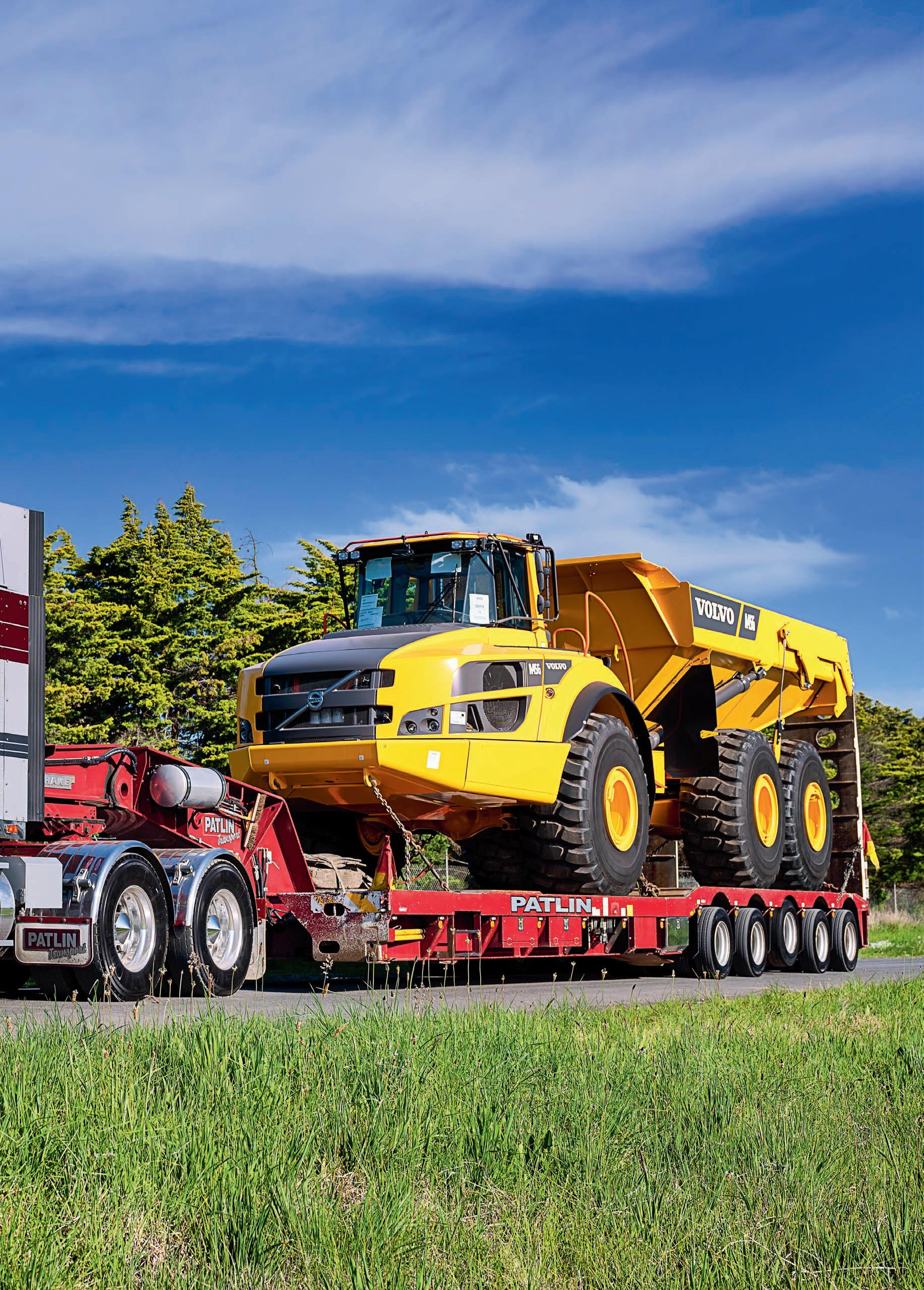
Opposite top: Jayden Perry is extremely proud of his ride and keeps the old girl in impeccable condition
Below: Sadly there’s less Internationals in the fleet these days but the Kenworth badge is well represented
completely rebuilt it and it’s still with us now.”
Joe is quick to point out though that it is a little worse for wear now. “But we’ve held onto it because we will do it up again.”
There’s a fair bit of sentimentality towards Patlin’s first TranStar, not just because it was such a big rebuild but also because it was Joe’s first ‘legally driven’ truck.
The TranStar was one of many rebuild projects carried out by the company, that mechanical propensity allowing Patlin to stay more than competitive. They knew their trucks inside and out and the result of that was mechanical reliability, which in turn pays dividends out on the road.

Even today, while there are far less rebuild projects, the workshop side of Patlin Heavy Haulage is still extremely busy with a huge emphasis placed on servicing and maintenance.
Goin’ heavy
Those familiar with the business will know that the fleet is primarily Kenworth now; the International badges are harder to find. That swing in priorities parallels their business specialty. Up until the mid-’90s Patlin Transport was all about tipping work. At
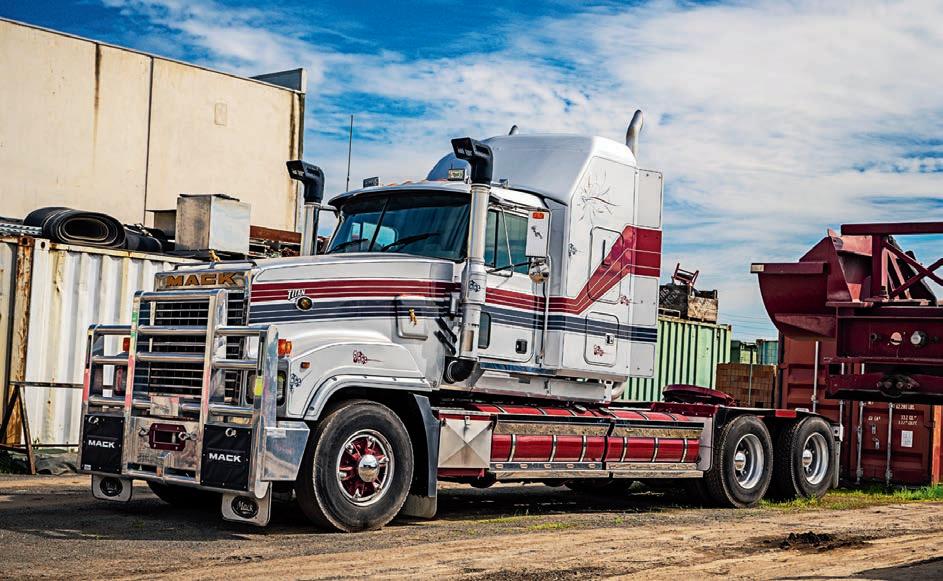

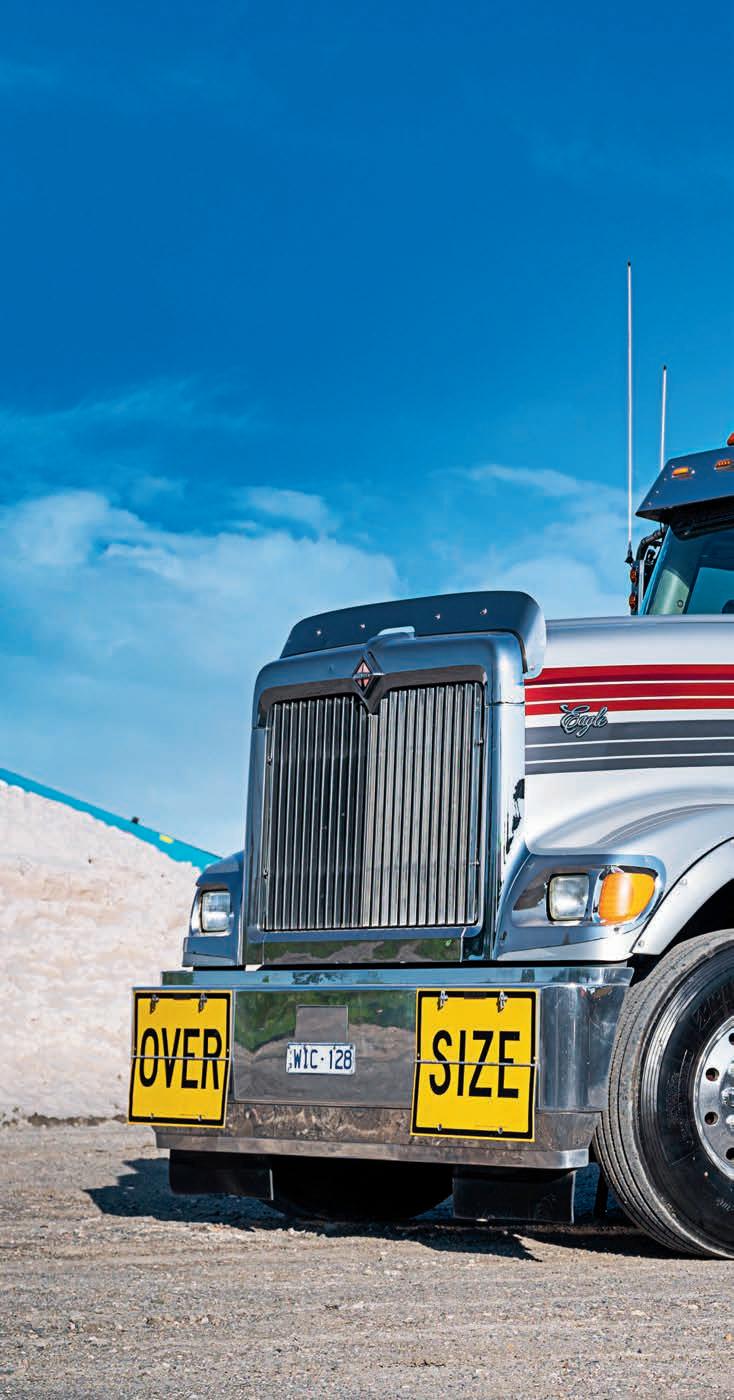
its peak there were over 15 tipper setups, from truck and dogs to semi tippers. Alongside the Patlin trucks were another 50-odd subbies.
The transformation to a heavy haulage company began in 1998 when several customers were asking for assistance moving some of their construction equipment around different Melbourne projects.
“The first heavy haulage unit we had came in 1998,” Joe recalls. “It was a brand new Brentwood folding gooseneck trailer and an old Atkinson.” The Atkinson was neither a new truck nor a rebuild project, it was one of the company’s tippers before Pat removed the body and turned it into a prime mover.
According to Joe, Pat’s words were, “I’m not buying another truck to run this outfit.” I’m assuming he didn’t see heavy haulage becoming a big part of the company.
It didn’t take too long before a second Brentwood trailer was added, one of the first rear-steer quad axle trailers in Victoria. Then along came a second-hand 1993 International S-line. The big S-line was an ex-Army cancelled order, so it was the first real heavy spec truck for Patlin Heavy Haulage. All of a sudden
42 DECEMBER 2022 ownerdriver.com.au
Top: Patlin Transport and Drake trailers go hand in hand these days
Above: Another classic truck found in the Patlin yard is this old hard working Titan
the company was moving away from tipping and focussing on heavy haulage.
By 2003 there were five or six floats in the rapidly expanding Patlin Heavy Haulage fleet. The tippers were all but gone, except for those trucks that could be repurposed into heavy haulage. The big TranStar was one of those that made the switch.
“We did have a fairly old fleet on the heavy haulage stuff,” Joe recalls. “We’d done up a couple of K100s as well.” Then in 2007 along came their local International salesman, Michael Zielinski from Adtrans, who steered them away from rebuilds and eventually to the stunning Eagle.
“Yeah, the local International rep came along trying to talk us into an Iveco. He tried to sell us a Stralis and we just said, ‘sorry Mick, you’re a great bloke, but
nah’,” Joe laughs. “So he said, ‘Are you interested in the Eagles?’”.
Joe admits that he hadn’t really had much to do with Eagles but as the International badge was damn near tattooed onto the family crest, they happily took possession of a day cab version for a week to test it out. “I loved it,” Joe exclaims.
As it happened there was one just being built at the same time as Joe was falling in love with the demo. It was 135 tonne rated with spring suspension and a 50-inch bunk … and all the rest of it. It ticked all the boxes for Patlin. The day cab demo had won them over and another International joined the fleet.
As much as Joe loved it, Pat informed him that it wouldn’t be his truck. Family or not, Joe was still down the pecking order. The truck was offered to another driver, Tony, who had been with the company for a while – and still is. But Tony preferred to stay in his cab-over. It was Joe’s lucky day. The TranStar was handed to the next driver and Joe took the reins of the new Eagle.
“At first we thought it was a bit big for the local stuff we were doing but It was fantastic,” Joe says. “Comfort wise there wasn’t much difference between it and the TranStar but there was no comparison in power. I went from a 525 N14 14 litre with 1850lb-ft torque ringing its neck all the time to this thing (a Cummins Signature 620) where it didn’t have to work as hard.”
The Eagle was Joe’s pride and joy for five years. Even now, 15 years after it hit the road, young Jayden tells me people in the trucking fraternity still refer to it as ‘Joe’s Eagle’.


When the time came for Joe to transition into the office it meant sacrificing on-road time with his Eagle. But he couldn’t relinquish the keys.
“I’d have it parked in the yard just for when I had to do a run,” he laughs. He was unwilling to let anyone else play with his beloved Eagle.
“It got to a point where it started to deteriorate, the tanks were faded, the bar was fading. I was only driving it maybe once or twice a month,” he says. “So it was time to put a driver in it.”
Joe reluctantly tried introducing drivers to the truck while also trying not to use send it out too often as he tried desperately to make sure it was always available when he had a run to do. “It wasn’t easy, it needed to work but I didn’t want it to do too much”.
Joe admits it wasn’t everyone’s truck of choice, they were seen as a cheap truck. Drivers were preferring the bigger badges that were joining the fleet rather than the Eagle which was by now over 10 years old.
Eagle eyed
Along comes Jayden. Young Jayden is another one of those born-in-the-industry young fellas that takes immense pride in not just the job he does, but the gear he operates.
Getting the Eagle was a dream come true for Jayden. He had first laid eyes on it when he was only 14 and the truck was only about a year old. “Me and dad had gone to Patlin cause dad was borrowing an old 601 and I saw the Eagle,” Jayden recalls. “I said to Joey, ‘I’ll get your big Eagle off you one day’ and he just laughed at me.”
At age of 22, after several years operating machinery, Jayden landed a job with Patlin. His eye was still on the big 9900 and he made that very clear.
By this stage Joe was in the office and the truck
DECEMBER 2022 43 ownerdriver.com.au
“I’ll get your big Eagle off you one day.”
We don’t spend much on bling but probably overspend on paint.”
was at the ‘it sits still until I need to drive it’ phase. Instead of relinquishing his Eagle, Joe put young Jayden in one of the company’s other Eagles, a day cab version. This only fuelled the fire for Jayden, making him keener than ever to get into the big girl. As Patlin helped Jayden progress through the different stages of heavy haulage he went through several of the company trucks, eventually ending up in a K108 doing the big shifts.
Here is where we acknowledge the rewards of persistence, keeping in mind that Jayden admits to badgering Joe every week about taking the Eagle. Setting the scene again, the K108 was in getting a turbo done.
“Joey came out and said to me, ‘take the Eagle and charge the batteries for a couple of days’,” Jayden recalls. “I washed it every day I had it and even told Joey I’d take it on the weekend to give it a bit of a tidy up.” A couple weeks after that taste of Eagle life, Jayden got the call from Joe to remove his gear from the 108. The Eagle was his.
“I was stoked, all my dreams had come true,” Jayden says. It was a truck he loved and a truck he was proud to drive.
He admits the old girl was a little neglected when he was given the keys but that was two and a half years ago and there is no neglect to it now. “I clean it all the time,” Jayden admits. “Every six months I also get my mate at CIH Truck Shine & Fabrication to polish everything.”
As I look to summarise this story and get myself some more time to enjoy the photos, I do want to acknowledge this hardworking family company. There are many traits that have aided in Patlin’s success. I’m not merely referring to the dependable Internationals that helped build the business. I’m talking about things like their emphasis on professionalism and on-road appearance. Pat has always believed your trucks are your best business card. The Patlin Heavy Haulage colours are as eye-catching as it is simple.
“The colour scheme actually came from when we were rebuilding an old ACCO,” Joe says. “We bought another cab and it had those lines on it.
“We’ve changed the colours a bit. We don’t spend much on bling but probably overspend on paint.”
Above right: Add these two classics to the restoration project list. It’s trucks like these that helped Pat and Lina Papaluca build the company to where it is today

Below: The Patlin workshop is constantly in action. Maintenance and servicing is one of the companies top priorities
It’s not just the look that does it for Jayden though. He has covered vast tracts of the country in the Eagle and praises its ride and performance as highly as its looks. “It’s like a Cadillac of trucks, it rides beautifully.”
As the truck passes its 15th birthday it is still both Jayden and Joe’s pride and joy. I’m sure Joe would love to be on the road a lot more but admits it is reassuring to see how well Jayden looks after ‘his’ truck. “Jayden really does keep it Mickey Mouse,” Joe says.
The emphasis placed on the look of their gear flows onto the workers who operate it. Along with the importance placed on aesthetics, there is huge importance placed on service and maintenance. “Even on the C service we’ll rip out water hoses, cooling pipes – all your heater hoses get replaced. It might cost us a couple of hundred extra but it lowers the risk of one breaking out on a job,” Joe adds.
Then there’s the Patlin team, from drivers that have been with the business for more than 20 years to new workers coming in and learning the ins and outs of heavy haulage. Cudos also need to be handed to Patlin for its work in getting more women behind the wheel of their trucks.
“We’ve got two females driving for us now, Kimberley and Jasmine, and they are doing fantastic,” Joe exclaims. “As much as people claim this is a male industry, these girls are killing it. I’d happily take on more.”
The advantage for the likes of Kimberley and Jasmine, along with other newbies to heavy haulage, is Joe and the Patlin team who place a huge emphasis on training and learning correctly.
“Our people are important, they’re our frontline,” Joe says, adding in that he wants them to learn and upskill. “Making mistakes can be a confidence killer in this game so we like to train them up through the ranks.”
When you’ve got a workplace environment like Patlin Heavy Haulage has created, it leads to higher job satisfaction. Add in the fact that they run some amazing trucks and, more importantly are very reluctant to let go of anything that works – just like the stunning 9900i Eagle.
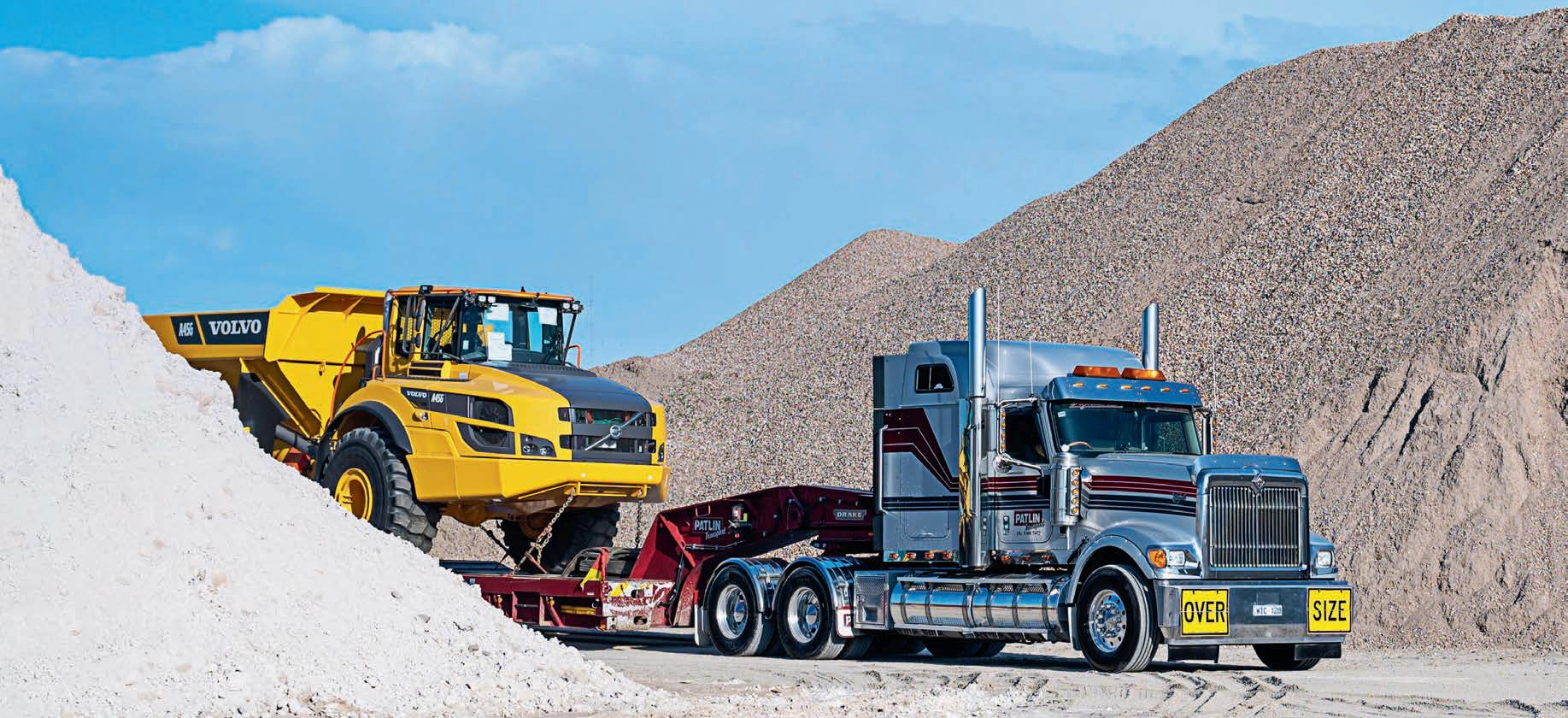

44 DECEMBER 2022 ownerdriver.com.au
A

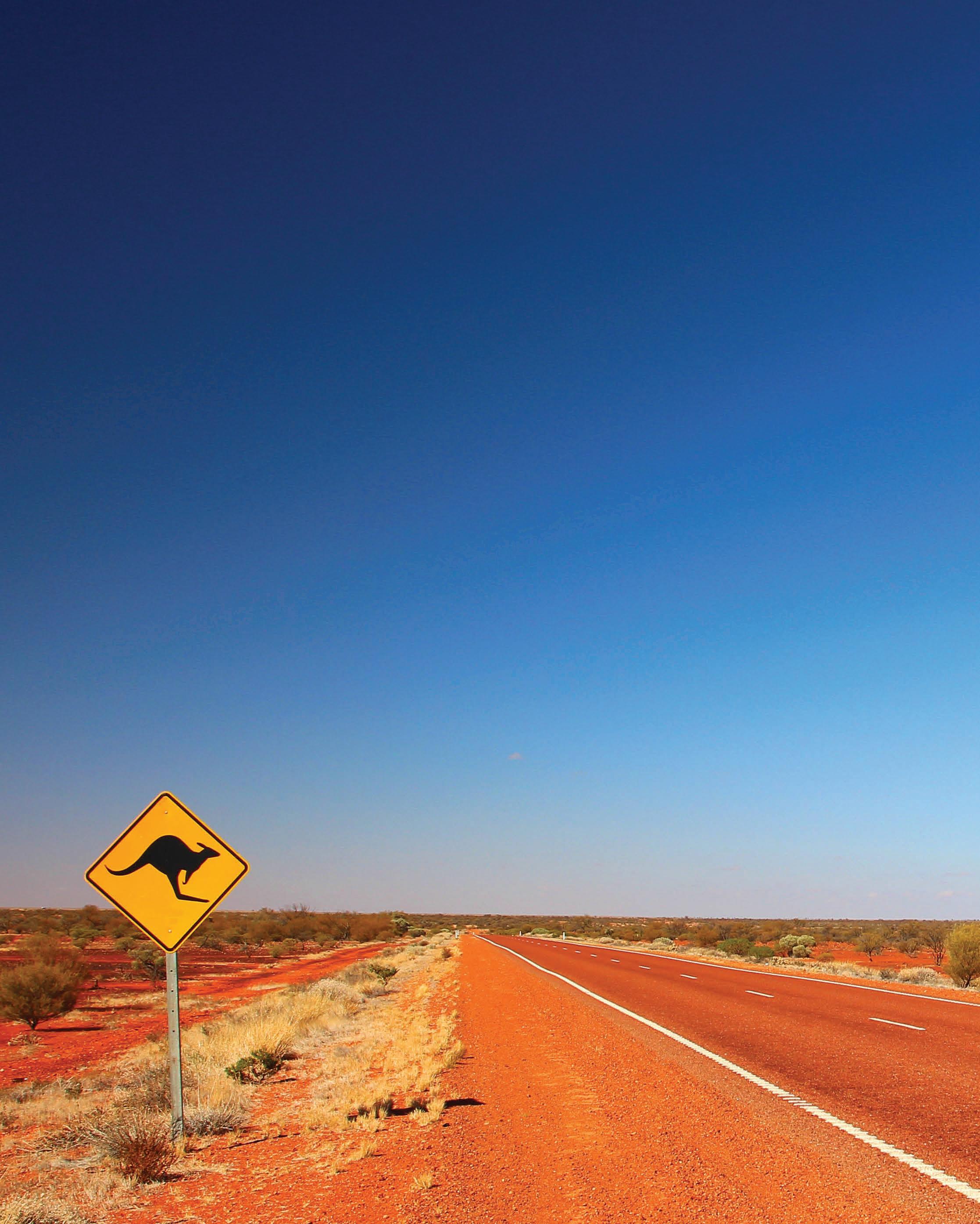
CAN SAVE YOU
fuel,
insurance benefits,
business
rates,
DOLLAR A DAY INVESTMENT –
THOUSANDS! Save thousands of dollars each year on
tyres,
and roadside assistance with NatRoad membership.^ Plus, the NatRoad team can help you with costly
questions like wages,
infringements notices, HVNL compliance and much more. All this for less than a dollar a day per truck.*
NatRoad is the largest, national membership association for the road freight industry for businesses small and large. Join online at www.natroad.com.au or call 1800 272 144
^ Savings made with use of NatRoad membership discounts offered by NatRoad partners. Individual savings will differ depending on use of discounts. * Annual Natroad membership over 12 months.
EYES ON THE ROAD Rod Hannifey

Driver’s seat view
Attending heavy-vehicle related forums is sure way of getting the truckies’ point of view across
Iwas in Mackay for a Heavy Vehicle Road Safety Forum last month, having been invited by Queensland Police. There are many industry issues, the dragging on of the Heavy Vehicle National Law review the biggest, but the on-road issues and the safety of the drivers who do the work is from where I sit too often overlooked. Like too much of our regulations, it’s controlled and policed by those who do not have to do the job!
This meeting, the format and speakers could achieve some change. It was intended to act, not just talk. It had the right intent and that coming from an assistant police commissioner who actually holds a truck licence and drives trucks, is a real and welcome change. Having worked in the area, then and previously, I could raise local issues and yes, there are a few more green reflectors around there now.
I was the last speaker before the panel discussion. This was my list:
1. Education of young learner drivers about sharing the road with trucks, preferably starting in schools
2. The lack of suitable opportunities for sleep for truckies, rest areas, stopping bays and green reflector bays
3. Changes done for road safety that make things worse – Mackenzie River rest area, Capella and Junee Road intersection. Transport and Main Roads (TMR) has installed signs stopping traffic entering from the west
4. BP Paget – how can a government body allow a truck stop on a major highway to have only five truck bays?
5. A fair go from police, National Heavy Vehicle Regulator (NHVR) – education before enforcement
6. Caravans and trucks.
My closing comment (and I am pushing this wherever I get the chance) was that I do not believe we are recognised for the lives we save. We’re only found guilty in the media for the ones we may take and mostly they’re not the fault of the truckie.
I was given a good hearing, took part in the panel session and hope there will be changes to follow. The NHVR, TMR and other bodies were there and listened and replied as needed. Others even commented on the format and want to steal it for use in other states and jurisdictions. I will follow up and keep in touch with those who made it happen and try to keep them honest.
BAD PRESS
Having missed the Transport for NSW Regional Freight Forum in Dubbo, I was then able to attend the one in Narrabri. Again, there has been a change in Transport For NSW. Yes, it has taken a long time and cost me a lot of hair. Others have also pushed and pushed. They are listening, they are inviting some of us and giving us a say and then acting on that. I even managed to speak with the mayor and ask will they reconsider allowing us to park beside Maccas again, but we will have to do our part. We will see!
Too much of the press we get is bad. Yes, sometimes it is meant to show us someone else’s failing so then we can change things, but most of the time it gets out to everyone else and they all think we are all a bunch of wankers.
Please, before you post something, laugh and ridicule someone else, remember the screw-ups you made when you were learning, not just the ones you got caught out for, but the ones you managed to hide or hide from. It is much harder to do now, don’t you agree?
We finally have some specific funding for truck rest areas from the new government. It’s the most ever while I have been on the road and it must be directed and used to help drivers and not controlled by those who will never sleep in such sites, let alone rely on them to stay safe on the road.
Now those who have built us a stopping bay somewhere will say they have done their job and provided us somewhere to stop. But why are most at
ROD HANNIFEY, a transport safety advocate, has been involved in raising the profile of the industry, conducting highway truck audits, the Blue Reflector Trial for informal parking bays on the Newell, the ‘Truckies on Road Code’, the national 1800 number for road repairs proposal, and the Better Roadside Rest Areas Group. Rod is the current president of the NRFA. Contact Rod on 0428 120 560, e-mail rod.hannifey@bigpond. com or visit www.truckright.com.au
the bottom of the hill, around a corner or in a position that you would only stop there if you simply can’t go on because you are concerned another poor tired driver may run into you as you are often only less than a metre from the roadway?
Many bays on the Peak Downs Highway are at the bottom of the hill, some on the Pacific are around corners. It’s a real thrill if you pull out in a loaded truck at 4km/h and two loaded trucks come round that corner. There must be a national standard for stopping bays, not just put in when someone sticks a pin on a map and then say, “we have them”.
IGNORANT DETRACTORS
I had a driver call me a legend – in my own mind. He has his view and is entitled to it but in the last two months, some while on workers comp for my shoulder, I have given up two weeks of my time for industry events. So, what you do say? What have you done? This was the question posed to my detractor. Funny that he had no answer.

Join an association because without numbers we are still, to many, just whinging truckies. Yes, I would like you to join the National Road Freighters Association (NRFA). It will cost you $10 a month and you can then hassle me close up.
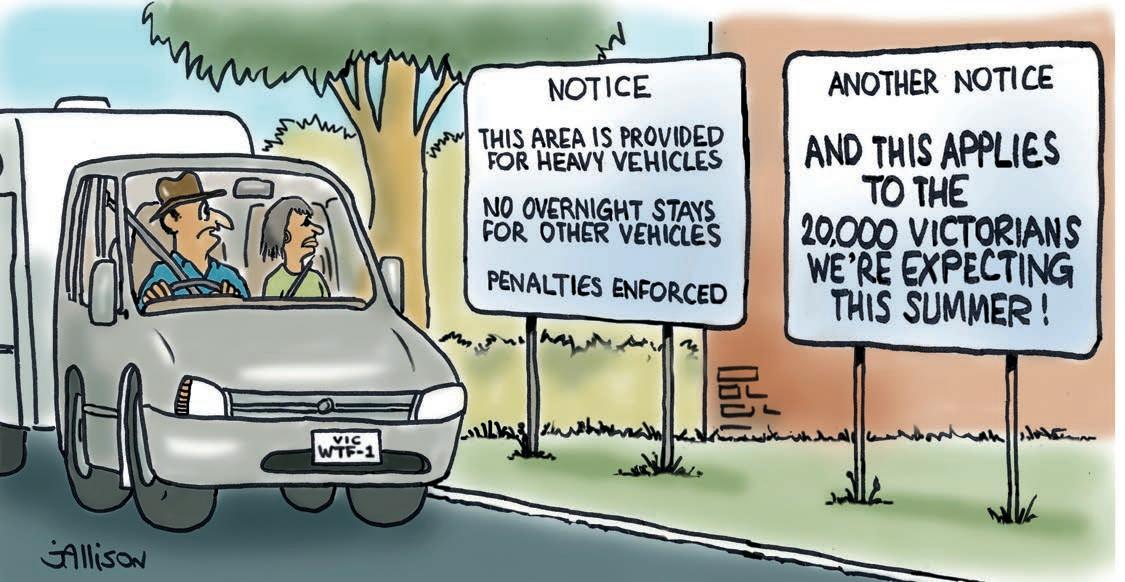
You can join NatRoad or your state association or Livestock, Bulk and Rural Carriers Association or the union, but join one because if you don’t the few of us who try will burn out or give up when ridiculed after wondering why we bothered.
Yes, I am a bit down, but I have not given up yet. There are times when the hundreds of hours you put in will still see someone complain about what you do. Doing it alone is hard and often frustrating, the cost to family and you is often unseen and no one else cares. So why do it? Because I want you and me to both come home in one piece.
Merry Christmas and a ‘Trucking Good New Year’!
46 DECEMBER 2022 ownerdriver.com.au
“There must be a national standard for stopping bays.”
THE LEGAL VIEW Sarah Marinovic

Naming the offender
Speeding fines acquired by a driver in the company name can reach into five figure amounts
In recent months I’ve seen a few transport companies caught out when a speeding fine arrives in the company name. It’s one of those situations where people find themselves with enormous fines, often without realising they’ve done the wrong thing.
The problem occurs when companies fail to send in the nomination of the person responsible for the fine. With maximum fines in New South Wales of up to $22,000, it’s worth being aware so as to avoid the trap.
In NSW when a speed camera catches an offence the fine is sent to the registered operator of the vehicle. That person or business is then required to nominate the person who was in charge of the vehicle at the time of the offence.

If the fine is in a company name it’s obvious to Revenue NSW that a nomination is required – because of course the company could not have been driving the vehicle. This means that they are onto it as soon as the nomination is overdue.
The fines for failing to nominate are huge, and deliberately so. The government is eager to close loopholes that let people avoid demerit points. The fines for a company failing
to nominate are designed to be a deterrent.
As a first step Revenue NSW will issue a penalty notice for failing to nominate. For a first offence the fine is $1,528, for a second or subsequent offence the fine is $4,097.
But after the company is deemed to have not nominated too many times, they will be sent straight to court. In our experience this is usually around the fourth offence.
Many companies don’t realise they’ve even had the prior tickets and so suddenly find themselves at court without warning.
In NSW the magistrate can impose a fine of up to $22,000 for failing to nominate. We regularly see fines of more than $5,000.
When companies have multiple offences it’s easy for the fines to add up quickly. Unfortunately, it’s not uncommon for companies to receive multiple Court Attendance Notices all at once (e.g., when there’s been a problem with processing mail
SARAH MARINOVIC is a principal solicitor at Ainsley Law – a firm dedicated to traffic and heavy vehicle law. She has focused on this expertise for over a decade, having started her career prosecuting for the RMS, and then using that experience as a defence lawyer helping professional drivers and truck owners. For more information email Sarah at sarah@ainsleylaw. com.au or phone 0416 224 601
leading to several speeding fines being missed). The transport industry is particularly vulnerable to this problem as an industry where there are many vehicles registered in company names.
We’ve helped a number of owneroperators with these types of charges.
DRIVER TRACKING
As always prevention is better than the cure. There are a few common mistakes that seem to cause most fail to nominate offences. Being aware of them means most can be quite easily avoided.
Our tips are:
1. Make sure you have a system for keeping track of who has company vehicles at any given time. This can be as simple as a log sheet in the vehicle. Many bigger companies also invest in vehicle tracking equipment that can also record this information
2. Forgetting to update an address with Service NSW and then not receiving mail is a common reason for failing to nominate on time. Being mindful of notifying whenever the company moves is a simple step to avoid a court notice
3. Finally, it’s important to make sure all staff are trained in the procedures for nominating. Sometimes office staff pay the speeding fine promptly thinking they’re doing the right thing, and not realising that a nomination needs to be submitted.
Hopefully with the simple steps, you can avoid finding yourself in a tricky situation. However, if you do receive a court attendance notice, our team is happy to chat with you about your options.
DECEMBER 2022 47 ownerdriver.com.au
“The government is eager to close loopholes that let people avoid demerit points.”
ROAD SOUNDS Greg Bush
More summer sounds
Bright new music for the festive party season



EVOLUTION
Noiseworks
MGM
www.facebook.com/noiseworksofficial

With the band name Truck you could expect this rock combo to be heavy. And that they are, without getting too overblown. With vocalist Andy McLean (ex Horsehead) and guitarist Dave Leslie (Baby Animals) leading the way, Truck boasts serious credentials on their first album Exploring The Wah. With a hark back to the 1960s, Mark Donaldson’s keyboards add an extra element to ‘Make Hay’, a raucous rock number. Donaldson also plays his part on ‘Unconventionally Rising’, a track that Deep Purple fans would lap up. There’s a slight change of pace on ‘Disappeared’, its unrelenting guitar riffs a perfect backdrop for McLean’s Bon Scott-style vocals. A catchy opening bass riff from Kevin Hunt is the launch pad for ‘In Deep’, a funky track, while ‘Boys Don’t Cry’ is definite rock radio fare.

ONLY THE STRONG SURVIVE Bruce Springsteen
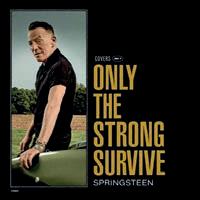
It’s been a long time between albums for Australian rockers Noiseworks. In fact, Evolution is the band’s first album of new material since 1991 although they’ve reunited for the occasional live gig between those years. This new album is also a tribute to the band’s original guitarist Stuart Fraser who passed away in 2019. Lead vocalist Jon Stevens doesn’t miss a beat on the anthemic ‘Heart & Soul’ which features guitarist Jack Jones who has also joined the band on tour. ‘Amerika’ boasts significant rock credentials and is certain to be a crowd favourite, as is ‘Sunshine’ which moves from a low-key intro to a serious rock track. Noiseworks shows further versatility on the catchy ‘One In A Million’, while the final track ‘Touch (Epitaph)’ is short but poignant ode to Fraser.

WAITING TO SPILL
TIME ON MY HANDS Ásgeir

Inertia Music www.asgeirmusic.com

Despite its small population, Iceland has been well represented in the music industry, including the likes of Ásgeir who launched his career back in 2012. Following his first Icelandic language album, all subsequent albums have been released in English. Like many northern European artists, Ásgeir is big on keyboards and electronics. It works well on ‘Borderland’, a cheery track with instant radio-friendly appeal. ‘Snowblind’ goes one better, the dreamy electronics and rhythmic beats are the perfect backing behind Ásgeir’s soaring vocals, which at times recall those of Australian singer Gotye. There’s echoes of folk on ‘Giantees’ while ‘Waiting Room’ is a poignant ballad. ‘Limitless’, Time On My Hands’ final track, rounds out what is an highly impressive album.
As well as being involved in road transport media for the past 23 years, GREG BUSH has strong links to the music industry. A former Golden Guitar judge

Country Corner
NOTHIN'S GONNA STOP US Tom Curtain
Ditto Music www.tomcurtain. com.au
When it comes to “country credentials”, Tom Curtain is the real deal. The Australian singersongwriter draws his inspiration from years spent working in Northern Territory and Western Australia stock camps. Curtain has released five albums to date, including his latest, Nothin’s Gonna Stop Us. In addition he operates a tourist venture, Katherine Outback Experience. On this new album Curtain sings of his surrounds on the country rock track ‘Why We Live Out Here’, and empathises with people who have lost loved ones on the waltz-timed ‘We’re Gonna Ride’. Bluegrass and humour combine on ‘Ee-yaw’, a song about a pet donkey, but Curtain is back to serious drought-breaking business on ‘When The Rain Comes Down’.

ALPENGLOW Trampled By Turtles

Columbia/Sony
Music brucespringsteen.net
Bruce Springsteen has ventured down the “covers” road with his latest release, Only The Strong Survive. Sure, he’s recorded an album of covers before, as on We Shall Overcome: The Seeger Sessions, but this new release brings together 15 of his favourite soul tracks. ‘Nightshift’, originally written and recorded by The Commodores’ in 1985, is an immediate standout. Springsteen ventures into the deepest section of his vocal range on the Walker Brothers’ 1966 hit ‘The Sun Ain’t Gonna Shine Anymore’, and tackles the oft-recorded ‘Hey, Western Union Man’, also a hit for Max Merritt in 1969. Springsteen selected two Four Tops' tracks for Only The Strong Survive – namely ‘When She Was My Girl’ and ’7 Rooms Of Gloom’. And Sam Moore, of Sam & Dave fame, adds vocals to ‘Soul Days’ and ‘I Forgot To Be Your Lover’, the latter a surprise hit for Billy Idol in 1986.
The Backseat Lovers Capitol/Universal www.thebackseatlovers.com
The Backseat Lovers are a four-piece band from the US state of Utah. New to the alternate rock scene, Waiting To Spill is only the quartet’s second album after their independentlyreleased debut When We Were Friends brought instant recognition. The Backseat Lovers kick off the new album with ‘Silhouette’, starting out as an inconspicuous instrumental before evolving into a well-crafted opus. That track seamlessly moves into ‘Close Your Eyes’, another multi-dimensional number. ‘Morning In The Aves’ is more chilled, while ‘Growing/Dying’ is whimsical in the style of The Kinks. ‘Follow The Sound’ is similar, albeit with a rock chorus, as lead singer Joshua Harmon’s vocals show similarity to Radiohead’s Thom Yorke. ‘Snowbank Blues’ is another low-key track, the band bringing back the big sound for ‘Know Your Name’.
THE CAR Arctic Monkeys

Domino/Universal Music arcticmonkeys.com
UK band Arctic Monkeys have continued on where they left off from their previous album Tranquility Base Hotel & Casino, stretching boundaries for The Car, their seventh album. Frontman Alex Turner was again involved in writing all the new tracks, including the atmospheric title track. The funky guitar on ‘I Ain’t Quite Where I Think I Am’ blends with orchestral sounds as Turner’s vocals meander through the abstract lyrics. At first listen, ‘There’d Better Be A Mirrorball’ sounds like a movie theme, while there’s Beatleslike experimentation on ‘Body Paint’. Heavy drama abounds on ‘Sculptures Of Anything Goes’, a song about mixed messages and coffee, and there’s mystery and intrigue on ‘Mr Schwartz’ as the band takes a chill pill. Arctic Monkeys have enjoyed a chart-topping ride since 2006; there’s no reason to think The Car won’t do likewise.
Thirty Tigers/ Cooking Vinyl trampledbyturtles. com

Folk/bluegrass six-piece band Trampled By Turtles, although acknowledging changing times in the world today, have stuck true to their musical heritage with Alpenglow, their 10th album. Hailing from the US state of Minnesota, Trampled By Turtles take the listener on a journey with these 11 new tracks. They sing of approaching mortality on ‘A Lifetime To Find’, which was penned by Wilco’s Jeff Tweedy who also produced the album.
‘Burlesque Desert Window’ is a lively number, almost danceable, and banjo takes centre stage on ‘All The Good Times Are Gone’. As with most “hillbilly” bands, there’s little or no percussion but it’s rarely missed, especially on tracks such as ‘On The Highway’, a journey through night-time storms.
for the Country Music Awards of Australia, Greg also had a threeyear stint as an ARIA Awards judge in the late 1990s and wrote for and edited several music magazines.
48 DECEM BER 2022 ownerdriver.com.au
EXPLORING THE WAH Truck
Reckless Records truckofficial.com.au
WHAT’S ON upcoming events
GEELONG CLASSIC TRUCK & VINTAGE MACHINERY SHOW
TOORADIN TRUCK SHOW & TRACTOR PULL
Victoria
Long way ’round for UD
UD Quon embarks on demanding ‘Lap of the Map’
Back in 1939, UD Trucks founder Kenzo Adachi embarked on a 3000-mile odyssey to prove the ultimate dependability of the new vehicle. Now, over 82 years later, UD Trucks Australia is heading off on an Adachi-San inspired lap of the Australian continent.
UD says the dependability and reliability of the brand in Australia was established long ago, so as a result this journey instead focuses on the people and the faces that have become a part of the UD family since its inception.
Following Australia’s fabled Highway 1, the fully loaded UD Quon CW25 360 will circumnavigate the country, stopping in to visit customers and dealers over the course of the 15,000-kilometre journey.
“We feel that the quality of the UD product speaks for itself,” says Lauren Pulitano, vice president UD Trucks Australia. “However, the Australian UD story is so much more than a tough dependable truck.
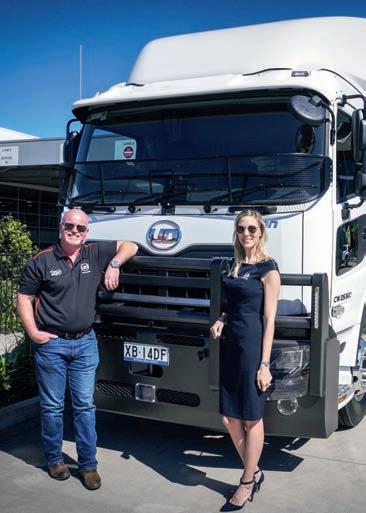
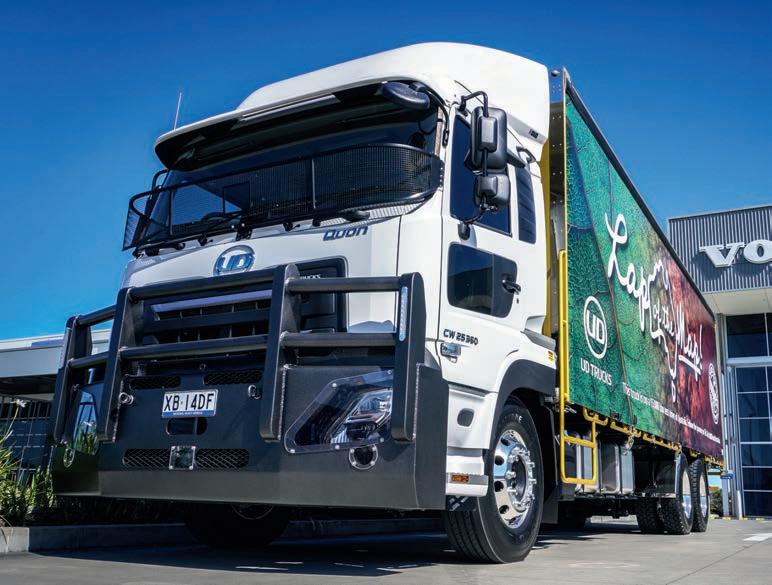
“UD customers and dealers around the country have been key to our success over the last nearly five decades. This trip is both a homage to Adachi-San as well as a celebration of customer success and partnership.
“This is also a fantastic opportunity to showcase the comfort, economy and connectivity of the UD Quon.”
The Lap of the Map tour departed on November 3 and will encounter all the extremes in terrain and temperature that the Australian continent is renowned for, from the towering forests of East Gippsland and Southwest WA to the searing heat of the Pilbara and the Kimberly. And from bustling capital cities to dusty wheatbelt towns.
Keep an eye out for the distinctive UD as it rolls across the country. Follow the journey on TikTok and Facebook.
#UDtruckslapofthemap
ABOVE: The 8 litre CW25 360 that will be making the journey with Volvo Group Australia PR and media manager Matt Wood behind the wheel. The truck has been loaded to a gross weight of 22,200kg for the 15,000 kilometre trip
LEFT: Matt Wood and UD Trucks Australia vice president, Lauren Pulitano
BOYUP BROOK UTE AND TRUCK MUSTER
February 18, 2023. Boyup Brook, WA
The Boyup
the annual
Brook Country Music Festival which will run from February 17 to 19, 2023. Truck registration 8am at Old Railway Staton. Includes parade through town continuing to Hockey Oval on Jackson St. $10,000 in prizes over 14 categories. Live entertanment, licensed bar.
For further info see the Facebook page www.facebook.com/ TheBoyupBrookUteAndTruckMuster, email uteandtruckmuster@countrymusicwa.com. au or see the website www.countrymusicwa.com.au/ute-truck-muster
LIVESTOCK BULK AND RURAL CARRIERS ASSOCIATION CONFERENCE
March 9-11, 2023. Tamworth, NSW
The annual LBRCA is a gathering of fellow truckies, government, suppliers and industry representatives to focus on the needs of rural and regional heavy vehicle transporters. Issues range from unfair infringements and regulation to unsafe loading and unloading facilities. Includes the Young Driver of the Year Award presentation and Gala Dinner and Auction Spectacular.
For further info see the website www.lbrca.org.au or email office@lbrca.org.au
HAULIN THE HUME
March 24-26, 2023. Clarendon to Yass, NSW
Haulin’ The Hume, the old Hume Highway road run will depart Hawkesbury Showground at Clarendon on the morning of March 25 to Razorback Mountain, Picton, Mittagong, lunch at Goulburn then on through the Cullerin Range into Gunning and on to Yass for dinner. Entry fee $30 per vehicle. Organsed by the Western Sydney Historical Truck Club.
For an entry form and further information see the website www.wshtc.com.au, phone Darrell Killick on 0412 050 224 or email bruce@prodrivecompliance.com.au. Or join the Facebook group Haulin’ The Hume - Highway 31 Road Run
TRUCKING AUSTRALIA 2023
March
29 to 31, 2023. Sunshine Coast,
Qld
Held at the Novetel Sunshine Coast Resort, Twin Waters, and presented by the Australian Trucking Association (ATA). Join the nation’s trucking operators and industry stakeholders to tackle the big issues. Includes the National Trucking Industry Awards and Daimler Truck Local Showcase Dinner.
For further information and registration go to the Australian Trucking Association’s Trucking Australia website at https://new.truck.net.au/ta/
MID AMERICA TRUCKING SHOW
March 30-April 1, 2023. Louisville, Kentucky, USA
The Mid America Trucking Show (MATS) is arguably the largest annual heavy-duty trucking industry event in the world. Held each year at the Kentucky Expo Center in Louisville, KY, the show attracts 70,000-plus attendees and 1,000-plus exhibitors from throughout the United States and abroad. Includes the PKY Truck Beauty Championship. For further info see the website at www.truckingshow.com
BRISBANE TRUCK SHOW
May 18-21, 2023. Brisbane Convention & Exhibition Centre, Qld
Organised by Heavy Vehicle Industry Australia (HVIA), the Brisbane Truck Show is held every two years and attracts approximately 290 exhibitors and up to 40,000 attendees. As the largest event of its type in the southern hemisphere, the Brisbane Truck Show stands alone as the premier event in Australia for the transport industry showcasing the latest in heavy vehicles, technology, engineering and innovation.
For further information see the website at www.brisbanetruckshow.com.au
DECEMBER 2022 49 ownerdriver.com.au
January 14 to 15, 2023. Geelong Showgrounds, Victoria Includes Vintage Tractor Pull, radio controlled trucks, steam engines, classic cars and bikes, and family fun days. Gates open at 9am both days. $10 adults, $8 pensioners, children under 15 free. Exhibitors free. For more information see the Facebook page at www.facebook.com/ classictruckandmachinery or phone (03) 5221 1707.
Truck
Full catering, kids amusements, helicopter rides,
FX fire jets wet/dry area,
Truck
kids
Classic car
entry $10 inc driver, truck show entry $50
January 21, 2023. Tooradin,
Held at Rutter Reserve, the Tooradin
Show & Tractor Pull has been an annual event since 1998.
how
no BYO.
show from 10am to 3pm, Tractors 3pm to 10pm. Adults $25,
$10 (kids under 10 free), family $60.
show
including driver. Strictly no dogs. For further info go to www.facebook.com/tooradintractorpullandtruckshow
Brook Ute and Truck Muster is incorporated into
Boyup
have an
listed free, phone 0408 780 302 or e-mail greg.bush@primecreative.com.au
To
event
THE GOODS NEWS FROM THE HIGHWAY AND BEYOND
Diabetes 2 prevention DIABETES AUSTRALIA Polly Antees
Recent events are a reminder of men’s health and lifestyle choices within the aging population
November was Movember which aims to raise awareness of men’s health issues, while October was Safety at Work month. The Lights on the Hill Memorial Convoy and Memorial Service Weekend was held at Gatton, Queensland, in October as well, to remember all transport workers who have died at work.
As 97.5 per cent of truck drivers are male, this edition’s topic looks at how men can stay healthier at work with type 2 diabetes, and how to prevent it from developing.
While the average age of a truck driver is 43, a 45-year-old male truck driver has a one in 50 risk of developing type 2 diabetes. If you’re male and your waistline is over 110cm then your risk of developing type 2 diabetes increases to one in 14. Reducing your waistline can have a significant impact on reducing your risk of developing type 2 diabetes.
Smoking also raises your risk of type 2 diabetes, by up to 40 per cent. If you smoke, one of the best things you can do for your health is to try to quit. Seek
support from your friends, family, doctor and Quitline (13 78 48) to improve your chance of success.
To assess your risk of pre-diabetes, answer these questions:
• Do you have high blood pressure?
• Are you overweight?
• Do you lead an inactive lifestyle?
• Do you have high triglycerides and low HDL cholesterol, or high total cholesterol?
• Do you have heart disease, or have you had a heart attack?
• Are you of Aboriginal, Torres Strait Islander, Pacific Island, Asian and/or Indian heritage?

• Does someone in your family have type 2 diabetes?
• Do you have a family history of type 2 diabetes or heart disease?
If you answered yes to one or more of these questions you could be at higher risk.
Truck drivers are an aging workforce that need to maintain their health in order to keep Australia moving. Try the AusDrisk tool to calculate your risk of developing diabetes: www.health.gov.au/resources/ publications/the-australian-type-2-diabetesrisk-assessment-tool-ausdrisk-pdf-version
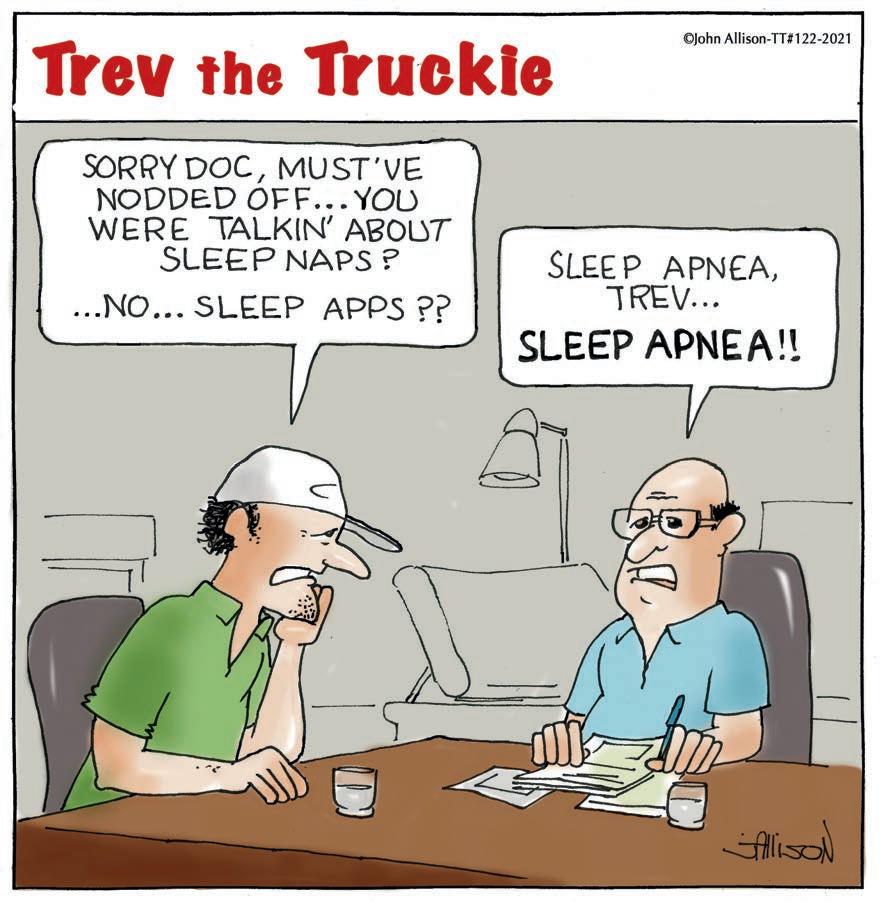
HAVE AN ANNUAL HEALTH CHECK
Type 2 diabetes develops slowly. The symptoms of insulin resistance, commonly called pre-diabetes, include feeling tired more often, blurry vision, and being a little more irritable than usual. Unfortunately, many people misinterpret the signs as getting older.
It is estimated that in Australia there are currently 500,000 people living with undiagnosed type 2 diabetes. Having undiagnosed type 2 diabetes increases the risks of problems such as having a heart attack or falling asleep at the wheel. It also increases your risk of heart disease, kidney disease, and damage to your eyes and the nerves in your feet.
A yearly health check can reduce your risk of developing type 2 diabetes by picking up pre-diabetes. If you are diagnosed with pre-diabetes, or the early stages of type 2 diabetes, you can make lifestyle changes and, if needed, use medications to ensure you maintain both a healthy way of living, and your heavy vehicle licence.
HEALTHY HEADS
Healthy Heads is a new app developed by Healthy Heads in Trucks & Sheds that you may find useful. This organisation aims to improve the health of truck drivers and warehouse staff.
The app has:
• videos of stretches and exercises to do when you are stopped for a break
• breathing exercises for focus, to reduce stress or help you get to sleep
• a wellbeing check-in

• a list of phone numbers of organisations if you need someone to talk to about your mental health
• a link to where to access healthier food choices at roadhouses, with a discount
• articles and videos on truck drivers’ health issues.
TYPE 2 DIABETES
In regards to type 2 diabetes there are risk factors that are able to be reduced and others that cannot. Age, genetics and family history are things that cannot be changed. But understanding your risk of diabetes can allow you to make lifestyle changes to reduce or postpone the chance of developing type 2 diabetes in the future. Having higher blood glucose levels due to insulin resistance can affect mental health. Stress can increase blood glucose levels too. Thus, checking in on your wellness regularly can help with both blood glucose levels and metal health.
Don’t forget to download the Healthy Heads app, and try out other apps for your phone to make movement easier while stopping for breaks on the road. Movement improves glucose uptake by the muscles and lowers blood glucose levels.
Keep on truckin’.
50 DECEMBER 2022 ownerdriver.com.au
POLLY ANTEES is an accredited practising dietitian and credentialled diabetes educator with Diabetes Queensland. For more information on diabetes or to talk to a dietitian, call the Diabetes Australia Helpline on 1300 342 238.
2
“A 45-year-old male truck driver has a one in 50 risk of developing type
diabetes.”
DRIVER’S SIDE Rob McDonald
A reason for being
The transport industry would prosper if trucking could be promoted as a desirable occupation
Not long after I earned my MC on my 25th birthday, I was loading trailers hooked up to mainly Volvos in a shed in Carole Park, Queensland. A bloke in his late thirties turned up in a gorgeous green and chrome Kenworth to load up. My guess is it would have been a 904. After we chatted, he got paid about 10 cents less per kilometre than I was, and I remember this vividly. “At least I get to drive a Kenworth.”
I thought this was crazy. The only thing that mattered to me right then and there was the moolah. Now, after 10 years, almost to the day, it makes perfect sense. Love your job and never work a day in your life.
The Japanese have a concept called Ikigai. Ikigai translates to ‘a reason for being’. Ikigai is the perfect balance of your life’s mission, profession, vocation and passion, incorporating everything you’re good at, love doing, what you get paid for, and what the world needs.
I like to think I’m pretty good at driving a truck. Sure, I’ve done some bonehead things over the years. The biggest question I ask myself is am I passionate about trucking? I would say yes! But I think it’s more compartmentalised than that.
I’m not passionate about waiting around DCs for hours and hours, waiting to get loaded or unloaded.
I’m not passionate about awful food that’s served up at truck stops, I’m not passionate about sharing the road with others that just seem to make poor decisions or simply want to make your trip more difficult.
I still remember my very first trip in a truck. It was from Rocklea in Brisbane to Sydney markets in a Freightliner
Argosy, a C15 Cat mated to a smart shift dragging a 24 pallet refrigerator. I had no idea even where to park. I ended up finding a spot on Madeline Street, Enfield, just outside a bus depot I worked out of in 2009.
I went to sleep with the fridge on because I didn’t even know how to turn it off. On the trip down it bucketed down with rain. I kept the ‘jake’ on middle power, terrified I’d lock the wheels up in the wet despite being fully loaded. I remember calling out, “Rookie in a single, southbound over Macksville Bridge”, and then hearing a faction of old school truckies singing my praise for willing to self-identify as a rookie. I did have five solid years of flying across that bridge in 14.5m long coaches but they don’t wander like a trailer with 15 million kilometres on it.
KNIFE’S EDGE
My passion for road transport is probably the only element of ikigai which is on a knife’s edge and the only
way for that to improve are genuine market forces. Only the best roadhouses should remain, only the most caring distribution centres should be respected.
I remember driving around a large supermarket DC in Brisbane, just before a trip to Yeppoon. It took me what felt like an hour to find my trailer. It was a plain white Toll trailer with only Toll mudflaps (why can’t they just number every parking bay?). Then the weighbridge decided to malfunction on my exit. I’ve heard it still malfunctions today, some nine years later.
Over the last decade I’ve seen a vast paradigm in the different drivers but they definitely fall into two categories. Those who love nothing more than driving a truck and those that just do it for a job.
Are those with a fire in their hearts about trucking better operators than those that saw an advertisement between selling TVs or washing cars? I only know that when you love something dearly you’ll give it all you’ve got.
There must be a balance of recruiting ‘passionate truckies’ to those just seeking a means to put food on the table. With the demand for truckies increasing, wages stagnate, enforcement getting out of control and modern trucks becoming boring, it’s rough to expect people to want to do it.
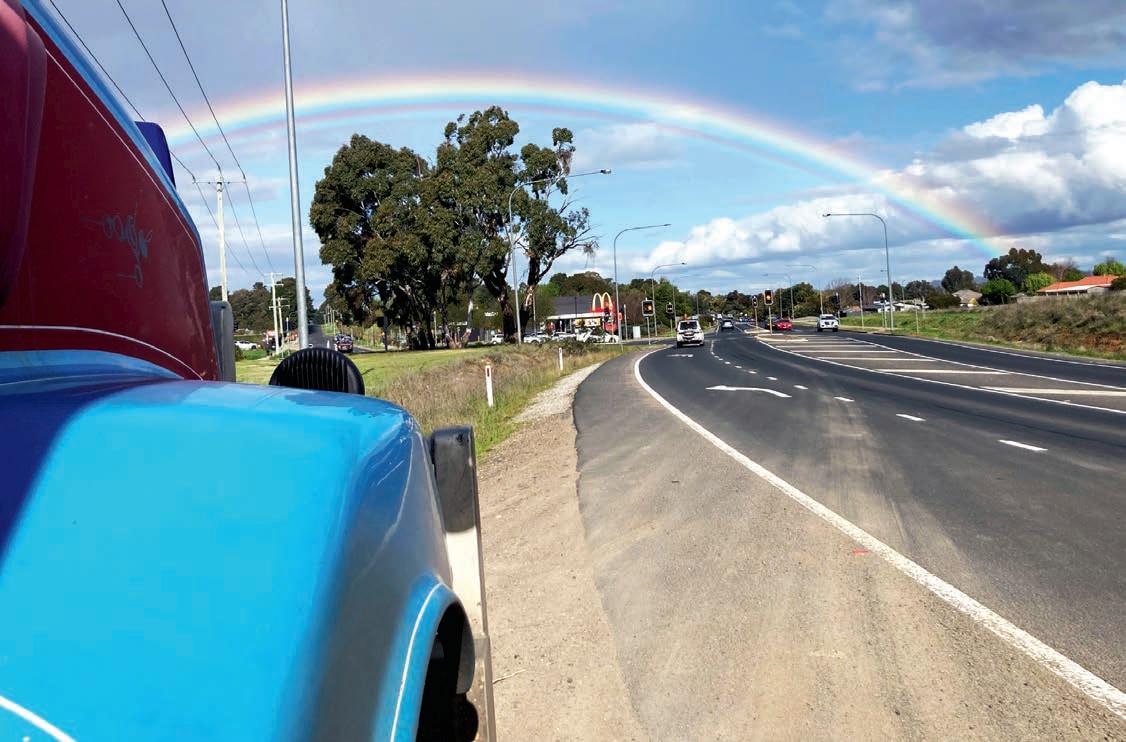
The desire for those with a genuine passion for trucking is subsiding. The workforce must be propped up by those who need a job: bus driver, truck driver, taxi driver, forklift driver … whatever. Everyone needs to put food on the table and support their family and I have no issue with that.
Dopamine is the chemical in our brain which makes us feel motivated. Without



that natural motivation to be the best truckies we can be, we’re likely to be mediocre at best.
Have you ever watched those corporate videos with truckies being interviewed in their clean clothes? They will tell you how great the company is, how good the opportunity is, how wonderful it is to be a truckie, and what they love about the job. It’s all designed to ignite dopamine in your brain to get you on the phone to apply to be a driver. This is alright, but you need to experience the love and passion for the role to be the best truckie you could be.
The trucking industry would thrive if companies and governments could isolate and exploit what makes trucking a desirable occupation. If a company needs a fleet of shiny Kenworths to attract the most passionate and caring drivers, then so be it. It’s a driver’s market. I would welcome a fleet operator to do whatever they need to maintain a roster of passionate, competent and experienced drivers.
I’d take an XXL Globetrotter, but that’s just me. If only they came in manual.
DECEMBER 2022 51 ownerdriver.com.au
ROB MCDONALD is an experienced driver, having been behind the wheel of trucks and coaches since age 22. He is currently employed at Shaw’s Darwin Transport and prefers a manual gearbox. To contact Rob email robbie_mac@icloud.com
“I’m not passionate about waiting around DCs for hours and hours.”
No one wants to be off the road for two days waiting for a part, but the reality of the Australian experience is that such occasions may arise.
Tallebudgera-based owner-driver John Irwin carts heavy machinery around Queensland, using a Scania R 580 V8 XT (now with 334,000km on the clock), towing a quad, super tilt spreader trailer with an all-up weight of 29-tonnes and a 60-tonne GCM.
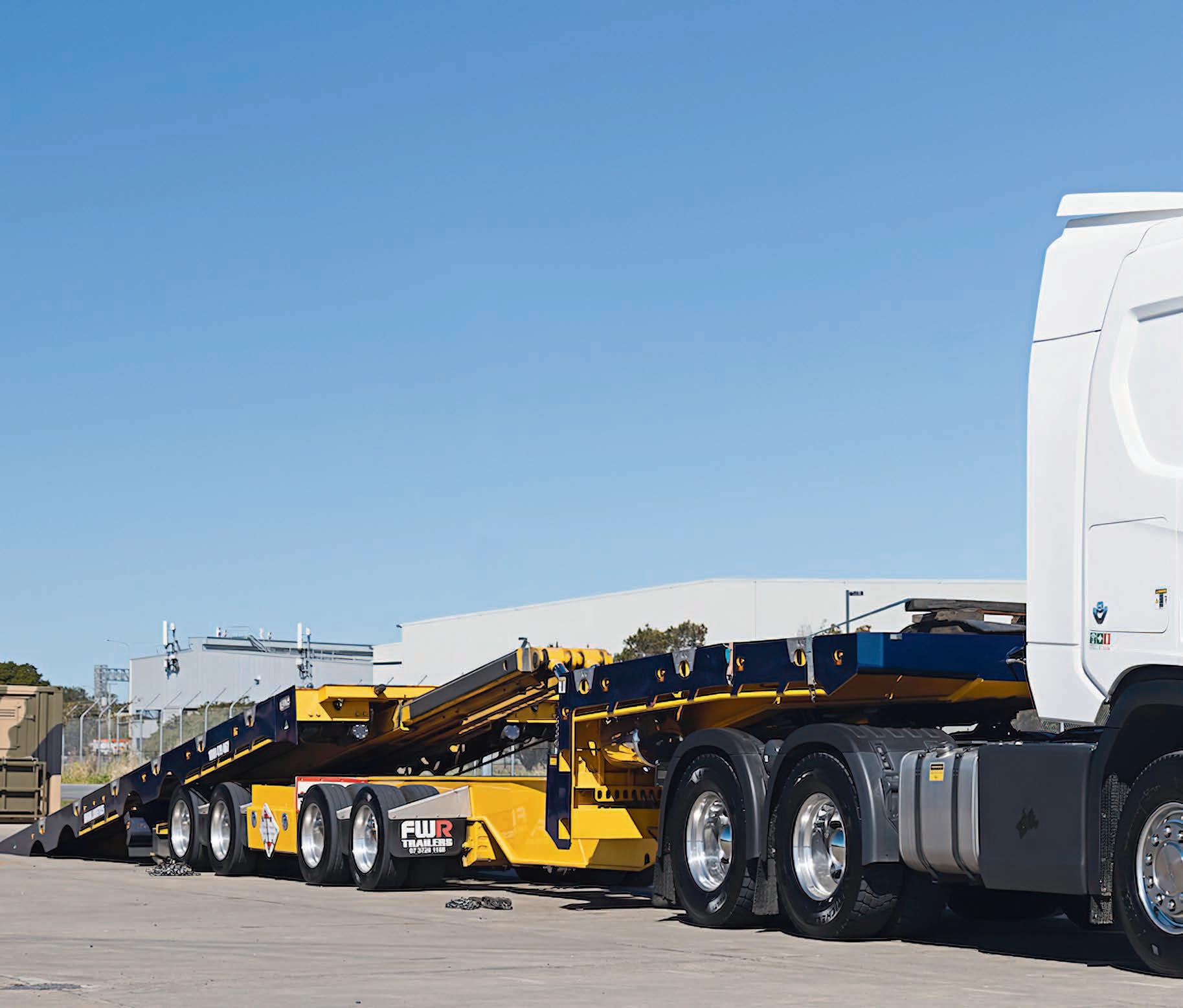
Aside from moving big machinery around for a well-known hire company, Irwin Logistics also has a contract with the LinFox Defence Commercial Team and is currently transporting Bushmaster vehicles from Brisbane to RAAF Amberley from which they are flown to Ukraine.
On a return trip through Townsville late in the evening recently, John encountered an orange warning light on the dash, prompting a call into Scania Assistance, the 24/7 helpline for all Scania drivers.
Scania Assistance dispatched a service vehicle, and the technician diagnosed a fault in the gearbox. The nearest replacement part was in Brisbane, and it was expected that this would take two days for the part to arrive and be fitted.
However, true to the Scania core value of always putting the customer first, John found to his delight the required part was flown in express the next morning and by mid-day he was well on his way
south, once again, and full of admiration for the Scania Queensland team.
“I was very emotional,” John says. “I couldn’t believe that Scania had gone to so much trouble for me to get the part to Townsville so quickly. I had expected to be off the road for two days. The service and the dedication to getting me back on the road was exceptional.
“We’d been driving south, two up, when there was a warning light up on the dash and a message saying, ‘please visit the dealership’.
“This truck is a relatively new R 580 V8, and it is very quiet. My co-driver was in the bunk, and he said he could hear something unusual from the gearbox. We pulled up at the BP truck-stop and called Scania Assistance who arranged a service van call out from the Scania dealer, Honeycombes.
“When the technician arrived, I was blown away by the sophistication of the diagnostics. Not only did the computer pinpoint the fault, but it opened an onscreen window showing the part and a schematic of how to replace it. I was amazed at the details.
“I had already been on the phone to Scania’s Kevin MacDonald and then my account manager, Rowan Bouwmeester at Scania Richlands in Brisbane, and despite it being around 8.30pm, Rowan’s first two questions were: ‘What’s the problem?’” and ‘How can I help?’” John says.
“I explained and told him I couldn’t afford to
lose two days parked up in Townsville, because we have time-sensitive jobs.
“Rowan said to call his boss, Anna Marie Taylor, the state manager for Queensland, but it was by then 9pm, so I texted her and I was shocked when she called me back immediately! She confirmed they had a part and then at 9.55pm she called again to say she’d had had the part picked and that it would be taken to the air courier service by 0800 the next day.
“The next morning, the part arrived at Honeycombes in Townsville by 10am and I was back on the road by 11am. That’s when I was a bit emotional,” John says.
“I couldn’t believe the lengths to which Scania had gone to get me back on the road so fast; that the Queensland state manager herself had called me and fast-tracked the part from Brisbane to Townsville and into the truck, so that just about 15 hours after the warning light came on, I was back on the road,” John says.
“When I first wanted to buy a Scania one of my mates tried to put me off, but I’m glad I didn’t listen. For a start this R 580 XT was built to exactly my specification, including a full leather interior, plus Adrian Erzetich, the Scania Finance Business Development Manager in Queensland made the process of paying for the truck very easy. The Scania Finance team really supported me through COVID as well. They have been phenomenal, incredible to work with, even though I am only a micro business.
52 DECEMBER 2022 ownerdriver.com.au
THE CALL OF DUTY industry focus The quality of the service is remembered long after the purchase price
SCANIA GOES BEYOND
“Scania’s R&M Contract takes all the stress out of keeping the truck on the road. And as this breakdown shows, it’s excellent insurance for when things go wrong, especially to have this team behind you,” he says.

“The power of the Scania experience shows just how customer service should be delivered. Another piece of equipment I have that cost about the same as the prime mover developed a fairly major problem, and I called their account manager, and still several days later I had not had even a call back. Scania obviously operates at a different level.
“I grew up in Northern Ireland and have been driving Scanias and other European trucks for a long time, so when I was looking for a truck in Australia for my business, I considered most of those brands,” John says.
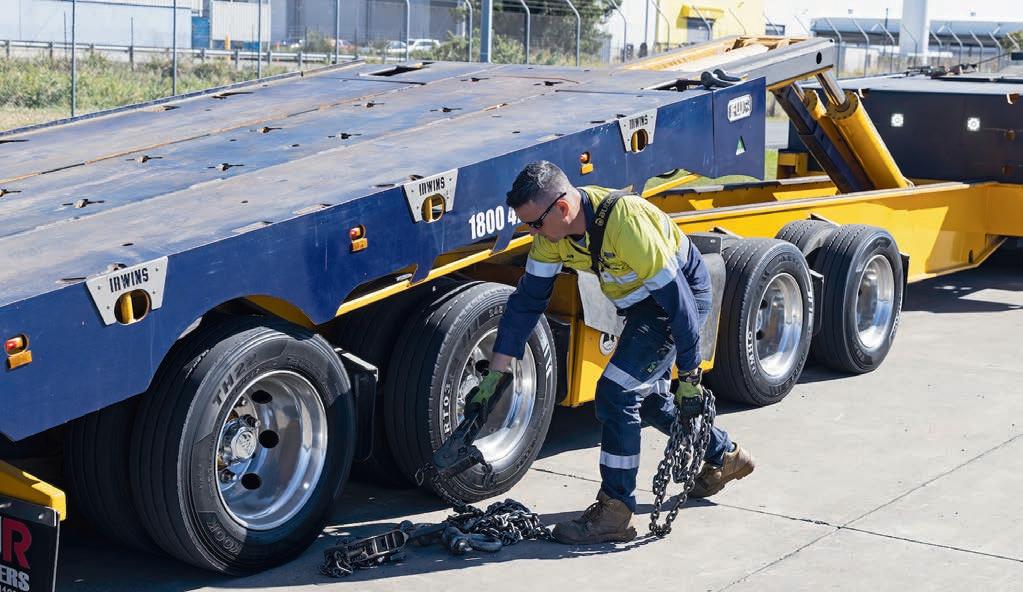

“It was the service I got from Scania that tipped me over the line. I turned up at the dealership and talked to the account manager and the first thing he said was take a demonstrator for a week and see how you go. It was a V8, which I liked so we settled on an R 580 XT. I love it so much, I bought another, a G 450 XT 8x4 twin-steer in a lovely metallic blue and I have an R 770 Long Cab on order as well.
“I’ve also got three lighter-duty Hinos, and a DAF CF75, plus one sub-contractor with a Scania R 620 and another with a Hino.
“My experience with Scania has been incredible, from the first contact with Rowan and the loan of the demo truck, to the support and service of Kevin MacDonald and the workshop team at Richlands, and of course the State Manager fixing a problem in the middle of the night.” John says.
“Scania is always willing to go the extra mile for our customers,” says Anna Marie Taylor, State Manager for Scania in Queensland.
“It not an empty platitude, but a core value we live by. When you’re faced with a situation where a customer is looking at significant time off the road, and we can do something to fix the problem, we’ll do it,” she says.
“Maintaining our customers’ uptime is what drives us. And it brings us satisfaction knowing we’ve got them back on the road by using a bit of imagination, but most importantly, being open to finding a solution, even if it is late at night. We put ourselves in the customer’s shoes and we know how we would feel in their situation.
“We were very happy we could get John out of Townsville and back home with only a short delay. I’m proud of my team that made this happen. This truly is the Scania difference,” Anna Marie says.
DECEMBER 2022 53 ownerdriver.com.au
TOP RIGHT: Owner-driver John Irwin with his Scania R 580 XT LEFT: John Irwin carts heavy machinery around Queensland with the Scania R 580 V8 XT
“I COULDN’T BELIEVE THE LENGTHS TO WHICH SCANIA HAD GONE TO GET ME BACK ON THE RO AD SO FAST.”
NRFA Sally Tipping
Strength in numbers
Further positive changes for the industry can be achieved through associations working together
In my column of December 2021, I predicted 2022 would be the year of massive productivity. At the time I underestimated exactly how massive. The transport industry has seen colossal demands throughout 2022, with the freight task escalating by record levels. The National Road Freighters Association (NRFA) has also seen a heightening need to represent its members and gain results in creating a stronger, viable industry.
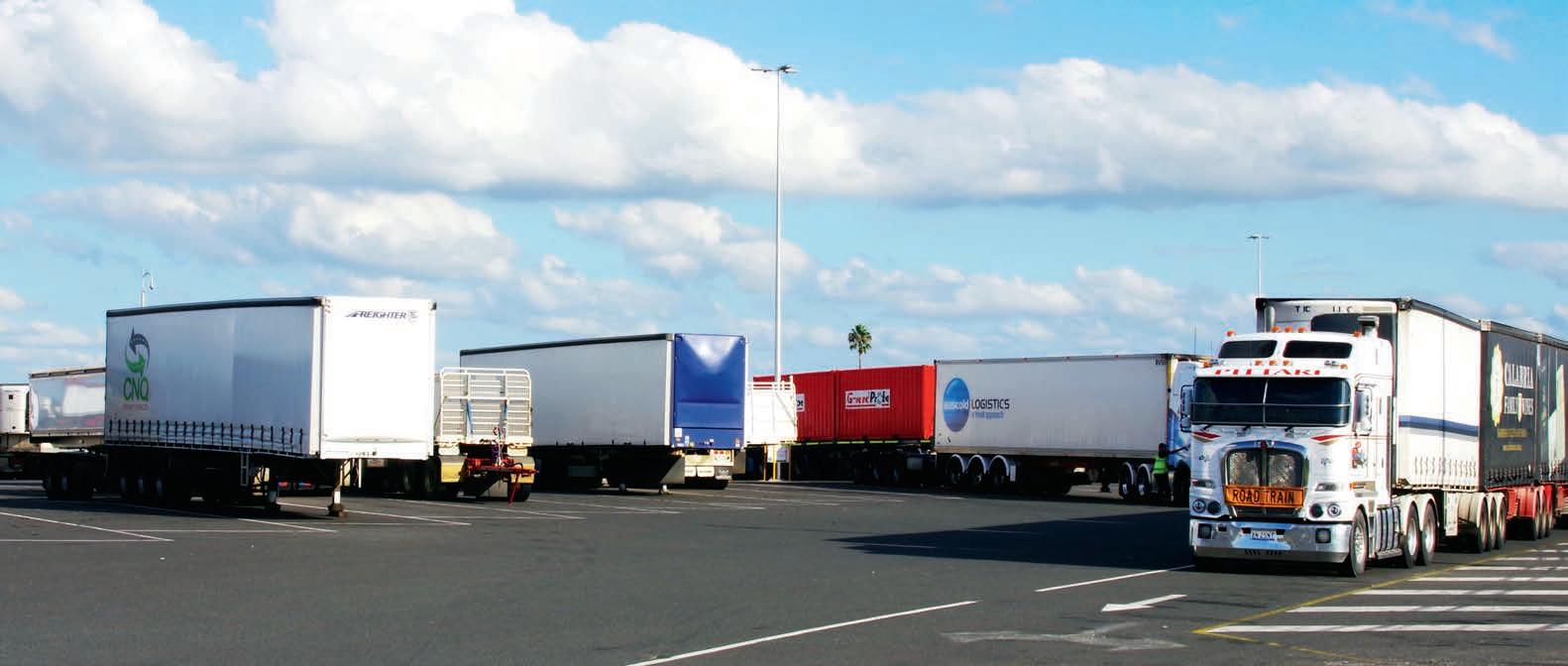
Major stakeholders have acknowledged the wealth of knowledge and experience the NRFA members have and included board members in numerous committees and meetings.
NRFA president Rod Hannifey continued his advocacy for safer roads, taking part in many meetings and discussions; including the Fatigue Risk Management Standard Project Advisory Panel, the Road Safety Action Plan led by Senator Carol Brown, Transport for NSW Rest Area Committee and NSW Newell Highway Overtaking Lane Alliance, as well as being an ambassador for ‘Health in Gear’ and collaborating with Monash University’s ‘Driving Health’.
Trevor Warner, NRFA vice president, worked in conjunction with the Transport Workers Union’s (TWU) national office pursuing the improvement of two modern
awards to correct issues of wage inequality and held discussions with Queensland Department of Transport and Main Roads providing input into planning of the Bruce Highway upgrade at Tiaro, as well as increasing further collaboration for future road development.
The NRFA had an outstanding presence at the Trucking Australia conference with all board members attending and having a high visibility throughout the three-day event, including robust discussions within the open forums. The NRFA encourages all associations to connect and work together to increase positivity and productivity across all areas of the transport industry.
A real standout of the year was Wes Walker who continued his fight to install toilet facilities at the Gatton pads. His passion and never-say-die approach paid off in August with authorities installing temporary facilities with the hope of a more permanent resolution in the near
future. Wes must be acknowledged and congratulated. It’s an amazing result for our industry.
WAGGA CONFERENCE

The NRFA is an advocate for change in the transport industry. Members make calls and write letters every single week. It is an uphill battle but we do have wins and encourage everyone to do the same and join an association. With greater numbers our strength increases and results will be significant.
The next NRFA conference will be in Wagga Wagga, Saturday, February 11, 2023. As a voluntary association the NRFA leads the way in consultation and advocacy to drivers and small to medium operations, ensuring all voices are heard and acknowledged. Stay tuned for more details early 2023.
Reflecting on an extremely successful year the NRFA would like to extend its appreciation to all members and stakeholders who have been supportive. Your collaboration has been invaluable and we are looking forward for this to continue throughout next year.
My wish for everyone this Christmas is to reflect on this crazy, busy year and to embrace joy and peace, while you can as 2023 will not stop for anyone. It’s going to be another massive year!
On behalf of the NRFA board and members, may your Christmas sparkle with moments of love, laughter and goodwill, and may the year ahead be full of contentment and joy.
Have a Merry Christmas and we look forward to connecting with you in 2023.
And don’t forget when you can: ‘Wave to a Truckie’. It’ll make you feel good and will make their day!
54 DECEMBER 2022 ownerdriver.com.au
SALLY TIPPING is the managing director of family-owned Tippings Transport Pty Ltd based in Dubbo, Central West NSW. Sally is a board member of the National Road Freighters Australia, a member of Transport Women Australia Limited and founder of the Wave to A Truckie campaign which highlights and positively promotes the Transport Industry.
BELOW: The NRFA has been urging for permanent toilet facilities to be installed at the Gatton pads. Photo by Greg Bush
“The NRFA leads the way in consultation and advocacy to drivers and small to medium operations.”
Unit 1/71 Axis Place, Larapinta, Brisbane, QLD, 4110, Australia
Unit 1/71 Axis Place, Larapinta, Brisbane, QLD, 4110, Australia
Ph: (07) 3276 9300 Fax: (07) 3276 9301 Email: mattc@gibbsparts.com davids@gibbsparts.com Web: www.gibbsparts.com



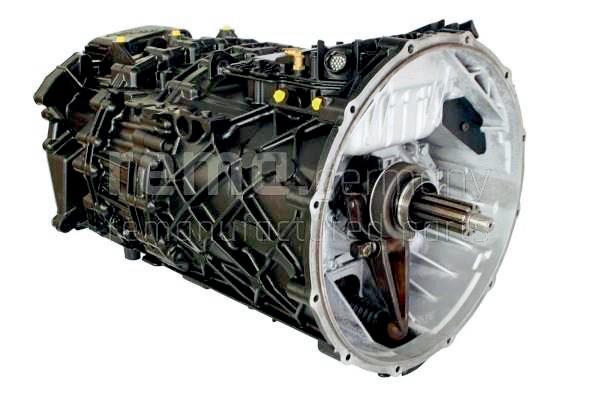
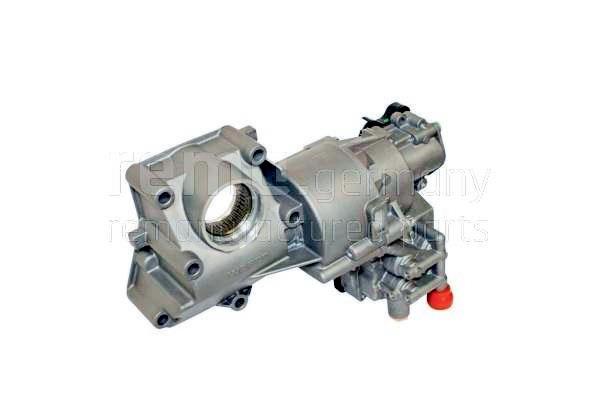
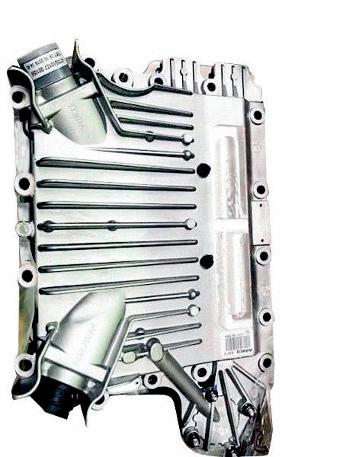
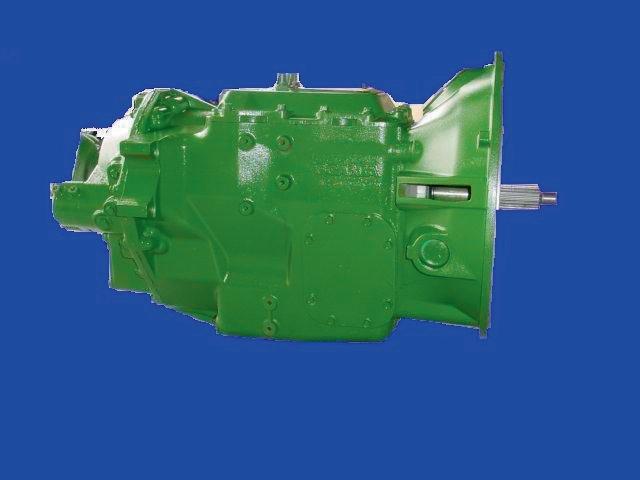

Ph: (07) 3276 9300 Fax: (07) 3276 9301 Email: sales@ggd.net.au davids@ggd.net.au Web: www.gibbsparts.com
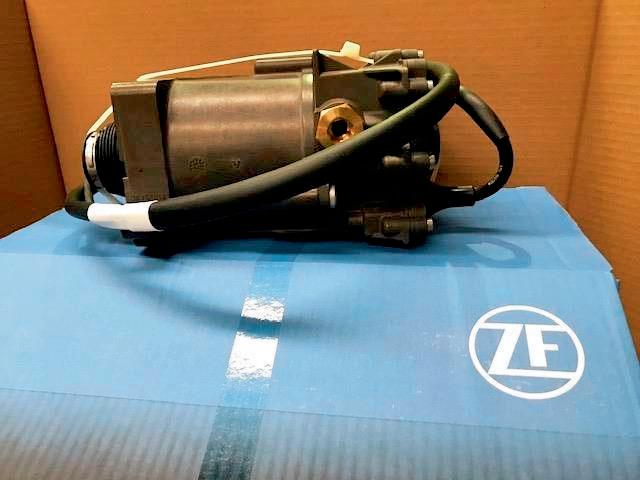
ESTABLISHED 57 YEARS SPECIALISING IN TRANSMISSIONS AND DIFFERENTIALS FOR TRUCKS & BUSES FULL WORKSHOP FACILITIES SPARES, REPAIRS, RECONDITIONED & NEW EXCHANGE UNITS AVAILABLE DOW-FP-5013553-C Diesel Mechanics Needed - Call us to find out more
ESTABLISHED 57 YEARS SPECIALISING IN TRANSMISSIONS AND DIFFERENTIALS FOR TRUCKS & BUSES FULL WORKSHOP FACILITIES SPARES, REPAIRS, RECONDITIONED & NEW EXCHANGE UNITS AVAILABLE DO W-FP-5013553C ZFASTRONIC ZFClutchActuatorsForDAF,IvecoAnd ManTrucks.S37. TA950479. POA MERCEDES-BENZG85-G280 ReconditionedMercedes-BenzTransmissions. MostMakesandModelsG100,G131,GO210, G240,G280,G330available.S3. TA431566. POA SCANIATRANSMISSIONS Allmakesandmodelsavailable.S11. TA431615. POA ZFDAF,IVECO&MAN ModulatorZFAstronicForDAF,Iveco&Man. S38. TA952388. POA MERCEDESEPS Gearcylinder.S39. TA952389. POA ZFASTRONIC ForDAF,Iveco&Man S43. TA952397. POA ZFDAF,IVECO&MAN ZFEcolitepowerpacks.S40. TA952390. POA VOLVO/MACKI-SHIFT/M-DRIVE AT2512C,AT2612D&ATO3112D. S44. TA952399. POA ZFTRANSMISSIONSALLMODELS Allmakesandmodelsavailable.S10. TA431606. POA
WILKIE’S WATCH Ken Wilkie
Trivial injustice
There’s something foul in the air when an ex-police officer criticises an enforcement procedure
I’ve had a very interesting communication from a concerned reader last week. He expressed his disgust (his word, not mine) that a police officer would write up Dan Roe up for accidently failing to tick his BFM box on one day. As he has explained and those of us on this side of the law understand, it is a simple matter to flip over a few pages. Dan’s error would have been apparent as a mistake and, of course, ensuring the fatigue program being claimed is actually valid.
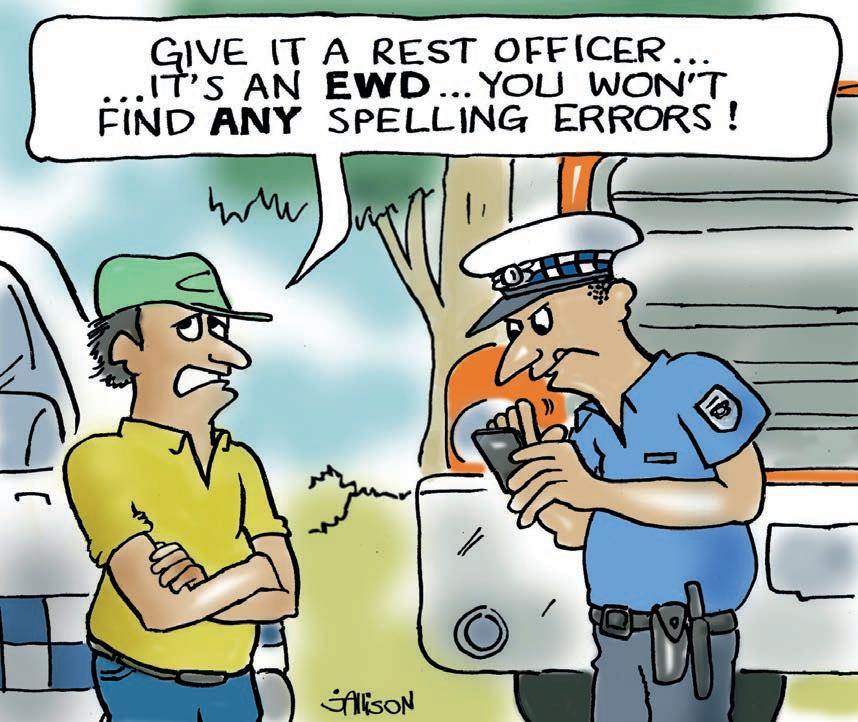
These comments, ladies and gentlemen, come from a now retired very high-ranking police task force officer. He comments that he couldn’t imagine this type of trivial administrative breach getting to court. I did explain in return conversation that the RMS explicitly rule out administrative errors as being grounds for discarding the breach.
There is further significant comment in the letter. He expressed concern at drivers not recording a change of activity, such as loading and unloading being recorded as rest, and the fatigue safety implications of such.
“Any new regulation should require the enforcement officer to stipulate a degree of aggravation which would cause the administrative breach to have a safety implication. Example!
There has to be evidence of a sinister motive with supporting information,” he wrote.
My correspondent also expressed dissatisfaction with importing people from overseas who might well be licensed there but who are not required to engage in training to our standards. The failure to have a level playing field is another concern. Primary industry registration is a classic instance.
POLITICAL CORRECTNESS
From time to time, my friend Chris Roe and I partake in phone discussions. Chris has been at pains to explain to me that the current board of the National Road Freighters Association (NRFA) is very keen to develop a positive public profile. This conversation followed my urging to have as many politicians as possible attend the NRFA’s February conference. My attitude is that it is a waste of time pandering to bureaucracy if the NRFA is serious in talking about truckies working for truckies.
In a report delivered to NatRoad by Castalia from a study done some 13 years ago, it stated, “Border crossings are a high stress node in the transport network”. (Castalia, Securing a national approach to heavy vehicle
regulation – report to the National Road Transport Association [NatRoad] February 2009, page 22.) According to industry sources, drivers who cross borders experience considerable compliance stress with attendant health risks. So where has NatRoad’s concerns gone? And is the board of NRFA also more concerned with warm and fuzzy feelings than attacking real issues? This report was in response to industry calling for regulation uniformity nationwide. My view is that associations are a tool to advance the conditions under which the industry functions – not forums for fellowship.
In Queensland’s Courier Mail , Tuesday, November 1 under the heading of ‘Audit Office slams public service, it read, “Queensland’s public service is unwilling to learn from mistakes and has to be forced into action to improve according to the Auditor General in his latest scathing spray”. Meanwhile, industry associations are pandering to the politically correct mantra in their dealings with our bureaucracy.
I have been critical of the lack of progress in nationalising Australia’s road transport law. The nation needs uniformity in regulation for the economic imperatives. We’re already so far out of economic touch with the rest of the world’s economies that it is well past being a joke. Our very security is considerably compromised. The nation needs regulation uniformity because, as Castalia reported, crossing borders with the current mismatch of laws causes stress and consequently health risks.
It is no secret that stress is a major contributor to poor health. If, as a bureaucracy, the National Heavy Vehicle Regulator is having difficulty in driving progress towards national uniformity, than how does industry get results? The only option is to use members elected by society to work in the interests of our society –politicians.
The article in the Courier Mail states that bureaucracy targets outputs rather than outcomes. Performancebased standards for instance? Is the failure of the National Transport Commission to develop laws that have less stress impact and better economic potential further evidence of bureaucracy failing to put in place relevant, measurable and achievable performance measurements?
This month I’m reading The Mighty Krait by Ian McPhedran. I’ve said it before, I don’t advocate the material I select because I’m a warmonger. They are stories from our very troubled past where mostly young Aussies gave their all to ensure our future –yours and mine. Sadly, that attitude of selflessness for the betterment of all Australians is a thing of the past.

56 DECEMBER 2022 ownerdriver.com.au
KEN WILKIE has been an owner-driver since 1974, after first getting behind the wheel at 11. He’s on his eighth truck, and is a long-time Owner//Driver contributor. He covers Rockhampton to Adelaide and any point in between. His current ambition is to see the world, and to see more respect for the nation’s truckies. Contact Ken at ken@rwstransport.com.au
“Crossing borders with the current mismatch of laws causes stress.”
Your Say
SEND YOUR LETTERS TO:
Letters to the Editor need to be typed or clearly handwritten and be no more than 500 words. Letters should include name, title (e.g. owner-driver, manager) and city for publication, unless otherwise requested. Letters may be edited for clarity or space. Please be concise, so we can offer more people an opportunity to express themselves.
Greg.Bush@primecreative.com.au or 379 Docklands Drive, Docklands, VIC 3008
We prefer letters by e-mail, but handwritten letters will be accorded the same opportunity to be published.
Age of harassment
Having read the article, ‘Costly and flawed advice from NSW Revenue’ in OwnerDriver ’s September issue, I would like to comment.
I am a retired truck driver, 78 years old, and although having come up through earlier times of rag tyre, mechanical hand signals, lousy brakes if any, 2-stick crash boxes, Armstrong steering and miniscule rear-view mirrors, I am glad that I am not truck driving in this age of official harassment and high stress levels.
Bureaucrats have most certainly got us by the short and curlies. It is hard to believe that anything is more important to them than money to be obtained in any fashion possible.
Any ramifications when they stuff up?
Which brings us to the fining of hard-working truck drivers for the slightest error or omission.
Truck drivers are truck drivers they are not accountants, they are not bookkeepers, nor are they solicitors.
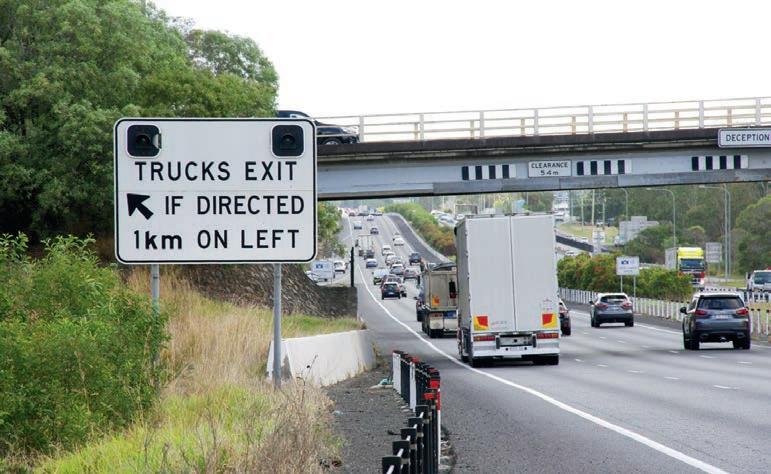
But we expect drivers to be fully conversant with all of these aspects, as well as all variations of laws and regulations in all States they may traverse. A great money earner that one!
Would we treat any of these occupations in a similar manner to the way we treat our truck drivers if they could not drive a B-double in a competent manner?
How about a bit of common-sense and understanding when errors occur. Concentrate on safety matters that relate to life and death.
John Longhurst
Response to Wilkie column
As a retired police officer who specialised in heavy vehicle policing for many years, I read with disgust the article Ken Wilkie placed in OwnerDriver magazine’s October edition. Disgust in the fact that a driver was penalised for not ticking the BFM box, if this fact is correct.
It is not difficult for the officer to check the fatigue management program the driver is operating on – e.g. check the previous page, front page of diary etc.
There are a lot of reasons why this type of policing is occurring which I do not intend to discuss here. I cannot imagine this type of trivial administrative breach getting to court – it is hardly safety related.
I am aware of the HVNL (Heavy
Vehicle National Law) being reviewed and I do not believe that written work diaries will be done away with at this point.
Take it from me that there are times when an administrative deficiency within a work diary, e.g. change of activity not recorded, can have significant implications.
For example, working while later claiming a major rest break, or commencing your diary at Yamba so you can overnight to Sydney. You are a very experienced driver and you know what I mean.
As such any new legislation should require the enforcement officer to stipulate a degree of aggravation which would cause the administrative breach to have a safety implication, e.g. there has to be evidence of a sinister motive with supporting information.
Take it from me, like in any industry (including police) the unscrupulous will take advantage of any situation if they can. Always remember – the industry needs a level playing field.
Work diary legislation definitely needs to be changed so as to prevent enforcement officers going after ‘low hanging fruit’ (easy pickings).
Enforcement officers, prosecutors and courts need to weed out the wheat from the chaff when it comes
those with less experience to help them learn and develop:
“I am sure by now, most, if not all our employees are aware of an incident involving one of our drivers near Moree. I was made aware of the incident and, as always, the welfare of the driver and safe return to operation of the equipment was our priority.
“We investigate all incidents and this investigation has been progressing since. At this stage we have no reports or indications that anyone was hurt. This is the most important matter.
“From the initial investigation,
our industry or the nation. Australia has a rich history of immigration, tolerance and prosperity based on the efforts of the people who have chosen to make this country their home. This rich diversity should be celebrated not attacked.
“I would ask and remind employees not to engage with anyone who is confronting them or acting inappropriately. Where possible return to your vehicle, lock the doors and contact ops and they will try and help.
“If you feel threatened and in danger, please contact the police and state your name, location and
to heavy vehicle breaches. If the facts are as you state in your article, this is not occurring on every occasion and as such there is risk of honest drivers being unnecessarily penalised.
Concerned Citizen (name withheld by request)
‘Mindless drivel’ from social media trolls
I have attached a copy of an email sent out to me to all employees of Ron Finemore Transport. The driver was trained and made decisions based on what he thought was right at the time before stopping in what he deemed to be a safe place and letting ops know. Wet conditions mean that road shoulders are also a hazard and getting bogged and or tipping the trailer would also have been a consideration.
The industry must do its best to attract people to driving, train them and offer them support and help
we can see that the equipment was well maintained and that the tyres involved were replaced at the end of September and the equipment did not seem to contribute to the tyre failures.
“Based on our investigations and photos taken near where the incident occurred, the most likely cause was the severely water/flood damaged road surface leading to a flat tyre. This flat was not detected and eventually lead to further tyre failures. The driver stopped when he felt safe and able to do so, contacted operations and fleet maintenance commenced arranging repairs. Given the time that this was going to take, the driver elected to take a sleep break. The video vision was taken when he exited the prime mover following his break.
“The extent of racist bigotry that has followed on from this vision being recorded and posted frankly leaves me numb. It has no place in
explain what is happening. For those who have been receiving and reading some of the emails being sent in, please delete any inappropriate emails (most of which are anonymous) and not expose yourself to the mindless drivel.
“The road conditions, floods and diversions are all adding to the challenging workplace that drivers and operations must manage and navigate. All can add to a feeling of stress, concern and level of emotions. You have my full understanding and support. I would ask you to take your time, drive to the conditions, take a rest when needed and communicate to operations if you will be later than your planned arrival time. We will let the customer know. They are also accepting and supportive of drivers being safe.”
DECEMBER 2022 57 ownerdriver.com.au
Mark Parry Managing director Ron Finemore Transport
“I cannot imagine this type of trivial administrative breach getting to court.”
THE PENSKE PUSH
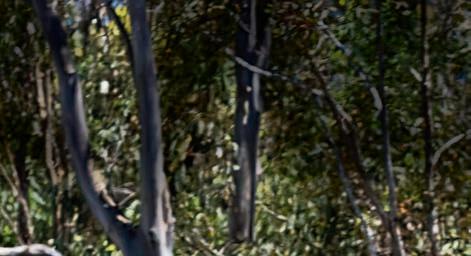




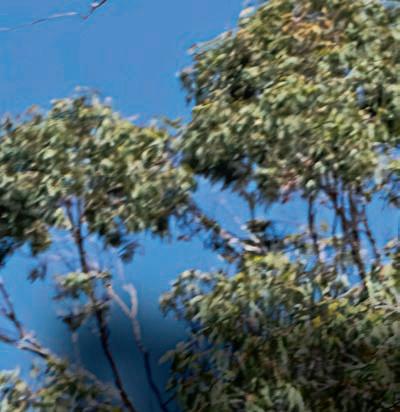

58 DECEMBER 2022 ownerdriver.com.au
truck
technology
Not since 2013 when American automotive mogul Roger Penske parted with $219 million to take control of Transpacific’s commercial vehicle group – in the process gaining distributorship rights for MAN and Western Star among other things – has there been so much feverish activity in the Penske Australia operation. Nor, it seems, has so much effort and expense gone into actually promoting Penske’s two flagship truck brands.
And resurgence could not have come at a more needy time as both MAN and Western Star look likely to finish 2022 with undeniably dismal sales figures.
However, the first signs of a bold new era started a few months back with the slap-up introduction of a much modernised and from all appearances, much improved range of MAN medium and heavy-duty models. These latest men from Munich are the spearhead of a determined effort to
give the MAN brand a higher presence in a cab-over market crowded with high quality competitors.
It won’t be an easy task tackling the established market might of Volvo, Scania, Mercedes-Benz and Paccar’s Kenworth and DAF, but this time around Penske Australia has a significantly better MAN fighting for more business.
As our road test report of the MAN 26.640 flagship reveals over the following pages, there’s a lot to like from behind the wheel.
But the truly big news was Penske Australia’s recent launch of the longawaited Western Star X-series and on first impressions, it’s easy to predict a vastly brighter future for the fully revamped conventional.

It’s no secret that Western Star’s position in the Australian market has plummeted since Roger Penske’s involvement in the back half of 2013 but the confidence and exuberance surrounding X-series’ potential to propel Star back to its early success is almost palpable. Better still, it also seems entirely justified with a model range that will take Western Star into a far wider range of applications.

At least six years in development, said to be the most tested Western Star ever developed, and two years since its official launch in the US, X-series has been a long time coming to our part of the world and in an exceptionally professional and comprehensive launch at Brisbane’s Mt Cotton mobility centre, Penske Australia executives and staff couldn’t hide the excitement and expectation for the threepronged range of 47X, 48X and 49X models.
As our detailed report suggests, X-series will almost certainly carve an entirely new future for the brand and in the process, return Western Star to its former prominence as arguably the only brand capable of loosening Kenworth’s iron grip on the heavyduty conventional class.
DECEMBER 2022 59 ownerdriver.com.au
The last few months will likely go down as the most dynamic and perhaps definitive time in Penske Australia’s history, according to OwnerDriver’s technical editor Steve Brooks
BACK IN THE GAME
Western Star’s decade in the doldrums appears done and dusted following the recent launch of its exciting new X-series range. True, it could be a hard road back after languishing for so long on the fringes of truck sales charts but on first impressions, the threepronged X-series line-up of 47X, 48X and 49X models has the specification, the features and the versatility to blast Western Star into a bold new era. Steve Brooks reports
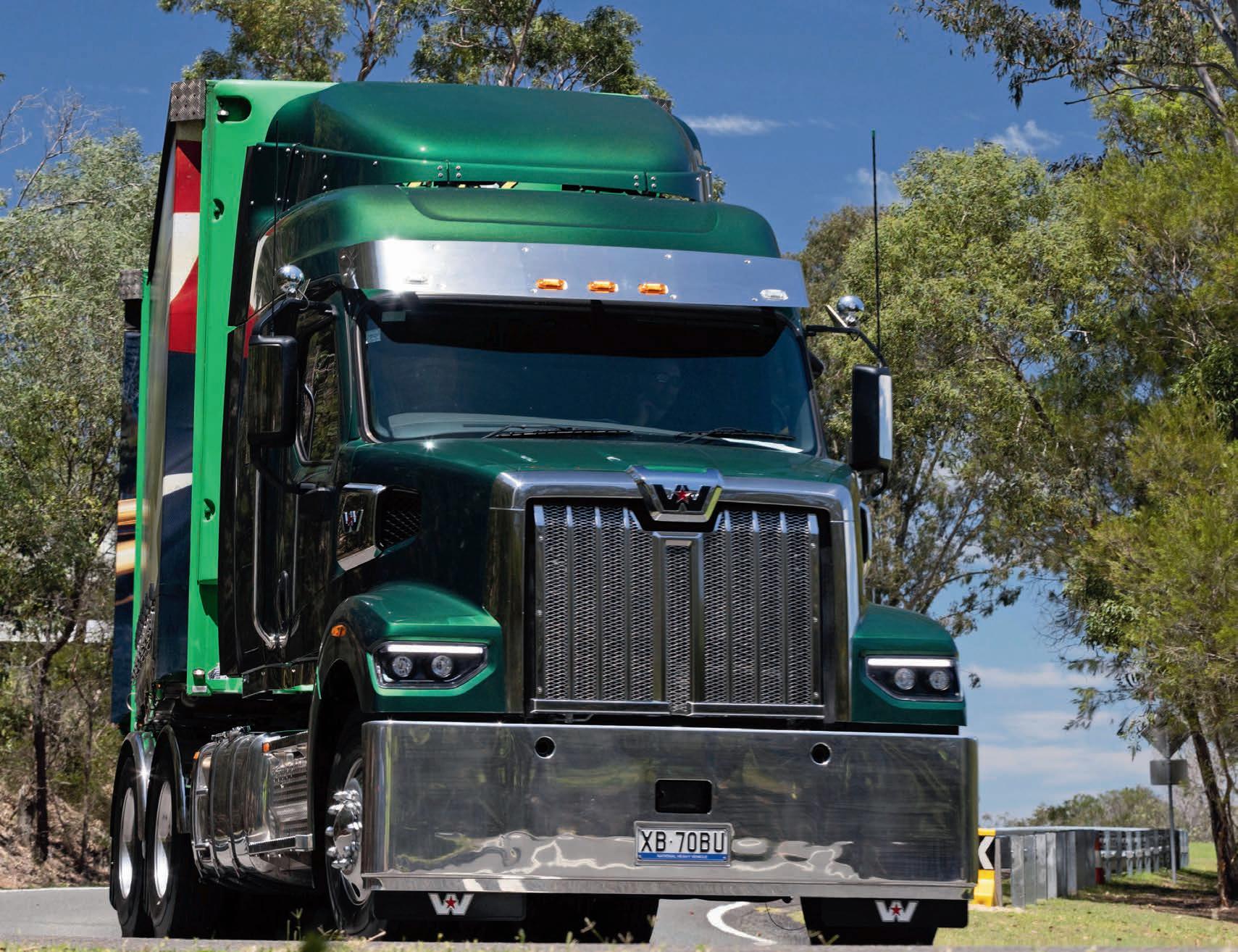
Penske people must be a patient lot, especially in our part of the world. For the best part of a decade, they’ve waited and waited, and waited some more, for their Star to do what stars generally do best – shine brightly!
Yet, for reasons seemingly mired in a motley mix of corporate complexity and fiscal fate, Western Star has largely failed to fire since 2013. That was the year, of course, when charismatic motoring mogul and billionaire businessman Roger Penske secured Western Star in the $219 million purchase of Transpacific’s commercial vehicle group. Ever since, the brand has slid steadily to the lowest rungs on the heavy-duty sales ladder.
As the saying goes though, ‘all good things come to those who wait’ and for Penske Australia, the waiting game is finally over following the recent launch of Western Star’s much anticipated X-series range. Indeed, not since the local release of Western Star’s abidingly revered Constellation models almost 25 years ago when the brand was still under the ownership of the fiercely astute Terry Peabody, has there been so much justifiable excitement, expectation and even emotion surrounding the arrival of a new Star.
60 DECEMBER 2022 ownerdriver.com.au
truck technology
Then again, as exuberant Penske Australia executives were quick to emphasise at Brisbane’s Mt Cotton mobility centre during the most comprehensive and professional new model launch attended in several years, the X-series is like no other Western Star before it. Nor, they insist, has any Western Star ever been tested to the same extent as X-series and equally, no Western Star range has ever had the potential to cover so many applications as X-series.
Put simply, the platform has been poured for arguably the most ambitious and competitive assault on the heavy-duty conventional truck market seen in a long time, and with it, the most dynamic period since Western Star first hit the Australian market almost 40 years ago.
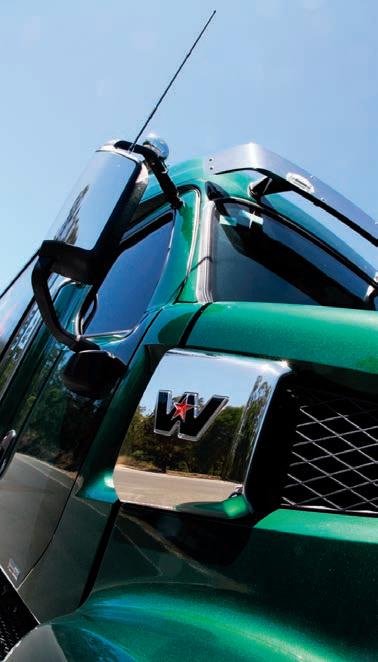

Nonetheless, it has been a laboriously long wait and despite Western Star’s entrenched reputation as a tough and proven product in Australian conditions, Penske Australia has plenty of rebuilding to do with an X-series line-up so distinctly different from its forebears. Again though, the emphasis at Mt Cotton was firmly on citing Star’s long experience in the Australian market and the fact that this new range has undergone more intense testing than any of its predecessors.
Obviously enough, most of the testing was done in the US but as several Penske operatives mentioned, pre-production units accumulated around 200,000km on Australian roads prior to the new line-up’s release.

It’s now six years since Daimler Trucks North America (DTNA) started its $100 million development of an entirely new Western Star range, and around two years since the new trucks debuted on the North American market. Flippantly perhaps, DTNA international sales manager for Western Star, Greg Robinson,
defined the extended delay in X-series’ launch here as simply, “Saving the best for last.”
There could, however, be some merit in taking so long to reach Australia. Right-hand drive was an integral part of the X-series development program from the outset and in what appeared a willing concession to the Australian market’s historic ability to extract durability issues that exist nowhere else in the world, Greg quickly added, “We went to extreme measures to ensure success.”
Whatever the delays, Penske Australia personnel are undeniably ecstatic that the new trucks have finally arrived. In separate presentations to assembled media, managing director Hamish Christie-Johnston, executive general manager Craig Lee and head of Western Star Trucks, Kurt Dein, could not hide their delight that finally, the days of competing with a tired, limited and increasingly uncompetitive model range are now in the past.
“This is not a tweak or a rebranding exercise,” said an emphatic Craig Lee. “It is a completely new product (and) we’re now able to compete in segments we’ve not been in before.” Citing the days when Western Star comfortably sold more than 1000 trucks a year with a relatively narrow model range, a boldly confident Lee enthused, “Double digit sales are the goal.”
For Kurt Dein, ‘X’ indelibly marks the spot where Western Star fires back to life, resuming its place at the sharp end of the heavyduty conventional truck class. “This is what Western Star should be,” he said with unbridled enthusiasm. “Something it hasn’t been for a long time.”
As for the long delay reaching the Australian market, the time wasn’t wasted according to a resolute Dein. “These aren’t the trucks launched in the US two years ago. These are unique to Australia,” he declared, referring particularly to the 48X model developed exclusively for Australia and more broadly, the use of the latest Detroit DD13 and DD16 engines feeding into the Detroit (Daimler) DT12 12-speed automated transmission, and critically, the standard inclusion of the advanced safety systems already established in corporate cousins Freightliner Cascadia and Mercedes-Benz.
Moreover, the last few years have only added to the reputations for solid performance and thrifty fuel consumption of equivalent DD13 and DD16 engines in Freightliner and Mercedes-Benz models.
It is, however, the versatility of X-series which gives the new range its greatest opportunities, a point certainly not lost on
DECEMBER 2022 61 ownerdriver.com.au
Right: Big boy of the bunch, the 49X. It takes the place of Western Star’s former roadtrain and heavy haulage specialist, the 6900, and retains the 72 inch Stratosphere sleeper
“This is what Western Star should be. Something it hasn’t been for a long time.”
Western Star veteran Doug Shand. In the early ’80s, his late father Bob Shand was instrumental in bringing Western Star to Australia in the wake of White’s demise and despite a self-confessed ‘gap year’ before recently returning to Penske Australia, Doug’s involvement with Western Star has few, if any, equals.
With quiet conviction, he views X-series as the most exciting development to ever emerge from the Western Star stable, with an unrivalled depth of versatility to fit a multitude of tasks.
What’s more, the versatility stems from more than a Daimler Truck powertrain. As Craig Lee explained in a media statement on the new range, “We have passionate Western Star enthusiasts who will want a 49X with the 600hp Detroit DD16, drum brakes, spring suspension, and an Eaton Fuller manual transmission, and we can deliver that.
“On the other side of that, for a fleet operator after a 47X or 48X to haul B-doubles with Detroit’s DT12 transmission and all the advanced telematics that come with that, we can deliver that too.”
Moreover, “The Detroit DD13 13 litre engine in the 47X and 48X also opens up new markets for Western Star, such as local distribution or B-double intrastate.”
The range
From the outside, there’s no doubting it’s a Western Star. Designers have, in fact, done a good job of styling all three X-series models with the bold, strong appearance typifying a traditional US conventional rather than the sleek, softer contours of a slippery wind-cheater.
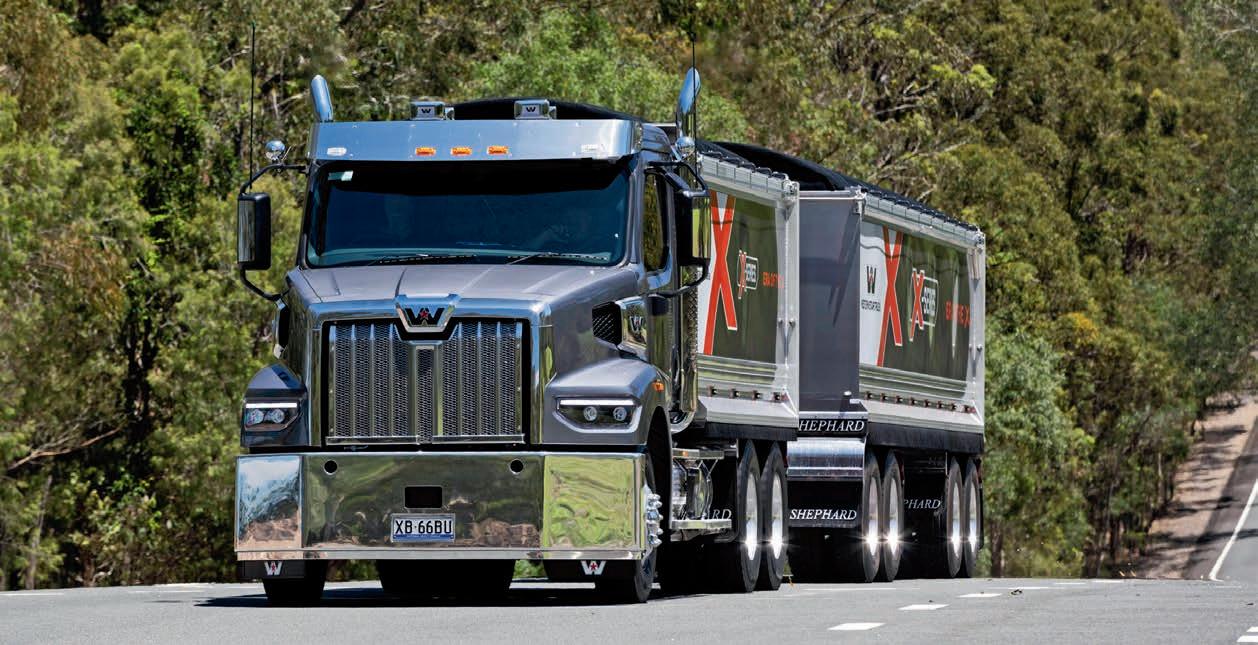
Yet while looks largely depend on individual tastes, there’s no denying that big beaks with gutsy stainless steel grilles and classy air intakes each side of the hood impart the message of working class toughness on which so much of Western Star’s heritage is based. That’s not to suggest X-series’ mildly drooping snouts and sloping guards aren’t concessions, however slight, to aero efficiency but it nonetheless highlights the design goal to maintain Western Star’s long established identity as a true toiler.
Whatever the view though, there’s far more to the X-series lineup than meets the eye, starting with the 47X.
Unlike the limited specification and subsequently limited potential of the previous 4700 model, the 47X will almost certainly break new ground for Western Star in this country for a wide range of reasons.
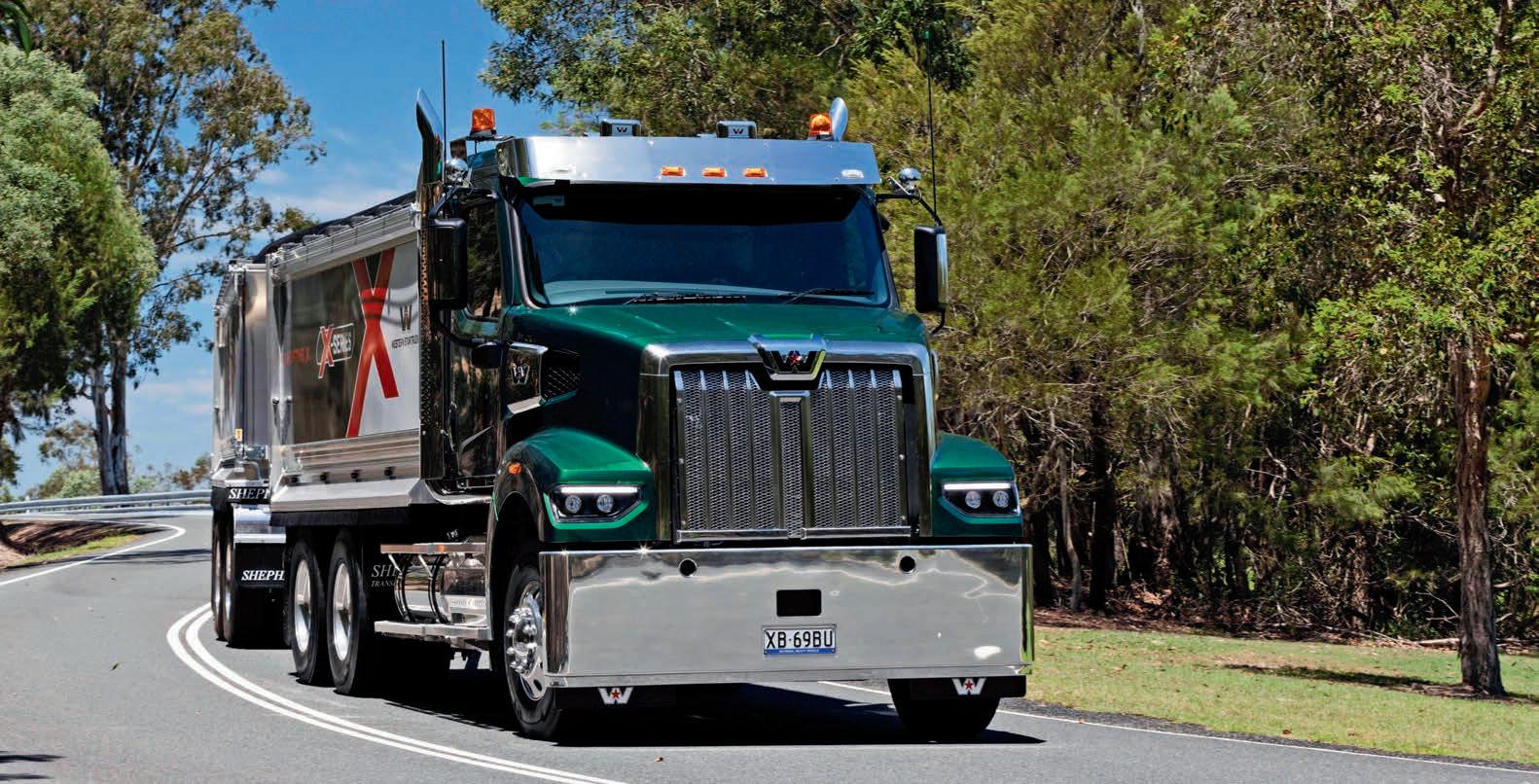
With a set-back front axle and compact 2835mm (111.6 in.) bumper to back-of-cab (BBC) dimension, it comes as a 6x4 and mid-way through 2023, will be available in 8x4 and 10x4 layouts. The big gain, however, is the availability of the latest DD13 Gen 5 engine with up to 525hp and 1850lb-ft of torque in addition to the lightweight Cummins ISL 9.0 litre engine with up to 380hp and 1255lb-ft of torque.
The introduction of the DD13 provides the 47X with the muscle to push gross combination mass (GCM) up to 72.5 tonnes and therefore, B-double and heavy truck ’n dog duties. Even so, the model’s potential to cover a long list of rigid and prime mover workloads is further enhanced by the choice of the DT12 automated 12-speed overdrive transmission in either standard
Top & above: Tipper toilers, the 48X and 47X. Both models add many new possibilities for Western Star due in large part to the introduction of the DD13 engine with up to 525hp. The 48X also gets the big bore DD16 with up to 600hp
Opposite top & underneath: Inside the 49X. The dash design, switchgear layout and steering wheel are straight out of the Daimler Trucks North America handbook, and that’s not a bad thing; Penske Australia’s Kurt Dein heads up Western Star business in Australia. His passion for the new product and its potential are resolute and on first impressions, totally justified
62 DECEMBER 2022 ownerdriver.com.au
“The 47X will almost certainly break new ground for Western Star in this country for a wide range of reasons.”
OV or extreme OVX form, an 18-speed Eaton Fuller manual box, or an Allison automatic.
As well as a standard day cab, there’s also a range of three sleepers – a 36 inch model in a low-line trench style (meaning an indented roofline to minimise the height of additions such as air horns and marker lights) or 36 and 48 inch versions with a mid-height roofline which provides standing room.
Yet as potent as the potential is for the 47X, it’s the 48X which seemed to excite Penske people the most.
As several insiders emphasised, this is the truck built purposely for the Australian market, with no US counterpart, and the truck they believe will put Western Star firmly back on the linehaul B-double map. And from all appearances, their optimism and excitement are not misplaced.
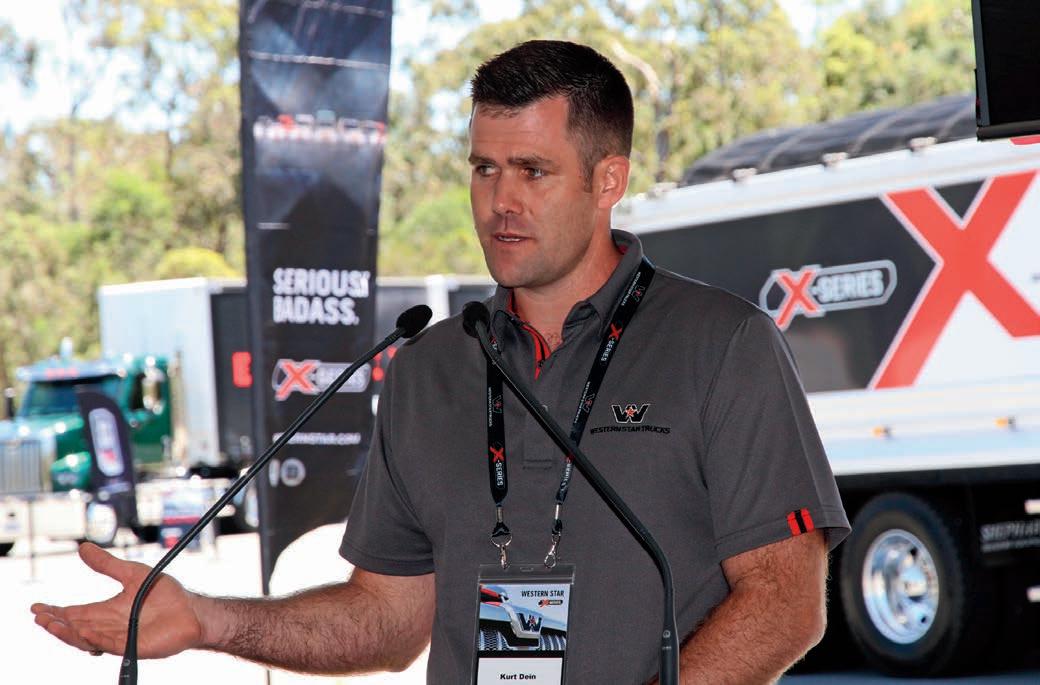
With a set-forward front axle and trim 2883mm (113.5 inch) BBC, the 48X is a 6x4 prime mover specification with the choice of the DD13 engine up to 525hp or the turbo-compound DD16 with up to 600hp and 2050lb-ft of torque, coupled to either the standard DT12-OV automated shifter or the higher torque rating of its OVX counterpart, or an Eaton 18-speed manual.
While the DD13 version has a GCM of 72.5 tonnes, the DD16 takes the 48X to a GCM limit of 106 tonnes. Slimline cabs come with the choice of standard flat or trench-style rooflines while sleepers range from 36 inch models with either a low trench roofline or a stand-up mid-roof design. Importantly for B-double work, the bumper to back-of-sleeper length with the 36 inch shed is 3567mm but for those wanting a bigger sleeper, there are also 48 inch and 60 inch high-roof versions.
From any angle, it’s obvious Western Star’s local leaders have worked closely with their US colleagues to tailor a 48X model specifically for Australia’s linehaul B-double market. It is a smart spec.
The big boy of the bunch is the 49X which effectively replaces the former 6900 model which was, of course, Western Star’s roadtrain and heavy haulage specialist. Moreover, it’s apparent the 49X has a specification to step neatly into the former flagship’s shoes even with a significantly shorter BBC
of 3085mm, or 121.5 inches.
With a standard GCM rating of 140 tonnes and the ability to be rated up to 200-plus tonnes with engineering approval, the 49X is available in 6x4 and 8x6 (tri-drive) configurations, punched by the DD16 engine through either the DT12 automated transmission or Eaton’s 18-speed manual ’box.
As for sleepers, it’s top-shelf only, starting with 60 and 72-inch mid-roof models and the grandest of all, the high-rise 72 inch Stratosphere. For the less ostentatious, a 48 inch version is likely to be added in 2023. There is, however, much more to the new X-series than the relatively brief details reported here.
A closer look
Western Star events are exceedingly rare and with a long awaited, once-in-a-generation launch of an
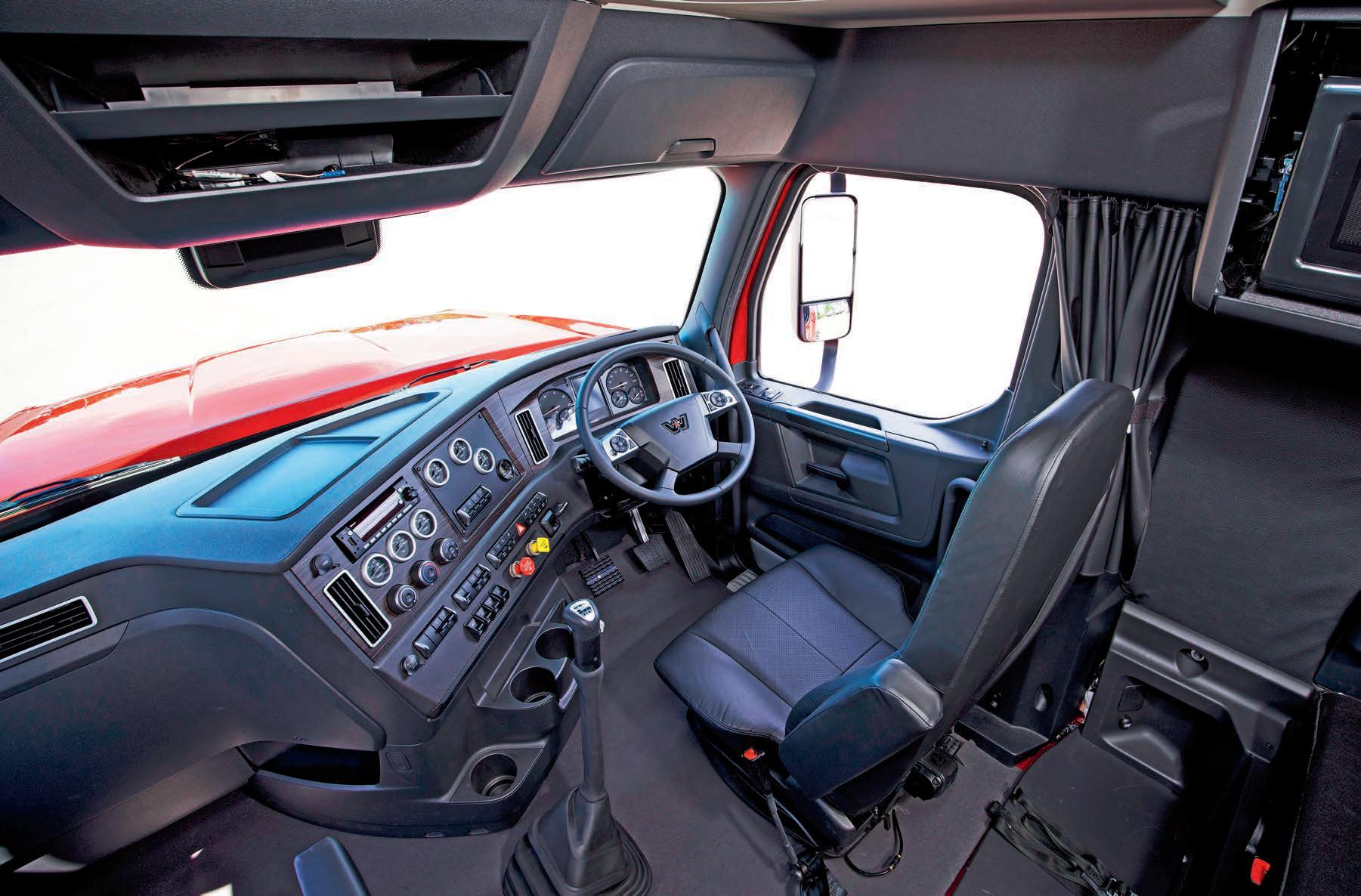
entirely new model range, Penske Australia wasn’t about to let the moment slide by without plenty of facts and fanfare. Indeed, the recent X-series launch was exceptional in both detail and delivery, with a range of loaded models and configurations available for stints around the Mt Cotton circuit and vitally, concise explanations of the many new features that make these trucks so uniquely and decidedly different to their forebears.
The only thing missing, perhaps, was a high-ranking executive from either Daimler Trucks or one of Penske’s US powerbrokers, maybe even Roger himself.
After all, X-series is more a Daimler Trucks North America creation than any previous Western Star, while its critical importance to Penske Australia is no more pronounced than in the assertion that there’s probably no market in the world which will verify the
DECEMBER 2022 63 ownerdriver.com.au
engineering integrity and build quality more than Australia. Still, the local blokes did a top job of launching an altogether appealing family of new Stars.
Even so, there’s not a lot to be gained meandering around Mt Cotton’s well-known circuit other than revealing a snapshot of some features. Like, good driving position and handling, a smooth drivetrain, a quiet cab – but not so quiet to completely deaden the healthy hum from under the snout – good vision through a broad single-piece windscreen and new mirrors, and the absolute worth of a standard hill-hold function.
First up, it’s an easy climb through doors that open 70 degrees with ample access handles and ideal tank steps leading into a neat and practical cab built around a steel reinforced aluminium frame. As Western Star states, it’s all-new and designed from scratch to be ‘lighter, safer, stronger and more spacious than any Western Star cab before’.
It is, however, on the inside where DTNA’s corporate identity and component amortisation are stitched most obviously and predictably into the new Star. The dash, the switchgear, the digital gauge and overall instrument layout, the steering wheel, are all from the same DTNA suite as Freightliner Cascadia. The similarities are stark, but that certainly isn’t a bad thing, particularly when it includes the standard features of the comprehensive Detroit Assurance safety package. Like early Cascadia versions though, these first new Stars hadn’t yet been fitted with a steering wheel airbag.
Still, some Western Star traditionalists – and there are no doubt
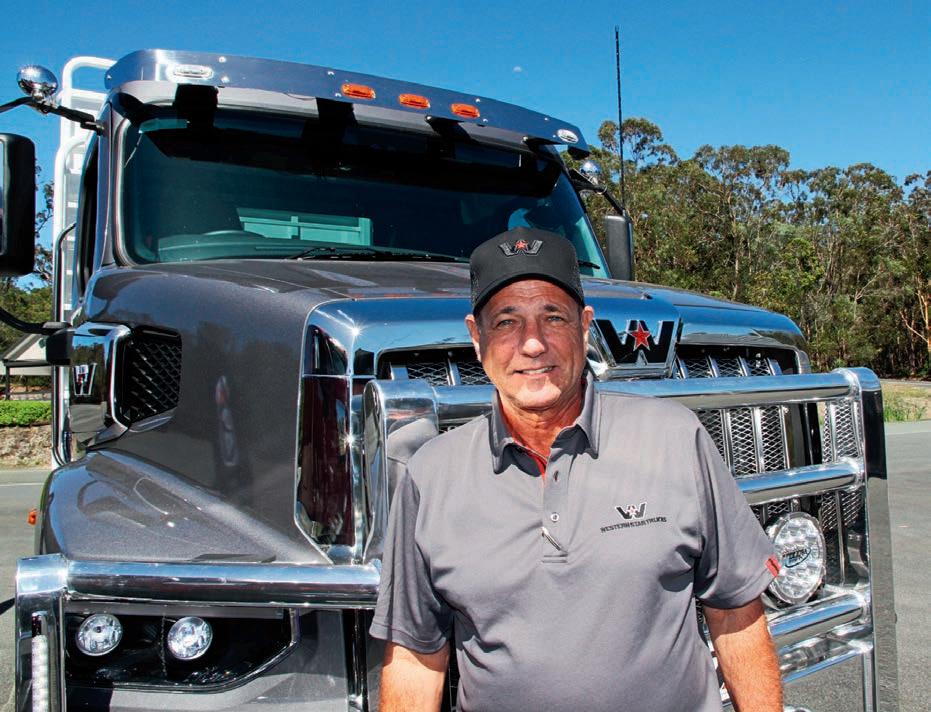
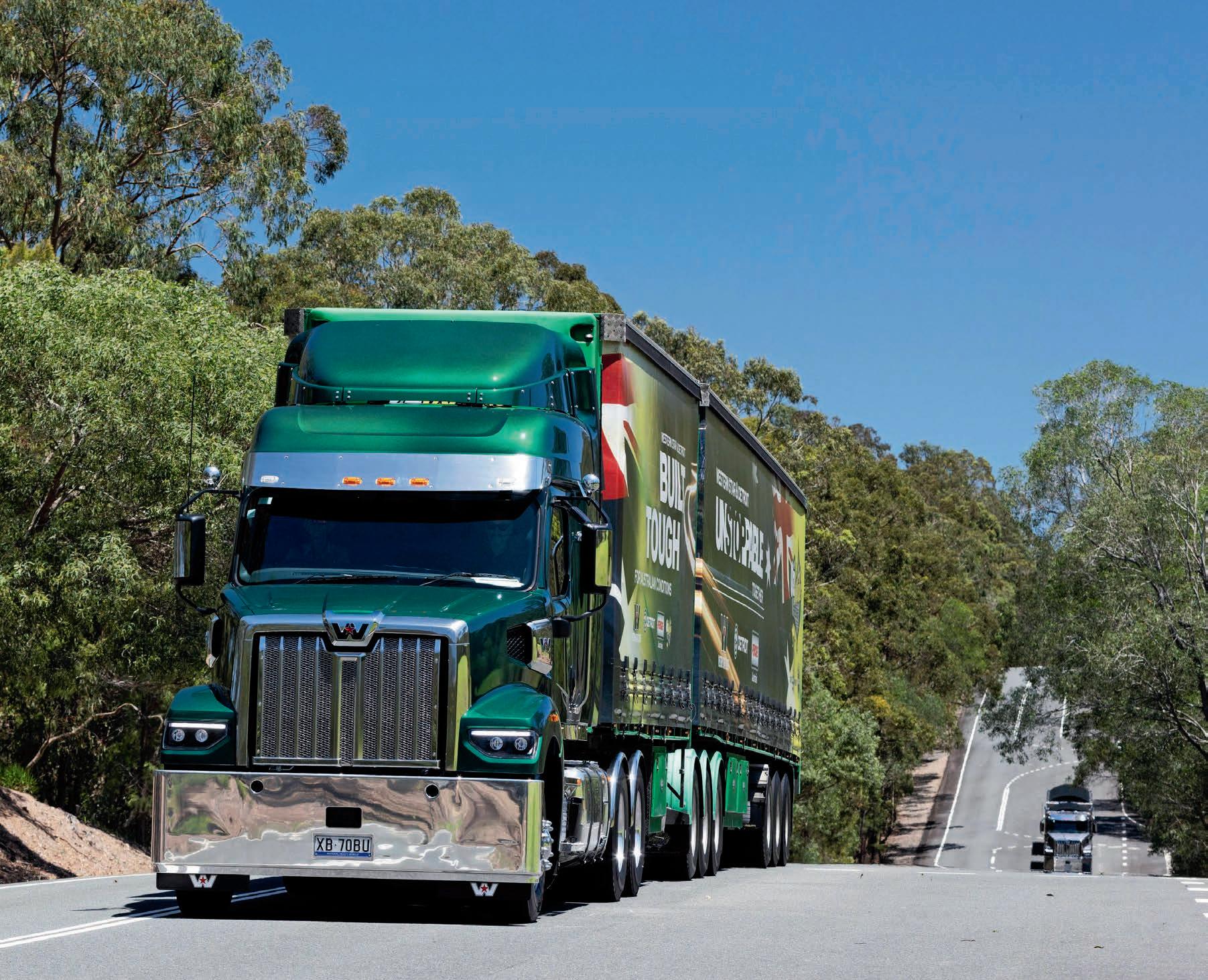
64 DECEMBER 2022 ownerdriver.com.au
“It’s the 48X which seemed to excite Penske people the most … this is the truck built purposely for the Australian market.”
plenty in Australia’s trucking population – may rue the absence of former traits in plush trim and driver-inspired detail but overall, designers and engineers appear to have done an efficient job of merging corporate concessions into a highly versatile model range with durability as the stated core of construction.

Front to back, inside and out, the only thing that appears to carry over from the outgoing model is the badge on the beak and it all starts with what Western Star describes as ‘pioneering high strength single channel chassis rails’ splayed at the front to enhance engine and radiator fitment.
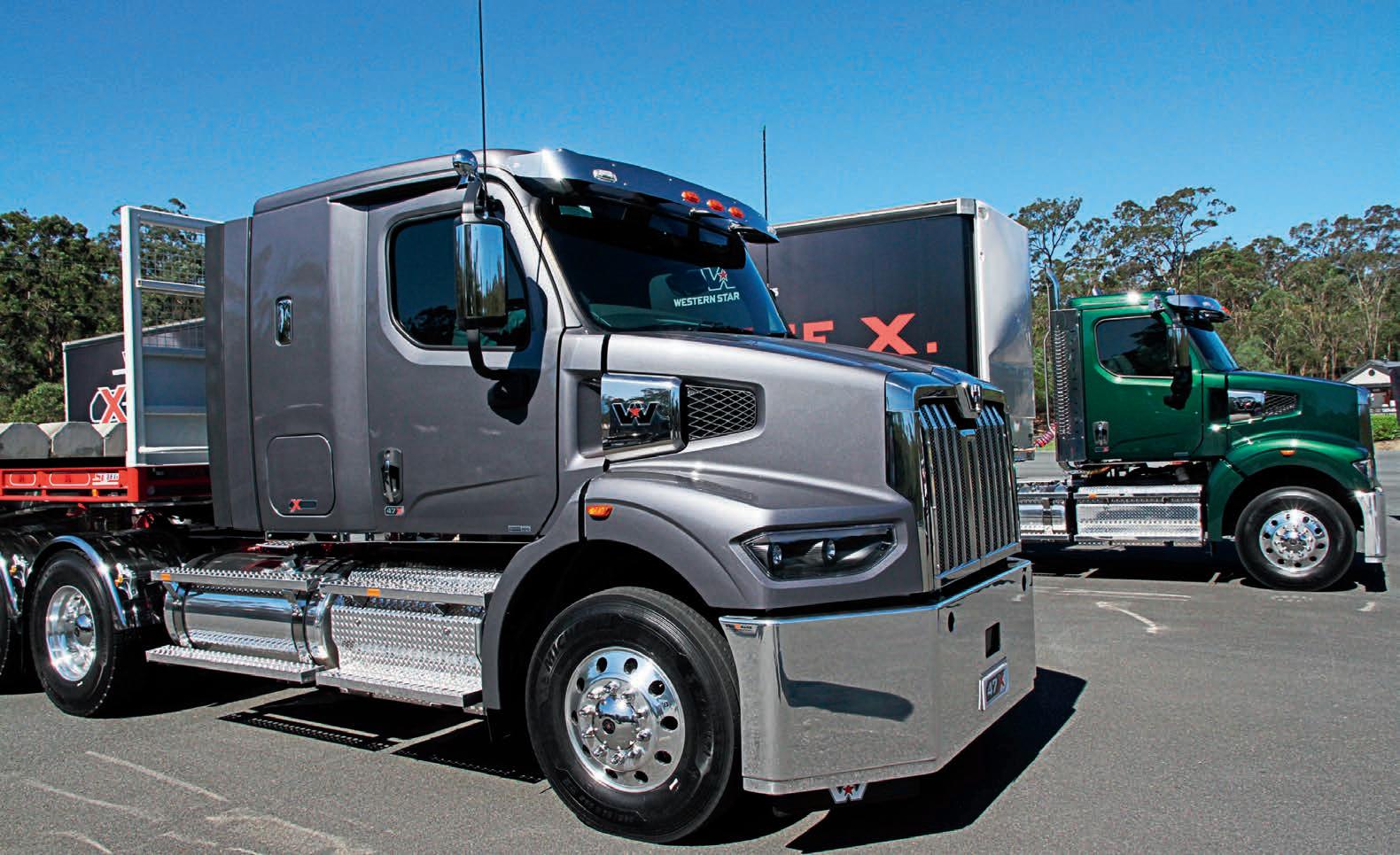
Importantly, all three models are said to use ‘an all-new robust routing and clipping design which keeps air lines and wiring harnesses away from the frame’.
On the design and effectiveness of the cooling system, Penske Australia regional business manager Derek Schroff explained that the radiator is engine mounted rather than chassis mounted to resist torsional stresses, with the DD13 using a 1400 square inch radiator and 1600 square inch with the DD16. Or as a candid Doug Shand remarked, “If the truck can pull it, it can cool it.”
Still on cooling, it’s worth noting that to accommodate the DD16 and equally, enhance the discharge of hot air from under the cab, the 48X model stands 100mm higher above the chassis than its 47X and 49X siblings.
The sloping hood on all models also warrants mention, Derek Schroff continued. Made from a moulded and robotically sealed resin said to be stronger and close to 50kg lighter than previous designs, the hood is isolated from road shocks by being mounted on what Western Star says is its exclusive ‘ISO Tech’ bonnet suspension system, and gratefully, there’s an assistance strut to make it a light and easy one-man lift.
At the front though, it’s hard to see the locally made bumper slab on 48X and 49X models having anything other than a negative effect on fuel economy. Penske operatives say it’s due to the set-forward front axle of the two models restricting a more subtle shape but surely, somewhere in the engineering brains trust that created these trucks, there’s a more efficient alternative. Meantime, customisation remains an integral part of the Western Star portfolio. Aluminium fuel tanks, for instance, are offered in round and square designs, the former in individual capacities from 227 to 567 litres and the latter in 360 to 775 litre capacities.
Likewise, AdBlue tanks come in 30, 49, 87 and 200 litre sizes and in all cases are mounted in a forward position on the lefthand side of the chassis frame.
Exhaust options include single and dual cab-mounted vertical stacks, dual frame-mounted pipes on sleepers, and on the right-
hand side, an under-step after-treatment system with horizontal exhaust.
Up front, Dana and Meritor steer axles are available, including twin-steer combinations for upcoming 47X eight-wheeler and 10x4 models, while at the back are tandem and tri-drive assemblies also from Dana and Meritor.
A comprehensive rear suspension line-up includes DTNA’s AirLiner assembly as well as Neway’s ADZ air suspension, Hendrickson’s air-ride Primaax EX and its severe-duty Ultimaax mechanical stablemate, and DTNA’s rubber block TufTrac assembly.
For now, that’s the broad detail on Western Star’s X-series and before much longer, we hope to put several models through their paces in real world workouts.
In the interim, it’s surprisingly easy to suggest this new line-up is the complete transformation desperately needed to dispose of the mediocrity which over almost a decade, has seen Western Star’s hard won notoriety and reputation slide to the edge of insignificance.
Simply stated, the might of Daimler Trucks North America has breathed new life into Western Star. The job now is for the highest echelons of the Penske organisation to ensure the dedicated and determined people who run the Australian operation are equipped with the ongoing support and enterprise to ensure this new Star does what it is so obviously designed to do – shine brightly!
Top: Low-line sleeper version of the 47X and behind, slimline 48X. There’s plenty of versatility in the X-series range
Above: Flagship 49X in B-triple configuration on the Mt Cotton circuit. Pre-production versions have been doing tough outback roadtrain work in the lead-up to the X-series launch
Opposite top: Potential plus! 48X in linehaul B-double guise. A smart spec and exclusive to the Australian market
Opposite bottom: Western Star stalwart Doug Shand. He’s convinced this is the most exciting range of trucks ever to bear the Star badge
DECEMBER 2022 65 ownerdriver.com.au
MAN ON A MISSION
Penske Australia is pushing harder than ever to put MAN on a higher pedestal in a fiercely competitive crowd of classy cab-overs. It’ll be a tough task but the introduction of a much modernised range in a booming market provides the perfect platform to gain ground and judging by the recent performance of a top-shelf TGX 26.640 model, the big MAN from Munich is certainly ready to rumble. Steve Brooks reports
So often over so many years, MAN has been a case of desire outstripping deed. Simply, more hopes than highlights. Still, there’s no question that throughout the brand’s long association with the Australian market, there have been tasks and times when the German stalwart has notched notable success in a wide range of roles. In specialised vocational and off-road roles, for instance, MAN’s achievements are considerable while most recently, its high-profile presence in Australian military applications was achieved after a highly competitive and tediously thorough selection process. It was, in short, chosen as the best man for the job.
That’s not to imply, of course, that MAN hasn’t also won good business in large commercial fleet operations, small fleets and single truck companies, not least a large Australia Post order for medium-duty models some years back. Whatever, the big German is certainly no stranger to Australian roads, anywhere.
Even so, big orders have generally been few and far between and the reasons for that are no doubt, many and varied. Consistency, however, must surely rate as one of the biggest bugbears and over many decades, the brand has shifted from factory-owned operations to being part of entrepreneurial distributorships, including its current standing within Penske Australia.
Nonetheless, operational consistency of the MAN brand in Australia appears to have stabilised somewhat since US automotive mogul Roger Penske spent a reported $219 million to take control of Transpacific’s Commercial Vehicle Group in 2013, becoming the exclusive importer and distributor in Australia and New Zealand of MAN trucks and buses, and Western Star and Dennis Eagle trucks.
However, consistency has been also evident in historically modest sales volumes. At the end of 2013 when Penske’s organisation was still putting the finer touches to its newly acquired Australian business, MAN
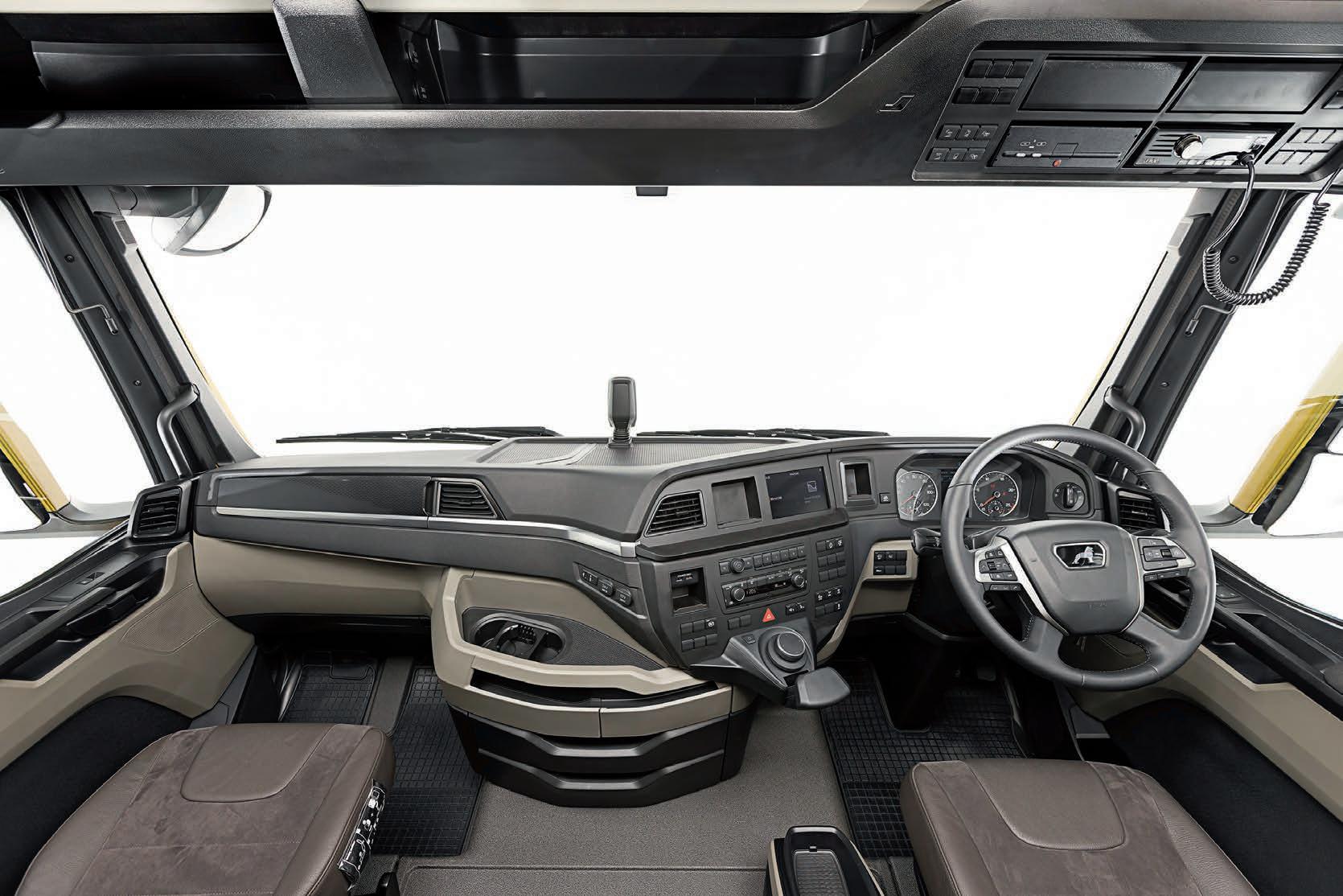
66 DECEMBER 2022 ownerdriver.com.au
road test
finished the year with a lacklustre 2.3 percent of the heavy-duty sector and a wafer thin 1.6 percent of the medium-duty market. Annual volumes were even marginally less the following year while now, in the closing stages of 2022, the brand is on track to record much the same mediocrity.
Without question, MAN’s best years so far were in the reasonably solid markets between 2017 and 2019. Best of all was 2018 when sales of 520 units delivered 3.6 percent of the heavyduty sector and 698 medium-duty sales returned a respectable 8.5 percent of a category absolutely dominated by Japanese brands.
But since then, and with COVID-induced supply issues adding their own unique pressures, MAN’s momentum has slid back to the consistently modest volumes of earlier times.
The tide, however, may be turning. There’s a distinct change in the air as Penske Australia now appears more intent than ever on taking MAN to a higher presence in the fiercely competitive, extremely crowded and high quality cab-over market. It’ll be no easy task but there are a couple of factors making this latest effort demonstrably more determined, and potentially more rewarding, than seemingly half-hearted past attempts to boost the brand’s prominence.
For starters, with record-breaking demand for trucks, the overall truck market is booming like never before and from all indications, strong demand is likely to continue into 2023 and maybe beyond.
Moreover, it’s also apparent that Penske Australia is for the first time in its tenure throwing considerable resources and funds at promoting MAN to mainstream trucking audiences as a serious cab-over contender. For much of Penske Australia’s existence, product promotion beyond decals on Roger’s beloved racing cars, has often appeared to be more an afterthought than a dedicated pursuit.
And most critically, there’s now plenty to promote in the form of a heavily modernised model range hailed as the first newlydeveloped MAN truck generation in two decades.
Bluntly stated, it could be confidently asserted that MAN has never had so many positive forces align in its Australian history.

DECEMBER 2022 67 ownerdriver.com.au
Above: Thoroughly modern interior and extremely comfortable. Bunk space is typically European but there are many new and worthwhile features
“There’s a distinct change in the air as Penske Australia now appears more intent than ever on taking MAN to a higher presence.”
Above: MAN among men. The cab-over market is incredibly competitive but MAN’s opportunities are nowadays better than ever
Opposite top: Surprising inclusion on the TGX demonstrator was this additional air filter developed for extremely dusty conditions
Likewise, it could be equally asserted that with the combination of a bold new model line-up, cashed-up marketing and promotion programs, and a market literally screaming for new trucks, that if the brand doesn’t make a significant move up the commercial vehicle sales ladder over the next year or two, then it probably never will.
There is, of course, absolute optimism within Penske Australia that better times are just around the corner. As Craig Lee, general manager of on-road at Penske Australia said at the official launch of the new TGL, TGM, and heavy-duty TGS and TGX models a few months back, “We are very confident that our existing customers will see the value and see the benefit in this truck, but more importantly than that, we’re very confident that new customers will see the brand and will benefit from those features and benefits that we’re bringing to the market.
“So we’re here to express our confidence that over the next 18 to 24 months we will more than double the market share we enjoy today.
“And we are going to actively take it to our competitors,” he
enthused, pointing the finger squarely at Volvo, Scania, MercedesBenz and Paccar’s pair, DAF and Kenworth. Tall order, for sure, especially given the quality, acceptance and competitive acumen of the market’s big players but again, MAN has never had so many positive influences in its favour.

Yet whatever the executive expectations, there’s no question the next year or two will be a tell-tale time for MAN in this country. Equally, it’s easy to contend that if all the new trucks are similarly smooth, potent and well-mannered as the flagship TGX 26.640 B-double outfit driven recently, there’ll be a few high profile heavy-duty brands looking suspiciously over their shoulders.
Short ‘n sweet
Wet and wild weather was saturating the east coast, and with floodwaters rising in most directions and just one day up our sleeve for the exercise, the safe option was a 500km return run from Northstar Motors at Heatherbrae just north of Newcastle, up the M1 to Kempsey and back again.
There are a few good pulls in both directions and with the outfit just a few hundred kilos shy of 60 tonnes, the big MAN would at least have to dig some way into the 15.2 litre D38 engine’s hefty reserves of grit and grunt, peaking at 471kW (640hp) at 1800rpm and top torque of 3000Nm (2212lb-ft) on tap from 900 to 1380rpm. As the run would soon reveal, it’s plenty of punch for a standard gross combination mass rating of 70 tonnes and optional 90 tonnes.
It’s worth noting, too, that the 580hp (2900Nm/2139lb-ft) version of the D38 remains an integral part of the new range with
68 DECEMBER 2022 ownerdriver.com.au
life easier and safer for
driver
“Making
the
was a major feature of MAN’s design goals for its new range.”
the same ratings and drivetrain as its 640 sibling.
Meantime, it’s no secret Australian conditions have at times created reliability issues for the D38. Of course, Australia’s ability to extract powertrain problems that don’t exist in other markets certainly isn’t unique to MAN and as with other brands, the introduction of a substantially improved model range generally comes with modifications to fix earlier issues. Besides, our sources assure us the things that needed to be fixed, have been fixed, while retaining the fuel efficiency derived from the potent torque output and lugging ability of a big bore engine with two-stage (high and low pressure) turbocharging.
What’s more, in both ratings this latest version of MAN’s big six common rail engine complies with an advanced Euro 6e emissions standard, using a combination of EGR and SCR systems and what MAN calls a ‘continuously regenerating trap’, or CRT.
Stirring through the supremely smooth shifts of the ZF-designed MAN Tipmatic 12-speed overdrive transmission, performance goes to the ground through hypoid rear axles running a 3.36:1 final drive ratio, riding on an electronically controlled airbag rear suspension. Up front are parabolic leaf springs.
Also, the Tipmatic transmission offers two shift modes – ‘efficiency’ and ‘performance’, the latter designed to deliver fractionally faster shifts at higher points in the rev range. Yet other than a short stint in ‘performance’ purely for the sake of it, the ‘efficiency’ setting coped ideally with all road conditions. Typical of most modern automated shifters, Tipmatic is a highly intuitive and responsive transmission with seamless shifts programmed to make the most of the engine’s willingness to lug deep down the rev range.
First things first though, and the old saying that ‘beauty is in the eye of the beholder’ is certainly relevant to trucks and in this opinion, there’s a visually pleasing quality and style about MAN’s flagship model. With its eye-catching curtains, the B-double demonstrator wasn’t easy to miss, but nor was it easy to miss an usual addition to the front of the truck.
Riding shotgun for the day was Penske Australia’s Michael Di Ramio, an MAN mechanical man for much of his working life, who explained that the attachment was effectively an extra air filter designed for extremely dusty conditions, and fitted to the test truck to highlight MAN’s ability to meet extreme conditions.
Making life easier and safer for the driver was a major feature of MAN’s design goals for its new range and it starts with an easy ascent into the cab and the quick realisation that control functions on the
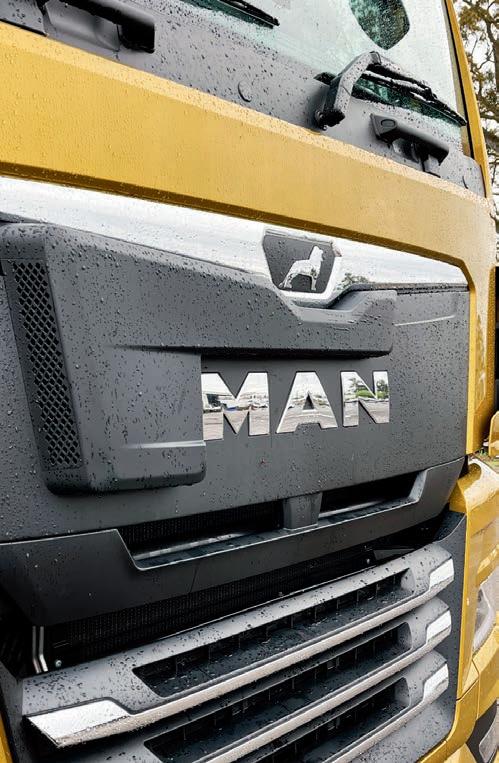


steering wheel and dash for the multitude of systems and features are at least sited for easy access. Sure, it takes a while for familiarity to set in but with Michael Di Ramio pointing out the various features and functions, it didn’t take long to feel at ease with most of the switchgear and operation wands. What’s more, it is a neat and appealing layout from the driver’s seat.
It’s worth noting though, that while the interior design of this line-up is appealing in many ways, it is entirely different to its predecessors and it would take far more space than available here to list all the new truck’s features including a comprehensive suite of advanced safety functions equal to any in the business. Consequently, while Michael’s explanations were invaluable in this exercise, particularly with the many useful features of the ‘infotainment’ and navigation system, there’s much to absorb and driver instruction on the many systems and features will be paramount.
It takes no help, however, to find a comfortable driving position and moreover, MAN’s insistence that new mirror housings are designed to lessen visual
DECEMBER 2022 69 ownerdriver.com.au
comfort, steering, ride quality
intrusion is well founded. Strangely though, the test truck was still fitted with European convex mirror glass but as Michael Di Ramio said, flat glass is obviously the standard for Australia.
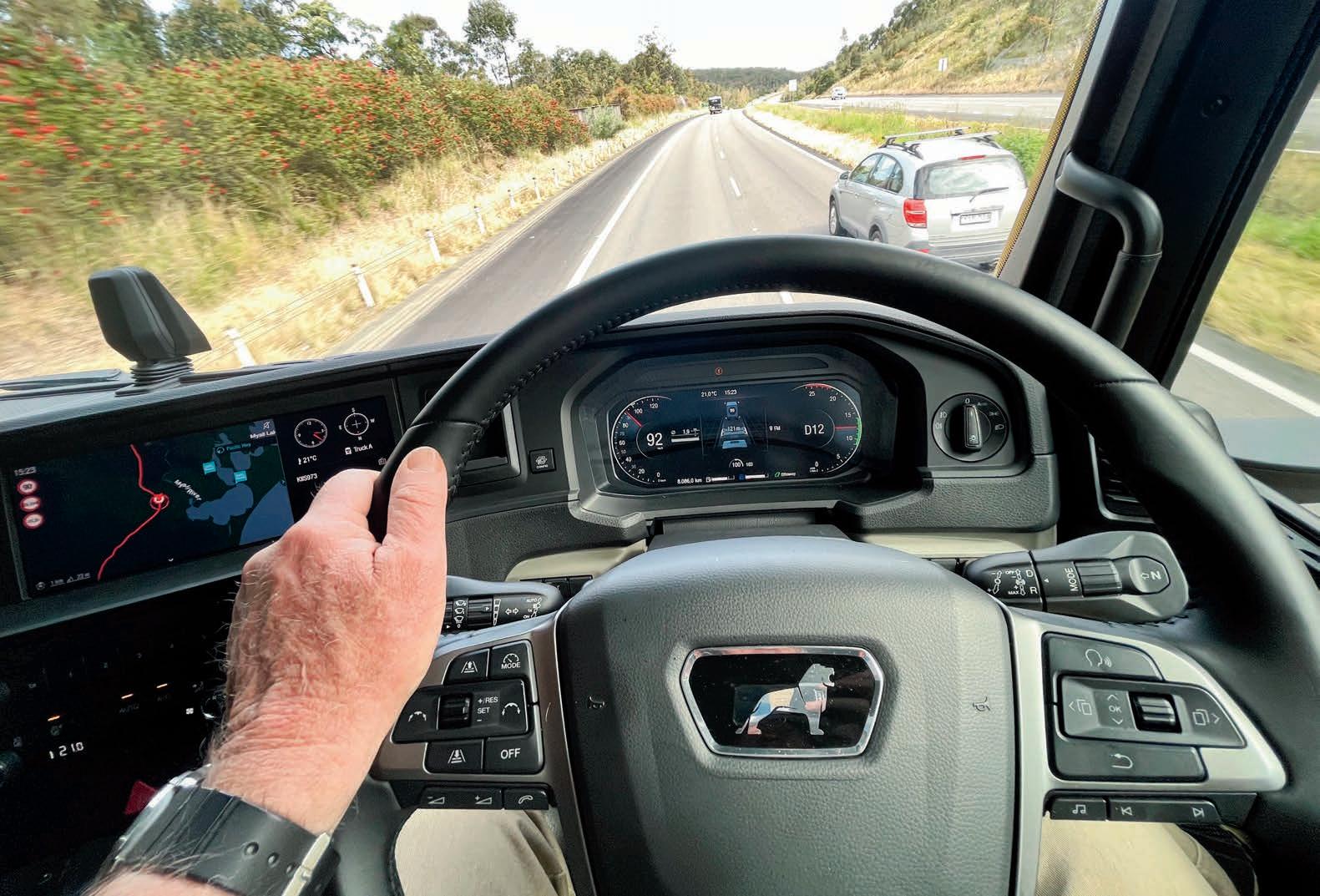
On-road performance was impressive from the start and aside from some of the finer details of the various operating systems, it took no time at all to feel entirely content with the big MAN.
to form a definitive opinion of the truck’s long-term capabilities but it was enough to suggest that MAN has a hugely impressive powertrain.
On the northbound climb over Coolongolook, for example, the combination dropped to 7th gear at 1600rpm with the shifter in auto mode. It was easy to contend, however, that allowing the engine to lug in manual mode would deliver an even stronger effort on the similarly demanding southbound climb, and so it did, cresting the hill easily in 8th gear at 1400rpm.
Meantime, on downward stretches the strength of MAN’s Turbo EVBec (Exhaust Valve Brake) auxiliary braking system was quite remarkable. Fitted to 580hp and 640hp ratings and said to produce up to 840hp of retardation effort, MAN says the brake’s effectiveness largely derives from positioning of the exhaust flap upstream of the turbocharger which allows more back pressure to build up during braking.
As the company explains, ‘When the exhaust flaps are closed, high flow speed results at the remaining opening gap due to the nozzle effect (and) targeted air flow to the turbocharger blades increases the turbine speed on the exhaust side and therefore, also increases the speed on the intake side.’
Thus, ‘the pressure level in the engine is raised and the brake output increases.’ Importantly, the technical description also states, ‘a large part of the heat energy produced during braking is dissipated outside directly through the exhaust gas stream. Therefore even on long downhill gradients, brake output is not reduced,’ MAN concludes.
Whatever, auxiliary braking on the D38 engine is immensely strong.
Top: From the driver’s seat. The overall layout is neat and efficient but typically, familiarity with the various functions takes time
Above: New mirror housings are not as intrusive as previous designs. Strangely, the demo truck was still fitted with European convex mirror glass
In-cab comfort, steering, ride quality and overall road manners are exceptionally good and in a highly competitive cab-over field, the TGX rates highly in comparison with any competitor. Top marks!

Likewise, pulling power of the 640hp D38 with just 7600km on the clock was not just strong but equally, stunningly smooth, with the driveline delivering 100km/h at a twitch over 1300rpm.
Of course, one day behind the wheel is certainly not enough
Yet for all its strength hauling almost 60 tonnes with relatively few kilometres on the clock, the MAN flagship returned highly respectable fuel consumption. Turning around at Kempsey, the on-board computer showed 1.9km/litre (5.37mpg) but as the combination turned back into the Northstar dealership in Heatherbrae, the figure flicked to 2.0km/litre, or 5.65mpg.
In conclusion, there’s much more to the TGX 26.640 than mentioned in this report and while MAN may not be traditionally foremost in a crowded market of premium cab-overs, this latest flagship appears to warrant much more than casual consideration.
More to the point perhaps, it certainly warrants the effort Penske Australia is now applying to the big MAN from Munich.
70 DECEMBER 2022 ownerdriver.com.au
“In-cab
and overall road manners are exceptionally good.”
VICTORIA’S BIG GRANT TO IVECO ZERO EMISSIONS PROGRAM
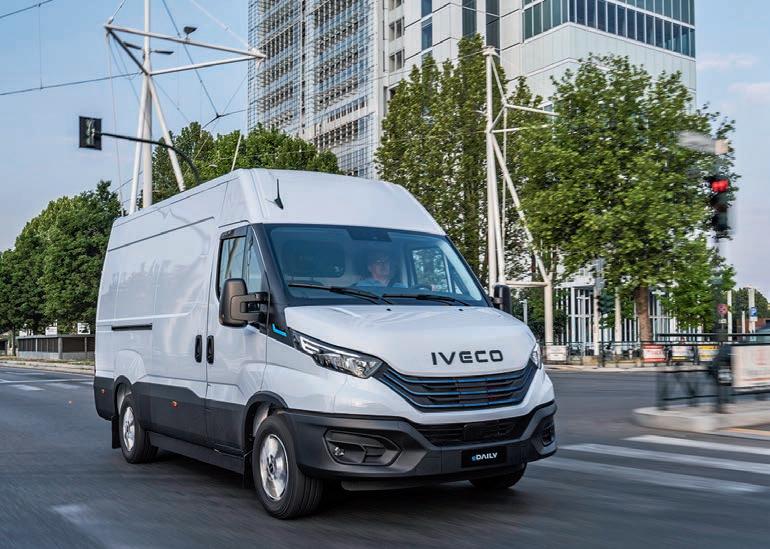


Iveco Trucks Australia has been offered a $500,000 grant as part of a broader Victorian Government initiative designed to encourage more Victorian-based businesses to introduce and support zero emission vehicles.
One of only four recipients, Iveco says it will allocate the funds towards three principal channels – comparative research, additional site preparation of its Customisation and Innovation Centre (CIC) in the lead up to local zero emission vehicle launch, and upskilling of relevant employees to properly facilitate the product rollout and subsequent support.



Iveco Trucks Australia strategic projects and industry relations manager, Marco Quaranta, says the funding has been warmly received and would assist the company to further plan for the introduction of its zero emission vehicles in Australia and New Zealand, beginning with the latest generation Daily Electric.
“Given the differences in technology between traditional diesel and zero emission commercial vehicles, considerable pre-launch preparation needs to be undertaken,” Quaranta says.



“Our funding submission took a holistic approach by identifying three key areas that we thought were vital to the successful introduction of zero emission models, these centred around tooling, training and total cost of ownership comparisons (TCO).”
For the research component of pre-launch preparations, Iveco has announced a partnership with Swinburne University of Technology to review existing data and conduct original research between diesel, electric and hydrogen power generation technologies.
To deliver training programs in support of new zero emission models, Iveco says it will again partner with leading tertiary institutions to upskill relevant
staff as well as technicians across the dealer network prior to launch.



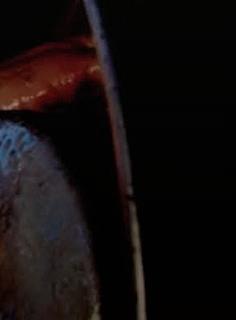



“Maintaining electric vehicles requires a highly specialised skillset – the technicians need to have knowledge that more closely matches that of an electrician, rather than a mechanic,” Quaranta says.
Grant funding will also be used to develop a common space

within the CIC facility, which will include unique tooling and safety infrastructure to allow the Iveco team to properly support and maintain the zero emission range prior to and following its launch.
Quaranta said Daily electric light commercial vehicles will arrive in Australia around the middle of 2023 for local testing and evaluation.

DECEMBER 2022 71 ownerdriver.com.au tech briefs
Why waste unnecessary time polishing alloy wheels? Superchrome wheels wash clean in just 41 seconds. So, you can stop wasting your time on wheel maintenance and get on with your life. Longer wheel life | No polishing costs | Quality presentation Call Superchrome on 02 9060 1610 or visit us at www.superchrome.com.au Scan me
TRACSERV’S NEW DEALER PRINCIPAL
There’s been a changing of the guard in the Great Western Plains region of New South Wales, with Tracserv in Dubbo appointing a new dealer principal.
The dealership’s founder Richard Kirby passed the torch on to his daughter Leandra Gale on September 19 this year, the 33rd anniversary of starting the business with his late wife Sharon Kirby and a mate from the back of a ute.
Gale has been involved with the business since she was two years old but became an official employee about 10 years ago.
“I went out into the big wide world and but wanted to return to Dubbo, so I began in the service department in 2012, then moved up into stock controller, business accounting, then business manager and now dealer principal,” she says.
Gale credits the “big extended family” of Tracserv for her career success.
“The business has been part of my life since I was two!” she says.
“I’ve grown up around the people who I’ve watched expand and lead our business and now I get to work with them, so it’s like a full 360. Our current management team has been with Tracserv for over 15 years.
“My brother Daniel, who is also an integral part of the business, and I would often spend our weekends here in the workshop because dad was a mechanic,” Gale recalls.
Gale says she hopes her appointment as the first female
dealer principal in the Isuzu Australia Limited (IAL) network inspired other women to consider a career in the automotive industry.
“It’s an awesome opportunity for women in the industry.
“We’re not just going to be the receptionist, we can be the dealer principal, we can do anything.
“We have women in every department at Tracserv now, spare parts, in service, we don’t have any in the workshop just at the moment. We love a bit of girl power around here.”
IAL chief of sales and aftersales, Ben Lasry, congratulated Gale on
her appointment.
“I can say with great confidence that truck customers in and around Dubbo remain in the safest of hands with the Tracserv family,” Lasry says.

Gale says one of the best things about her role as dealer principal was that it was based in the friendly and relaxed country town of Dubbo.
“Dubbo is big but not huge, so we know who we’re selling trucks to and what they do in their business and if we ever need something done here, like landscaping, we can just look up our customer base and
TRANSITIONING TO SMART ON-BOARD MASS AND TELEMATICS MONITORING
Global telematics specialist
Teletrac Navman says it will assist transport operators across Queensland to transition to new and improved Smart On-Board Mass (Smart OBM) and Telematics Monitoring Application (TMA).
Giving Queensland operators the opportunity to be more productive and efficient, Smart OBM monitors the mass of a vehicle combination’s axle groups, while TMA records important positional information, which Teltrac Navman says in an aggregated form can provide valuable insights on truck movements.
Smart OBM and TMA are critical tools for the Department of Transport and Main Roads (TMR) as a way to provide assurance around heavy vehicle access to the state road network.
Jurisdictions across Australia are moving to Smart OBM and TMA, with NSW and Victoria already using the technology.
Since December 1, Class 2 heavy vehicles operating under Queensland Interim OBM and Higher Mass Limits (HML) in the Intelligent Access Program (IAP) are required to transition to Smart OBM and TMA.
Thirteen years ago, Teletrac Navman says it began championing the Intelligent Access Program (IAP), a national program developed in partnership with all Australian road agencies. Through this program, many Australian customers have been able to increase productivity. The new Smart OBM and TMA technology enable a greater ROI thanks to the lower cost of the tech set-up and additional requirements,” says Teletrac Navman’s national manager, transport, Anthony Laras.
“Transport operators will see the long-term benefits because governments will be able to fix the roads that need to be fixed, which can’t be done without good data.
“It’s a change for the greater good that will allow Australia’s network
of access for heavy vehicles to be connected.
“At a time when Australia is facing multiple threats to our supply chain, with staff shortages, floods and storms destroying crops and roads, and the ever-rising cost of fuel, an opportunity to save costs by enabling a safer, faster solution is a win for us all,” Laras says.
The transition to Smart OBM and TMA is said to be a crucial step towards national harmonisation and cross-border efficiencies. It also claims to deliver potential cost savings and operational efficiencies to the industry.

“If we can give transport operators the ability to move more with less, that truck is suddenly generating more revenue by saving on fuel, driver hours and maintenance costs.
“It means fewer trips for drivers, fewer truck movements, less CO2 emissions, less tyre wear and tear, more profit, and more safety,” Laras continues.
Smart OBM and TMA are critical
think, ‘Oh, I know that guy he’ll come and help us out’,” she says.
“We’re just really lucky to be living here.”
Gale encourages others who aspired to become dealer principals to work their way through every part of the business. “Don’t get ahead of yourself, trust the process,” she says.
Leandra Gale’s business leadership has been recognised by the Dubbo Chamber of Commerce, who named her a finalist in the Outstanding Young Business Leader category of their 2022 Rhino Awards.
road management tools for TMR, providing ongoing access to telematics data. This data is essential to ensure continued heavy vehicle access to the road network under current access arrangements and factors into additional access considerations in the future.
Smart OBM and TMA are Intelligent Transport Systems certified by Transport Certification Australia.
ABOVE: Anthony Laras, Teletrac Navman’s national manager, transport
72 DECEMBER 2022 ownerdriver.com.au tech briefs
Leandra Gale has taken over as dealer principal at Tracserv in Dubbo
ZERO EMISSION HYDROGEN ELECTRIC TRUCK RELEASED IN UK

Zero-emission, long-range hydrogenpowered commercial vehicle manufacturer, Hydrogen Vehicle Systems (HVS), has unveiled what it says is a clean-sheet-designed hydrogen commercial vehicle.
Showcasing its hydrogen powertrain in the form of a 5.5-tonne technology demonstrator, HVS says the new truck offers a hint to its planned 40-tonne zero-emission HGV (Heavy Goods Vehicle), fulfilling the company’s objective of being the first indigenous UK designed and developed hydrogen-electric HGV on the market.
Glasgow-based HVS was founded in 2017. The company boasts industry specialists, with vast experience in the automotive, energy, hydrogen technology, power electronics, sustainability and environmental management fields.
With UK government targets to curtail sales of all non-zero emission 3.5–26 tonne HGVs set to come into play by 2035 or earlier and all sales of new non-zero emission HGVs by 2040, HVS believes its technology has the potential to play a crucial role in allowing emissions reduction targets to be achieved.
The company claims a defined route to market. In addition to funding from Innovate UK, Scottish Enterprise and Energy Technology Partnership, HVS’s strategic investment partner is the service station and grocery corporation, EG Group, offering hydrogen refuelling infrastructure, fleet customer base and the potential for global scalability.
“This technology demonstrator showcases our ground-breaking hydrogen-electric commercial vehicle design and advanced powertrain technology, a precursor to our HGV model,” says HVS CEO Jawad Khursheed.
“Fuelled by close-coupled green hydrogen (hydrogen produced directly by renewable energy sources such as hydro, wind or solar) our zero-emission trucks are a key part of decarbonising the logistics sector.
“Hydrogen is the perfect fuel for the haulage industry, offering long ranges and quick refuelling thanks to stations easily integrated into key transport networks.
“What’s more, we will supply our customers with the most advanced HGV in the sector delivering a step change in driving experience, lowest total cost of ownership and marketleading fleet management support.”
HVS says its units will be built on an all-new chassis, designed in-house around the hydrogen powertrain, which consists of pressurised hydrogen cylinders, fuel cells, energy storage system and eAxle.
HVS states that its vehicle powertrain employs a fuel cell system and energy storage system to deploy electricity to an electric motor to transmit power to the wheels. It uses the KERS (kinetic energy recovery system) to recapture energy under braking and while the truck is slowing down.
The fuel cell is said to permit longer range, higher load-carrying capacity, and faster refuelling than would be possible using Lithium-Ion battery technology alone. It adds that typical refuelling time is comparable to diesel.
HVS advises that the only emission from the vehicle is water vapour, meaning there are no harmful greenhouse gas emissions of any kind.
Depending on the journey – the route travelled, road conditions and driving style – HVS says its HGV has the capacity to cover in excess of 500km.
“Hydrogen-powered vehicles don’t need charging like a batterypowered EV,” says HVS. “They are refuelled with hydrogen gas, stored at pressure in hydrogen cylinders. Refuelling takes a much shorter time than charging an equivalent battery vehicle and is comparable to filling a truck with diesel.
“Many hydrogen fuelling stations will be located at existing gas stations, using dispensers that look very similar to conventional petrol and diesel ones, but with a different nozzle.”
The Volvo Group and North American-based Pilot Company have signed a Letter of Intent for the development of public, high-performing charging infrastructure for medium- and heavy-duty electric vehicles.
Volvo Group says the strategic partnership will combine its experience in battery-electric trucks and charging solutions with Pilot Company’s network of more than 750 Pilot and Flying J
locations across North America.
Volvo says Pilot Company intends to install highperformance charging infrastructure at selected Pilot and Flying J travel centres across the US and will be open to mediumand heavy-duty vehicles of all brands.
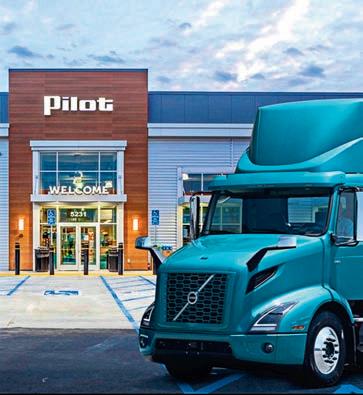
The Volvo Group and its commercial truck brands in North America, Volvo Trucks and Mack Trucks, will identify selected Pilot and Flying J locations to be prioritised for high-performance charging, based on customer and driver needs, current and anticipated battery-electric truck density, and the availability of public funding to support infrastructure costs.
Volvo says this initiative will provide customers of any commercial truck brand the necessary peace of mind to consider adopting electric trucks, eliminating range anxiety and give the prerequisites for the North American fleet customers to meet their environmental goals on their decarbonization journeys.
Volvo says the intended partnership places it and Pilot Company at the forefront of accelerating electrification and developing sustainable and reliable transportation solutions in North America for generations of battery-electric trucks to come.
DECEMBER 2022 73 ownerdriver.com.au
NORTH AMERICA TO CHARGE UP WITH NEW NETWORK
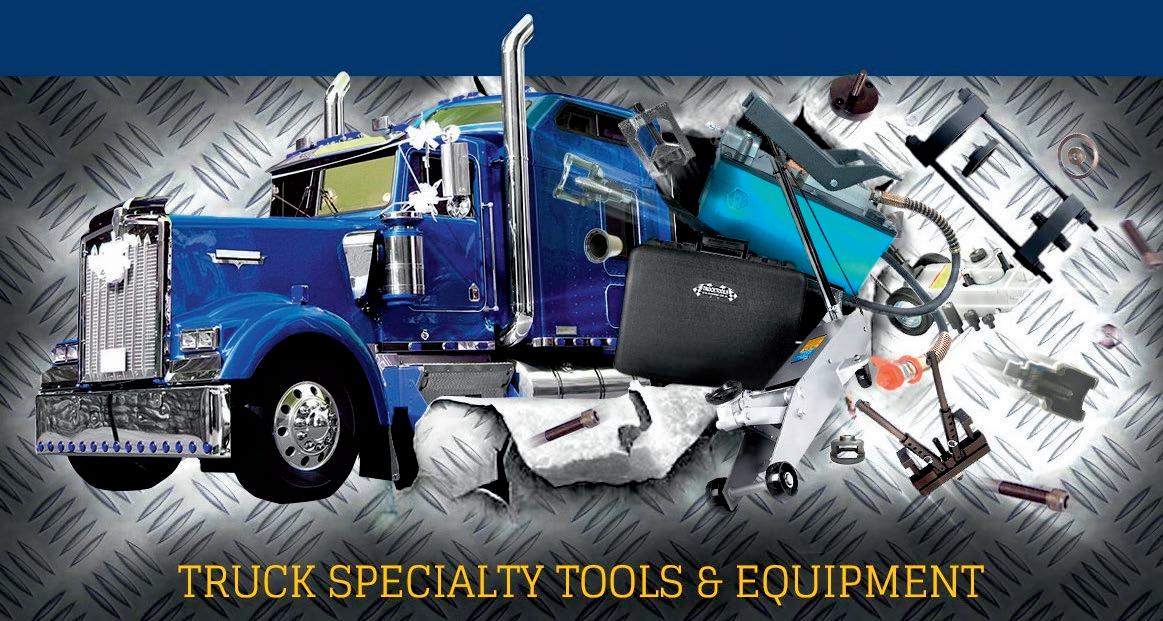
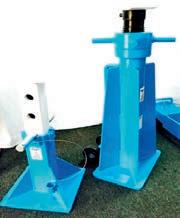






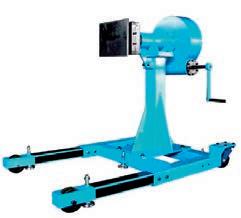
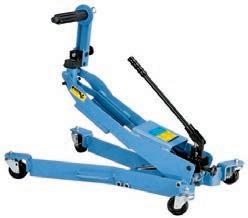



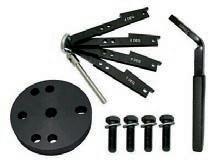
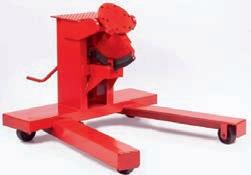



Australia’s Largest Speciality Truck Tool Supplier. The Right Tool For The Right Job. Products To Keep Your Investment On The Road. TRUCK REPAIR TOOLS AND WORKSHOP EQUIPMENT Australian owned and operated Australia’s Products To Keep a • TRUCK ENGINE TOOLS AXLE HUB NUT Ph: 1800 Australia’s Largest Specialty Products To Keep Your Investment On The Road. a • TRUCK ENGINE TOOLS • DRIVELINE / TRANSMISSION TOOLS • WORKSHOP • AXLE HUB NUT SOCKETS • HAND TOOLS / TORQUE WRENCHES Ph: 1800 000 561 or 03 9703 ONLINE CATALOGUE Warehouse location FREIGHT AUSTRALIA WIDE www.trucktools.com.au Phone 03 9703 2000 Freecall 1800 000 561 info@trucktools.com.au Huge Range - Best Prices - Best Service - Quality Products 1800 000 561 - AUSTRALIA WIDE SERVICE Warehouse Pick-up available subject to prior arrangement www.trucktools.com.au



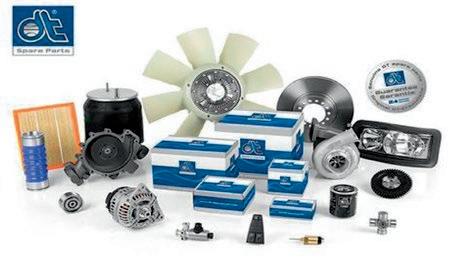


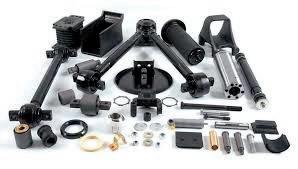





















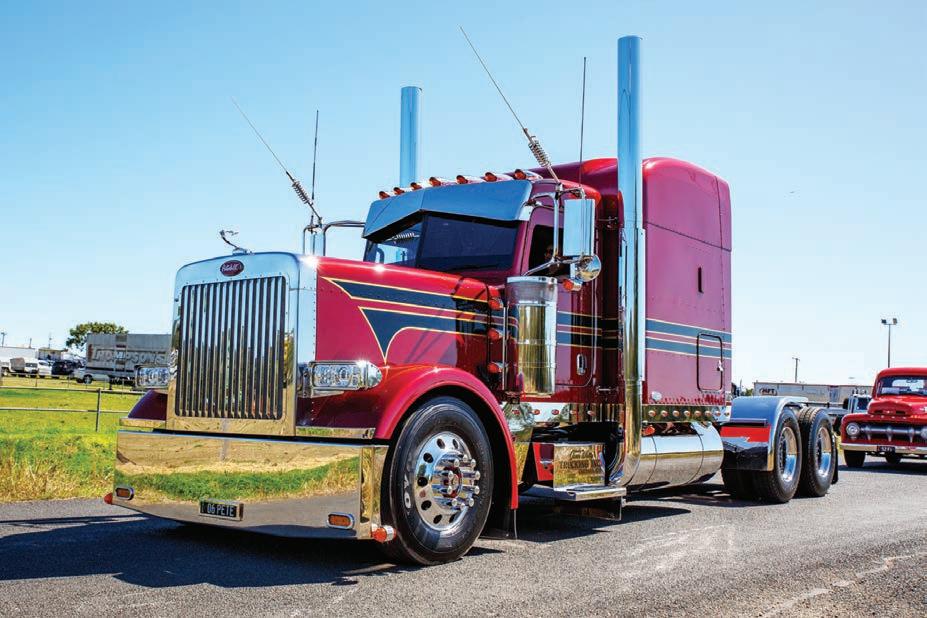
CHRISTMAS TRADING HOURS Normal Trading Hours Monday 19th December to Friday 23rd December 2022 Closed from Saturday 24th December to Tuesday 27th December 2022. Re-open on Wednesday 28th December to Saturday 31st December 2022. Closed on Monday 2nd January 2023. Normal Trading Resume on Tuesday 3rd January 2023 2019 PETERBILT 379 With a C-15 Glider. 80 000km on brand new everything, still under warranty, 06PETE. QLD. DIY1155516 Ph: 0407 721 667 $365,000 incl. GST SELL YOUR TRUCK VISIT TRADETRUCKS.COM.AU/SELL OR CALL 1300 362 272

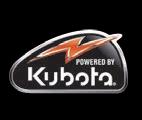




























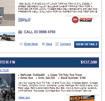
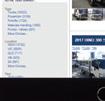






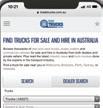

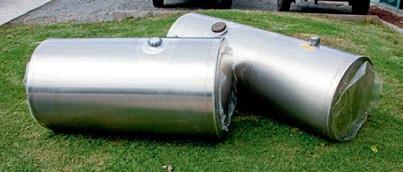
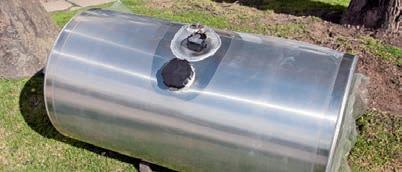

CONNECT LEGAL CONNECT LEGAL OWD-EP-5190898-TS-302 SACKED OWNER DRIVERS REDUNDANT OWNER DRIVERS Specialist Transport Legal Advice Helping Owner Drivers Aust-wide for over 20 years • Redundancy and Loss of Contract Claims • Unfair Contract and Award Claims • Advice Owner Driver Legislation Australia wide Contact Jake - Principal Solicitor 02 9889 2239 www.connectlegal.com.au CONNECT LEGAL NO WIN NO FEE 6 Year Time Limitation Period • Unfair Dismissal and Termination claims • Underpayment claims re Hourly & Km rates • Workplace Health and Safety Matters 1800 625 746 OWD-EP-5164923-CS-299 ow ne r dr iver SELL YOUR TRUCK TRADETRUCKS.COM.AU/SELL OR CALL 1300 362 272 TANKS FOR TRUCKS OWD-SBC-5031723-TS-347 Phone: 03 9761 0595 FUEL TANK REPAIRS ~ CUSTOM MADE ~ FUEL, WATER & HYDRAULIC FUEL ~ HYDRAULIC CONVERSIONS HIGHEST QUALITY ALUMINIUM FABRICATION CANFRED Engineering Pty Ltd - 48 Barry St, Bayswater, Vic canfred@outlook.com www.canfredengineering.com.au on Facebook for all the latest truck news, truck reviews, and stories from people behind the wheel Like Owner Driver www.facebook.com/ownerdriver


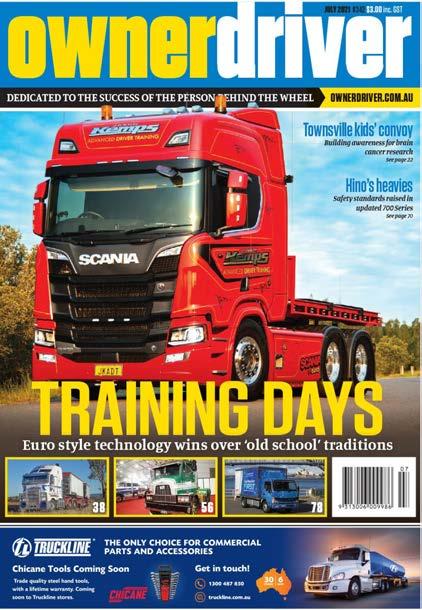






We are a family owned business that has been in the Western Australian Agricultural industry for over 80 years. We will be working with CBH over the next 5 years providing services to the local sites and Growers. We are looking for Hauliers, Subcontractors and Drivers to join our team. If you are interested, please get in touch with us. With our simple onboarding process and support incentiveswe could have you working before Harvest! Contact us at info@cropline.com.au or call our Operations Manager, Brody Sutherland on 0428 215 522. Head Office 110 Kurnall Road, Welshpool, WA 6106 PH: (08) 9356 9200 | F: (08) 9356 9400 cropline.com.au Are you a Grower, Regional Transport Provider or hold a MC Driver’s Licence? Subcontractors & Hauliers • Trailers can be supplied • Paid weekly • Low cost business insurance options • Provision of Ampol fuel card to take advantage of our discounted prices • Ongoing work across the Western Australian Wheatbelt and beyond • Assistance with relocation expenses Drivers • Attractive hourly rate • Family owned business • On the job training • Assistance with relocation expenses ow ne r dr iver Seek the right candidates with Owner Driver’s TRANSPORT RECRUITMENT PACKAGES * Print audience: CAB Audit, March 2021; Web: Google Analytics, average monthly visitors January-May 2021; Facebook: As at June 2021 For more information and package pricing contact Hollie Tinker on 0466 466 945 or at hollie.tinker@primecreative.com.au Reach over 100,000* quality candidates every month 26,471* Reach owner-drivers and small fleet operators every month via Owner Driver magazine’s dedicated Jobs section 87,739* Reach an average of 87,739 owner-drivers and small fleet operators per month via OwnerDriver.com.au’s dedicated Jobs page 40,000* Reach almost 40,000 on OwnerDriver’s Facebook page If you are interested in becoming part of our team & would like to discuss further, please email your contact details to, Info@fareytransport.com.au TOW OPERATOR OPPORTUNITIES Wagga based, Farey Transport & Trading is a Refrigerated Transport Co, we are a long-standing, well-established family business specialising in providing quality, reliable and dedicated transport services to our clients. We are seeking Tow Operators to join our professional team providing transport services of FMCG’s to our customers throughout NSW, Victoria, South Aust & Queensland. We offer; • A positive & supportive working environment • Excellent payment terms & conditions • Ongoing consistent Km’s • Excellent Km rate • Single Trailer work only • Runs are scheduled to ensure compliance with NHVL • Fully maintained trailers • Reliable Prime Mover required • Covid 19 compliant for all states • Understanding of Chain of Responsibility (COR) • BFM Accreditation would be an advantage • Customer focused • Strong work ethic All relevant insurances; Public liability, Carriers liability (marine), Comprehensive Motor Vehicle &Trailer in Control & Work cover insurances Est 1989
FOR
THE OWNER-DRIVER
Frank Black
Do-it-yourself risks
A few words of warning for anyone trying to save a few bucks by doing their own maintenance
Truck maintenance and repairs are an unavoidable part of the industry, but with low rates and no real means to support cost recovery, many owner-drivers can find themselves between a rock and a hard place.
Recently with my own truck out of action for a week for repairs, and a friend reaching out for help in what could have been a horrific situation, it highlighted the above situation that operators can find themselves in.
In most situations I do most of the work on my truck myself, not only because it was my former trade but also because, like for so many of us, margins are tight and it helps to alleviate some of the financial pressure.
But not all owner-drivers are fortunate enough to have these skills to fall back on.

We all know a safe, well-maintained truck should be our first priority. We all want and endeavour to keep our equipment in top condition, it’s our lives, other road users lives and our livelihoods on the line if it’s not. But with the constant squeeze of poor rates and no regulatory support to ensure we can recover costs with every job we agree to, we can find ourselves under immense pressure to make ends meet. That drives some to take short cuts that could lead to deadly situations.
Even though it should be the most important priority of our businesses, good quality truck maintenance can be one of the first things to drop off when times are tough.

INCORRECT ADJUSTMENT

Again, as mentioned earlier, a mate of mine reached out for help – luckily. He had tried his hand at adjusting his brakes himself, but he did so
incorrectly. Not only did this make the brakes ineffective, but it could have caused them to become inoperative altogether.
The impact of an incorrect adjustment as you can imagine can be deadly.
Luckily my mate had enough in the brakes to bring his truck to a stop. But if he’d been in an emergency situation he and anyone around him would have been in serious trouble.
He called me when this happened and I was able to talk him through the adjustment – but I warned him not to attempt any repairs he is not competent in that could compromise safety.

Unfortunately, this type of situation is only one of the dangerous consequences of tight margins that happens. It is not an uncommon occurrence for owner-drivers or small fleet operators to get repairs done on their vehicles, but then struggle to pull together enough money to cover the cost of repairs.
I know of garage owners who at times have had to hold vehicles, because people just can’t pay their bills.
CATCH 22

Unsustainable rates have a flow-on effect, not only to owner-drivers and operators, but the repair shops, garages when fuel accounts can’t be met, and also others that supply or service our industry and those relying on us to transport their freight.
It’s a ‘Catch 22’ situation – if you’ve got a broken truck then you can’t make a living, but if you’ve got no money to pay the bill, then you don’t have a truck. It’s a sobering situation that too many people in our industry know and fear.
I’ve even heard stories that some people have been so desperate that they’ve asked mechanics to sign off on defects without fixing them properly because they just can’t afford the repairs, but they need to somehow make a living. Obviously the request was immediately declined and the operator sympathetically but necessarily had to show them the way out.
It doesn’t bear thinking about there being trucks on the road with known defects. That impacts all of us.
As much as we may judge those drivers, and of course we never want to share the road with someone driving a faulty truck, we must remember that the root cause of this problem starts with cost cutting at the top of supply chains.
To operate safely and professionally, we must be paid viable rates. All roads lead back to a broken system in urgent need of long overdue reform.
We’ve made some great strides this year towards industry reform, but we need to keep our finger on the pulse.
We all need to get behind the recommendations of Senator Sterle’s inquiry , and put pressure on the Federal Government commitment to lift standards, to ensure we can recover our costs, and operate within a safe, sustainable and viable industry.
78 DECEMBER 2022 ownerdriver.com.au
FRANK BLACK has been a long distance ownerdriver for more than 30 years. He is a former long-term owner-driver representative on the ATA Council.
“They just can’t afford the repairs, but they need to somehow make a living.”
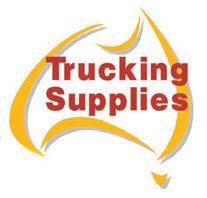
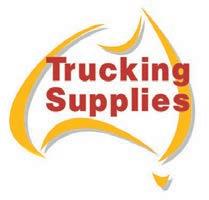
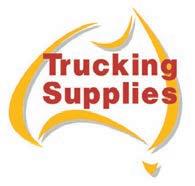

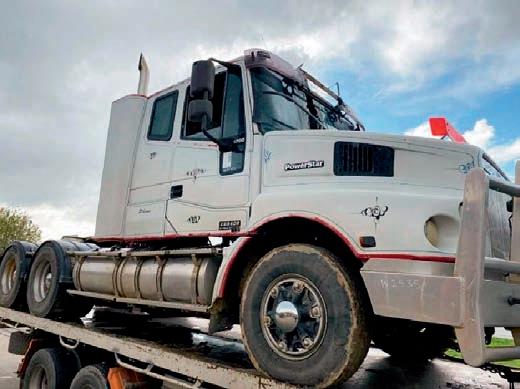
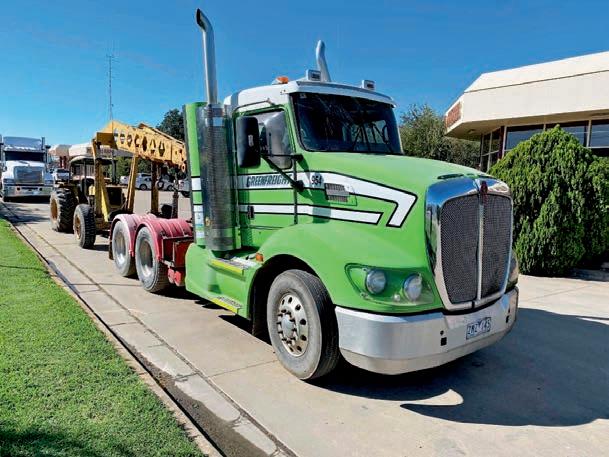


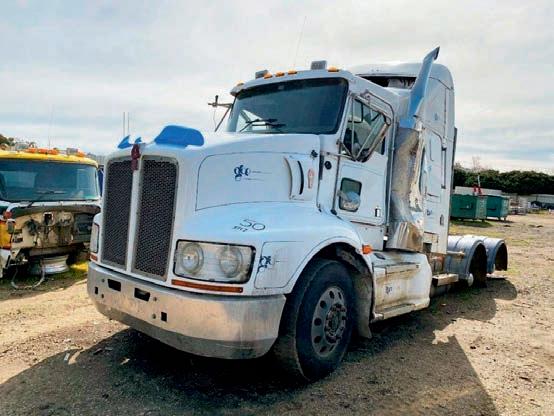

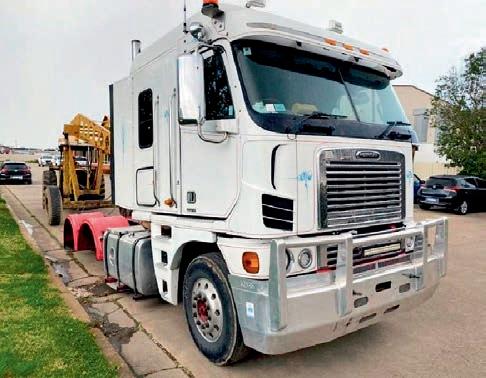
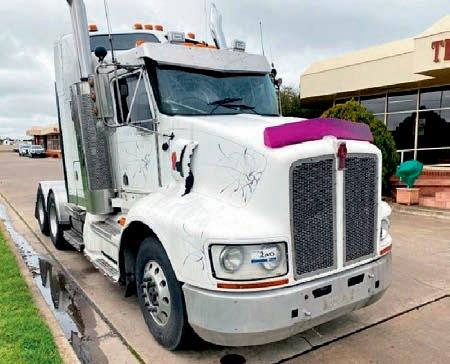
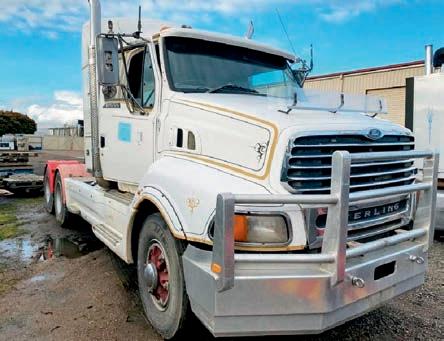
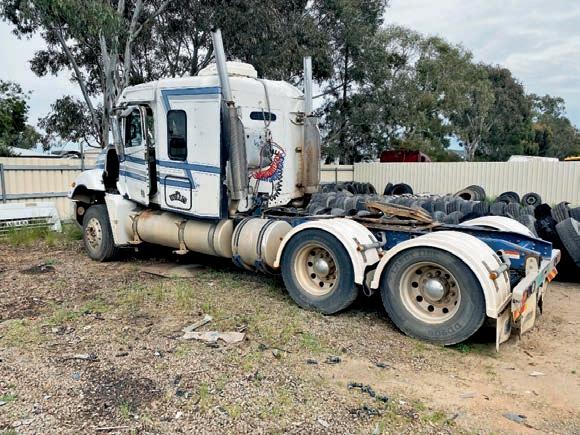
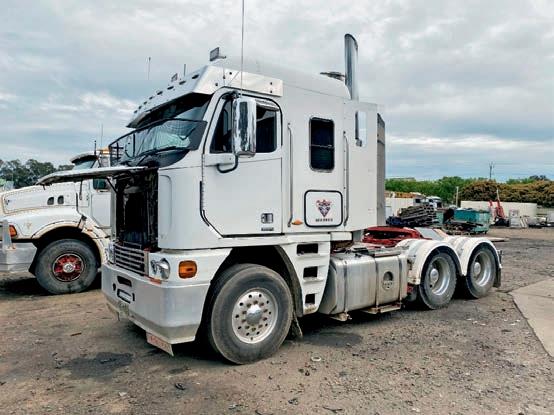
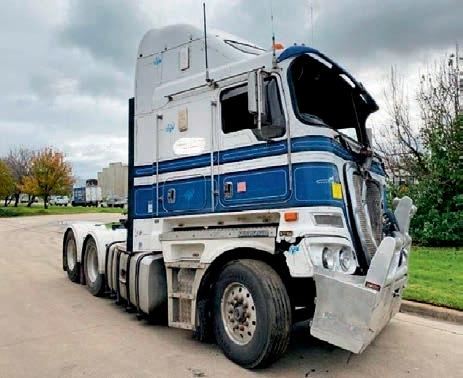
A TRUCKING SUPPLIES TRUCKS FOR WRECKING WAGGA WAGGA Ph: (02) 6925 8888 Fax: (02) 6925 8889 334 Copland St, P.O. Box 2373, Wagga Wagga, NSW 2650 Web: truckingsupplies.com.au TRUCK DISMANTLERS Email: tsenquiries@truckingsupplies.com.au WEBSITE UPDATED DAILY truckingsupplies.com.au OWD-FP-5011320-B MDL 19571 MVRL 24428 IVECOPOWERSTAR6700 2004,CURSOR13ENGINEPARTS ONLY,AUTOGEARBOX,MERITORRT46-160DIFFSONHAS,ALUMINIUM BULLBAR,CAPPARTS,HYDRAULICS.WRECKING.W2535. TA1149025. POA KENWORTHT403 2012,daycab,Cumminsegr, RTLO18918gearbox,MeritorRT-46160diffsonairglide 460,cabparts,Alcoas,wrecking.W2523. TA1133288. POA MACKQUANTUM 2001,PRIMEMOVER,E-TECH470,18SPEEDGEARBOX,MERITOR RT46-160DIFFSONHAS,ALCOAS,CABPARTS.WRECKINGW2534.w2534. TA1144024. POA FREIGHTLINERARGOSY 2010,Detroit14LEGRengine,RTLO20918AS3 gearbox,MeritorRT46-160diffsonairliner,cabparts,fueltanks, alcoas.Wrecking.W2527. TA1137354. POA KENWORTHT408 2008,PRIMEMOVER,CUMMINSISXEGRENGINE,18 SPEEDGEARBOX,EATONDSH40DIFFSONAIRGLIDESUSPENSION, KENWORTHT610SAR 2020,CumminsX15Engine.RTLO20918AS3 Gearbox,MeritorRT46-160diffsonAirglide460suspension,Jost JSK37CZWGreaselessturntable,Brevinibulkfeedpumpsystem.POA. w2532. TA1144038. POA FREIGHTLINERARGOSY 2010,DETROIT14LEGRENGINEPARTSONLY, RTLO20918BGEARBOX,MERITORRT46-160DIFFSONAIRLINER SUSPENSION,CABPARTS,ALUMINIUMBULLBAR,WRECKING.W2538. TA1149028. POA KENWORTHT408 2008,CumminsEGRengine,RTLO20918Bgearbox, SpicerRT46-170diffsonairglide460,cabparts,fueltanks,alcoas. Wrecking.W2528. TA1137355. POA FORDHN80LOUISVILLE 1997,CUMMINSN14-525HP,18SPEED GEARBOX,MERITORRT46-160DIFFSONHAS,ALUMINIUMBULLBAR, HYDRAULICS,TUBELESSRIMS.WRECKING.W2536. TA1149026. POA FREIGHTLINERC120 2004,DETROIT14LENGINE,RTLO20918B GEARBOX,RT46-160DIFFSONAIRLINERSUSPENSION,CAB PARTS,ALCOAS,HYDRAULICS.WRECKING.W2537. TA1149027. POA FREIGHTLINERARGOSY 2004,CATERPILLARC15ENGINE, RTLO20918BGEARBOX,MERITORRT46-160DIFFSONAIRLINER SUSPENSION,ALLOYBUMPER,CABPARTS.WRECKING.W2539. TA1149029. POA KENWORTHK200 2011,CumminsEGRengine,RTLO20918B gearbox,MeritorRT46-160diffsonairglide460,cabparts,alcoas, hydraulics.Wrecking.W2529. TA1137356. POA
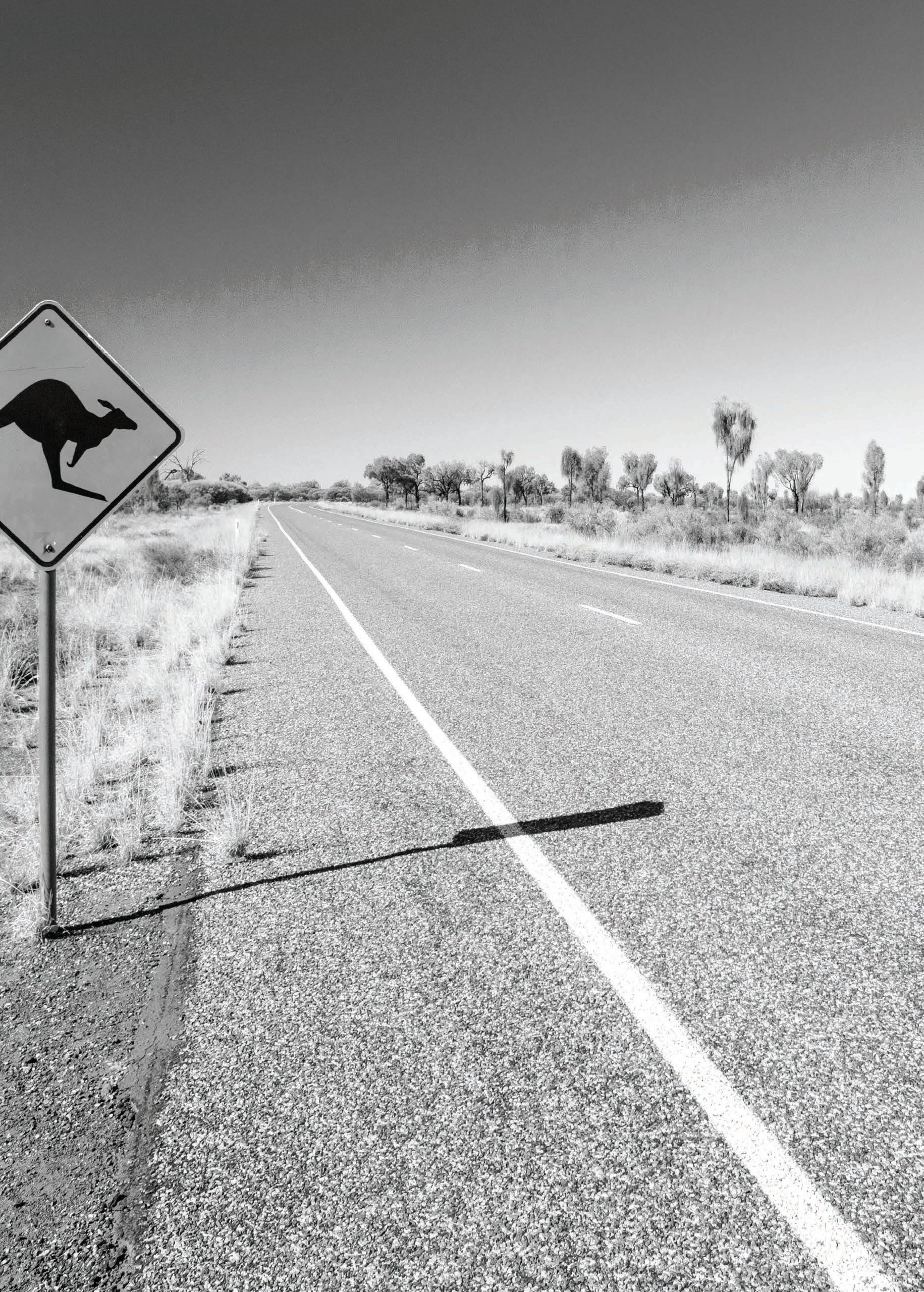

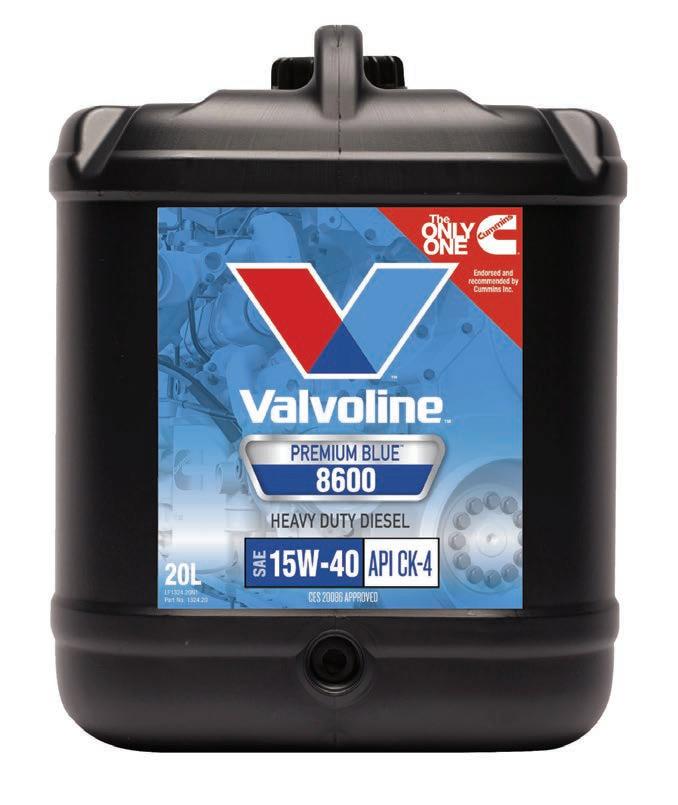

GO FURTHER. SPEND LESS. Extend Cummins X15 Euro 6 service intervals up to 80,000 kms* with Valvoline Premium Blue™ 8600. To purchase your Cummins Valvoline Premium Blue, call 1300Cummins (1300 286 646) or scan the QR code to view our X15 Series brochure. Valvoline Premium Blue™ 8600 oil uses the latest generation additive technology for enhanced engine deposit protection, oxidation and sludge control, and provides superior engine cleanliness over the oil drain intervals – which can be extended up to 80,000 kms*. Allowing the next generation of Cummins heavy duty engines to truly go further. *Terms and conditions apply. Check owners’ manual before use. Scan QR code for more details.










































































































































































































































































































































































































































































































































































































































































































































































































































































